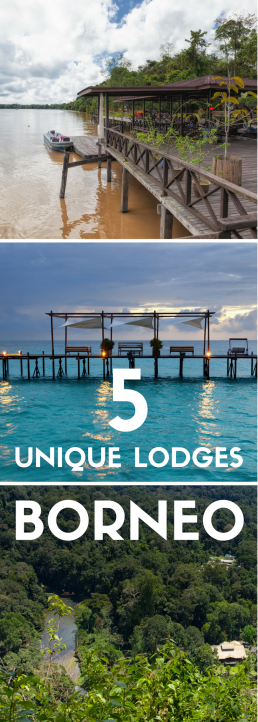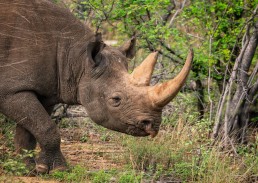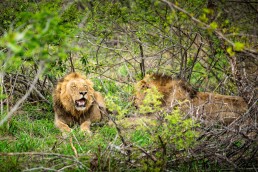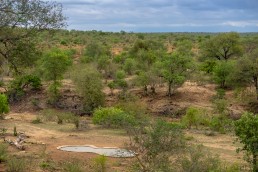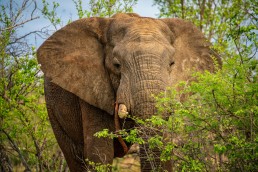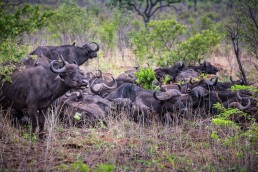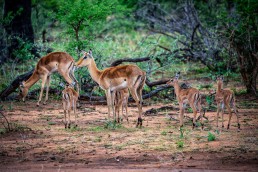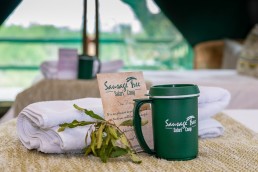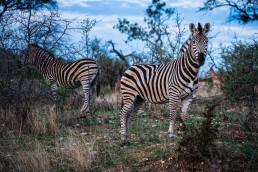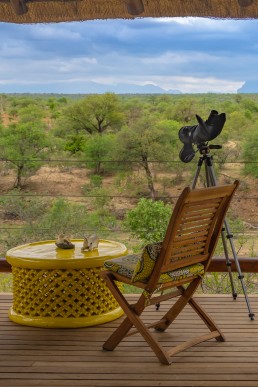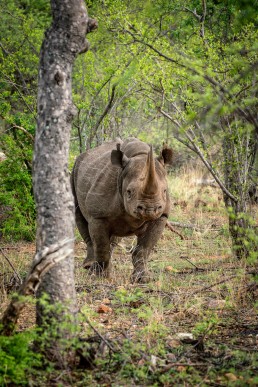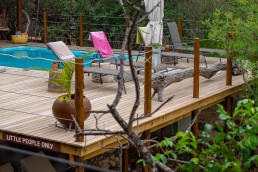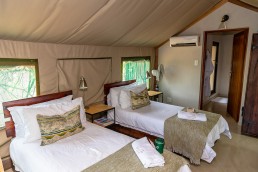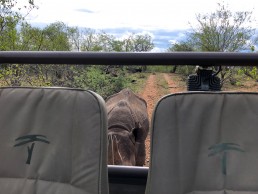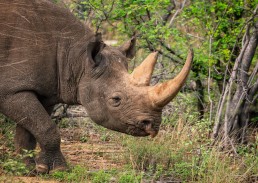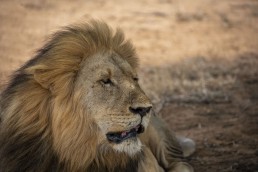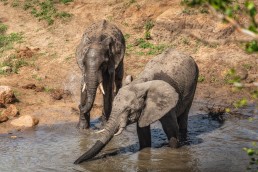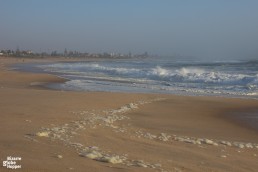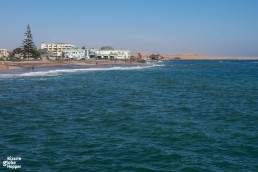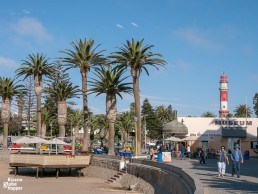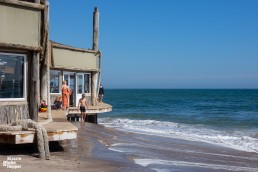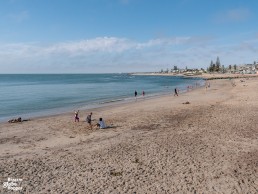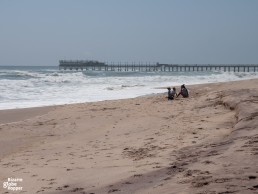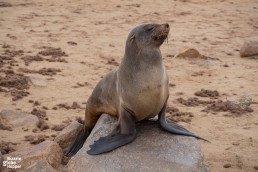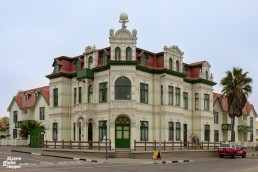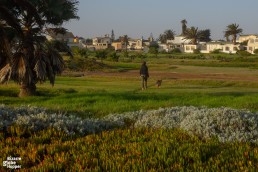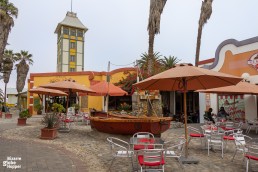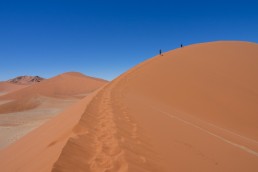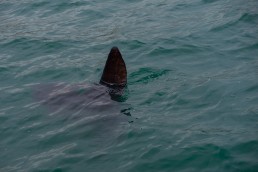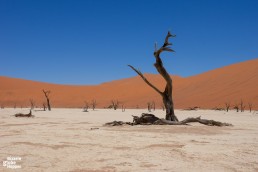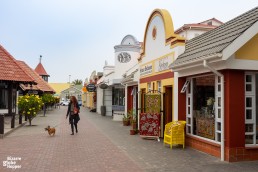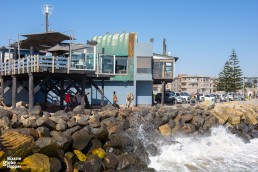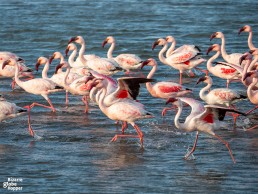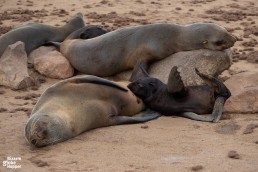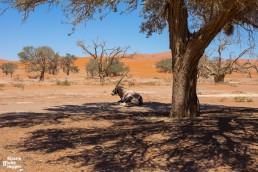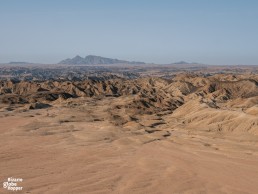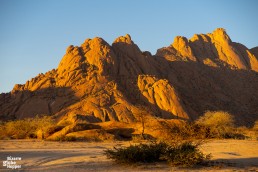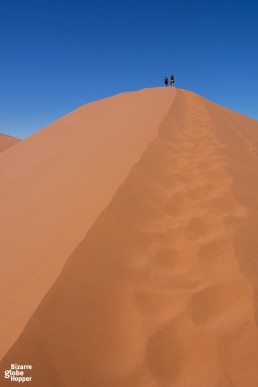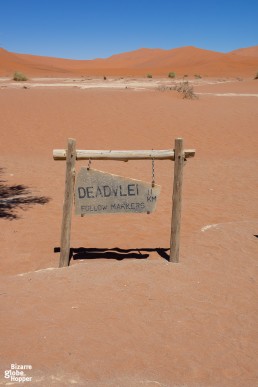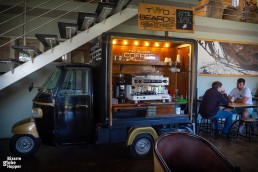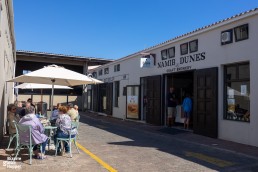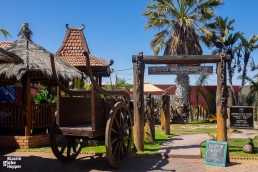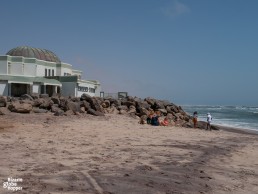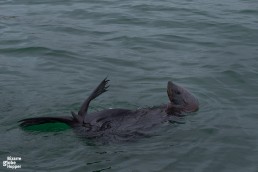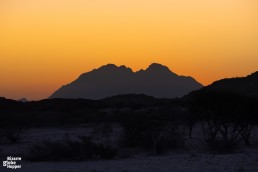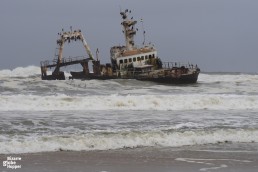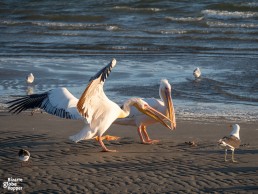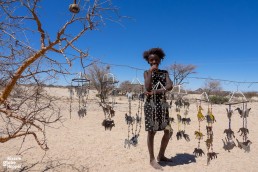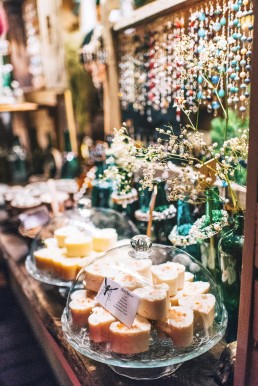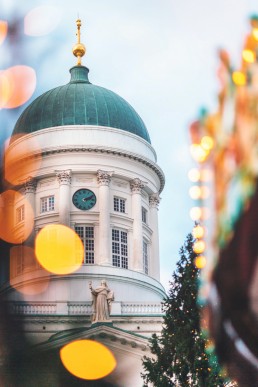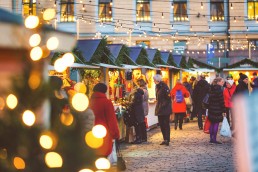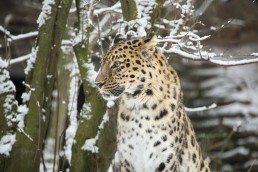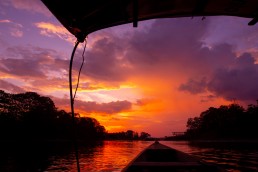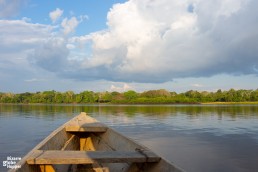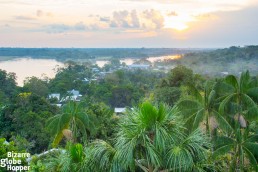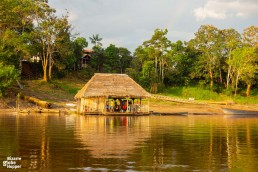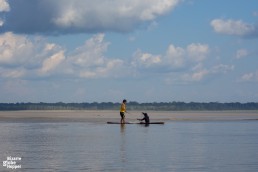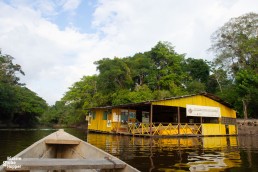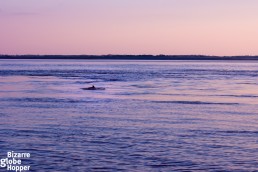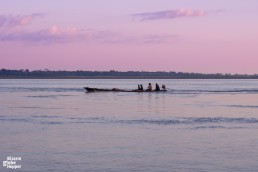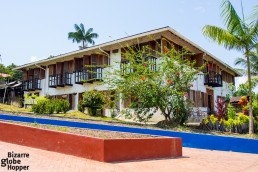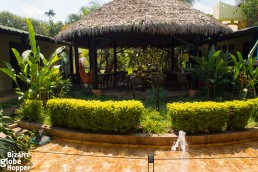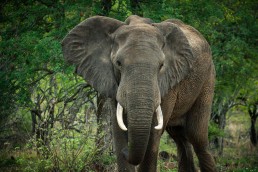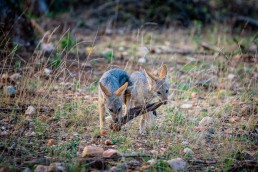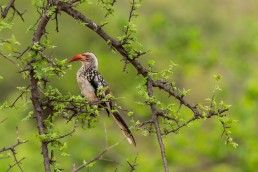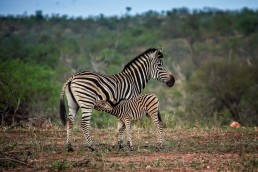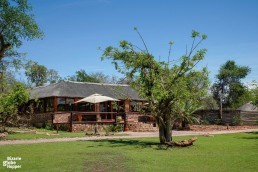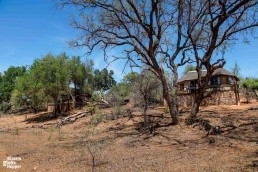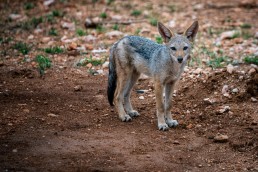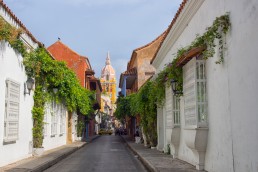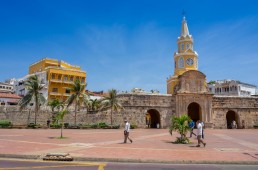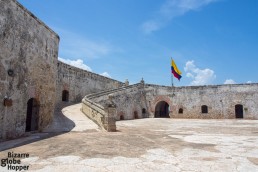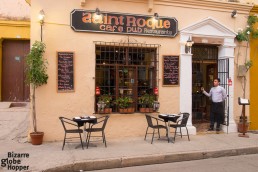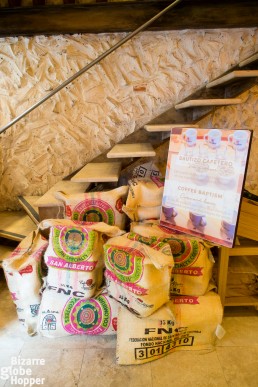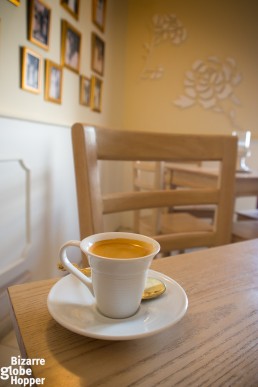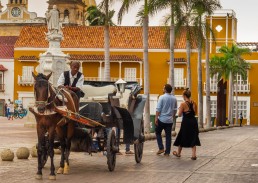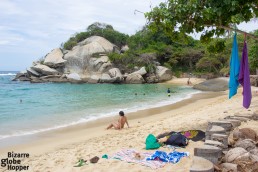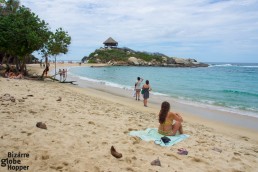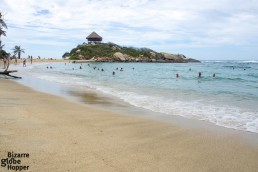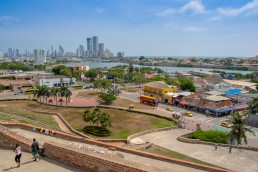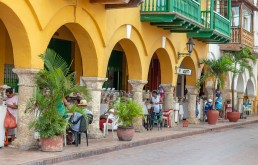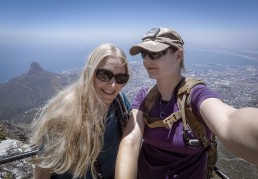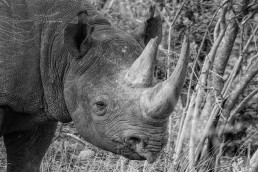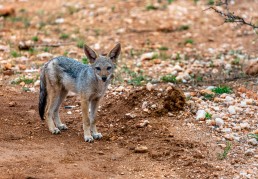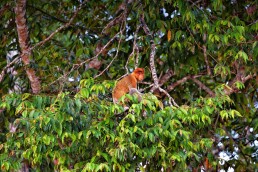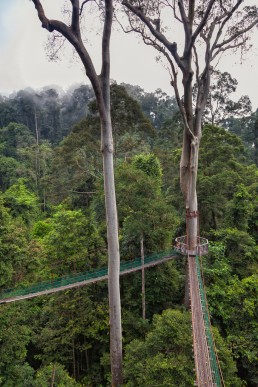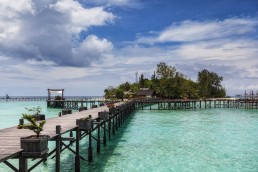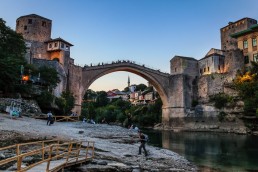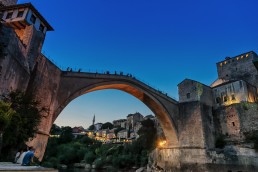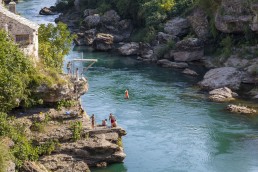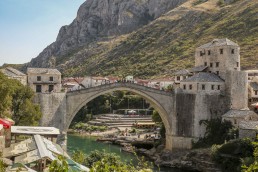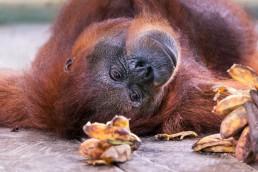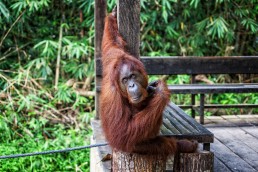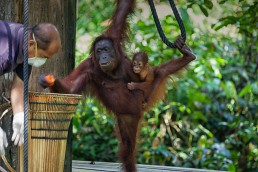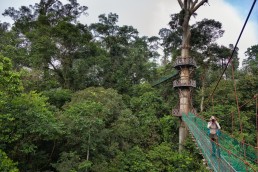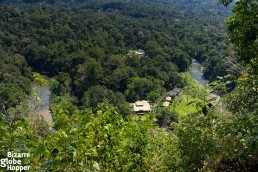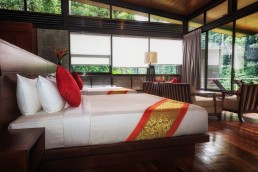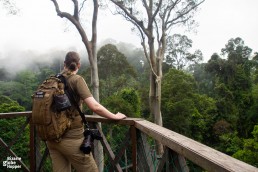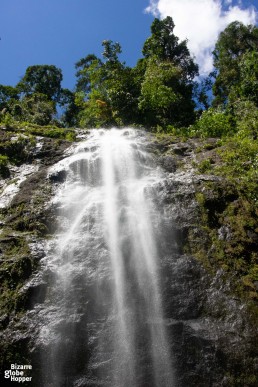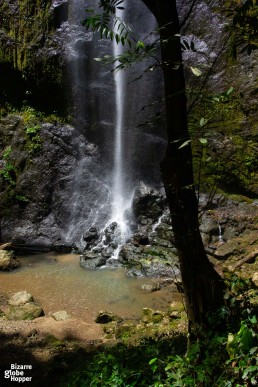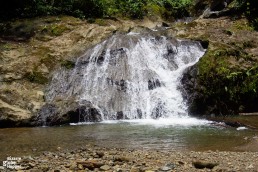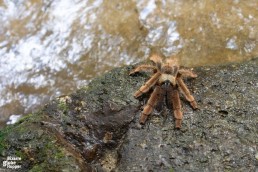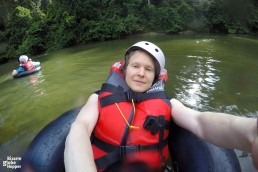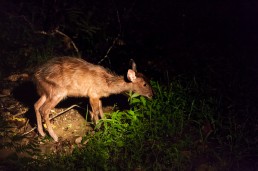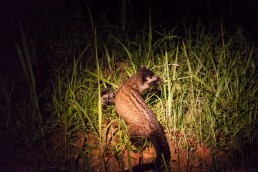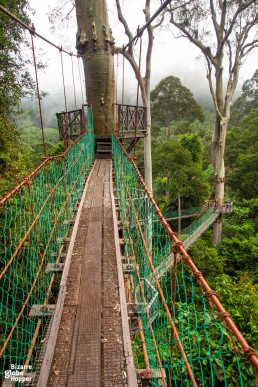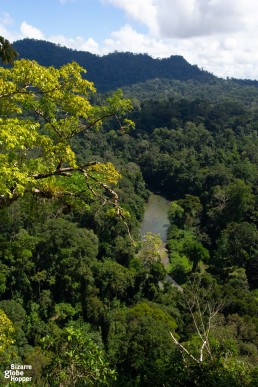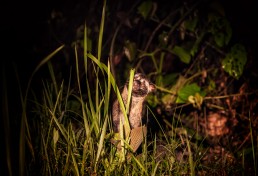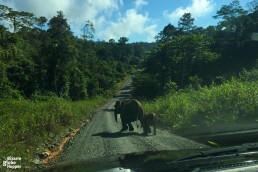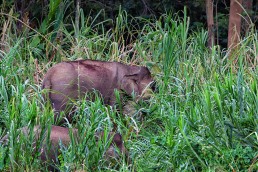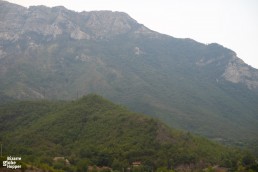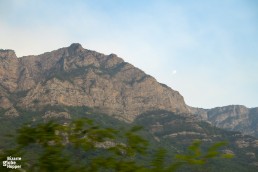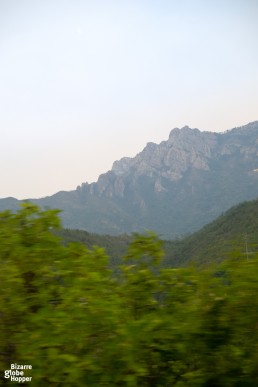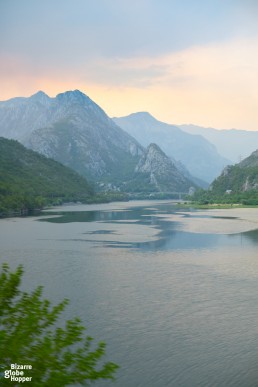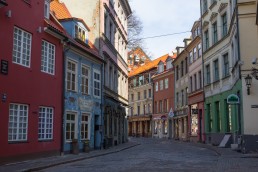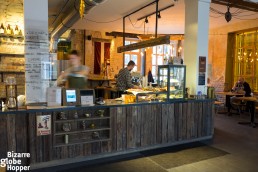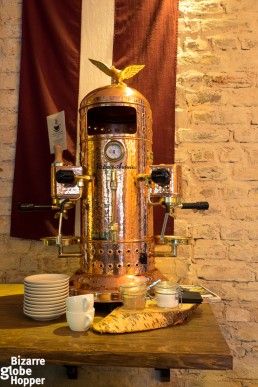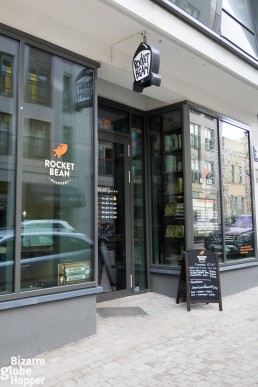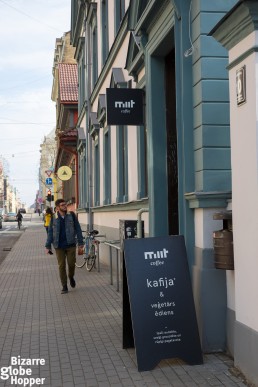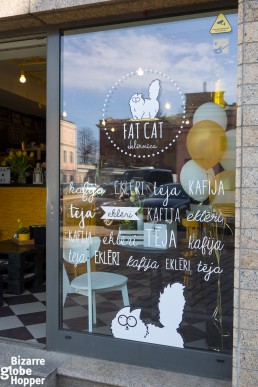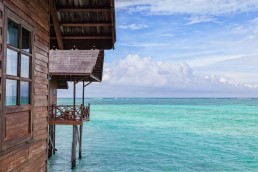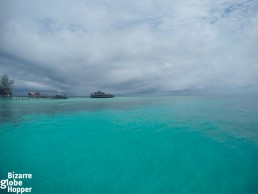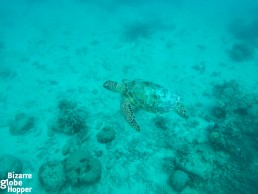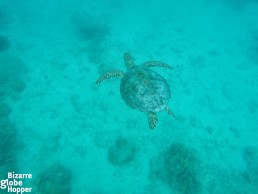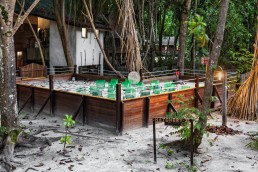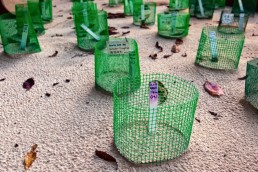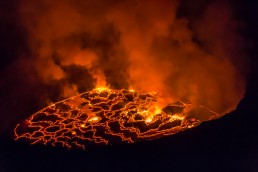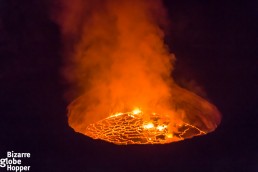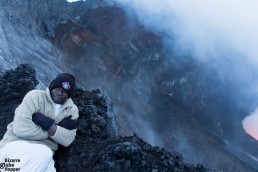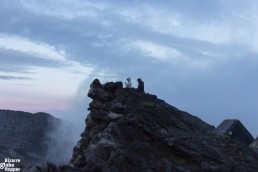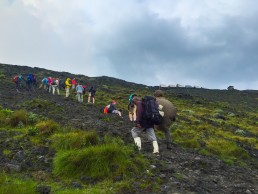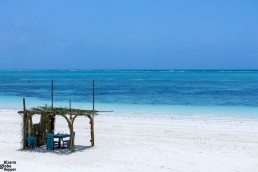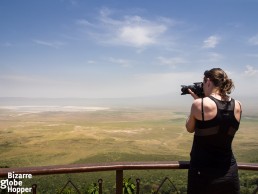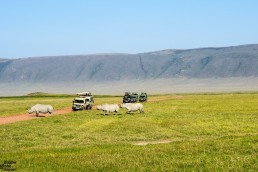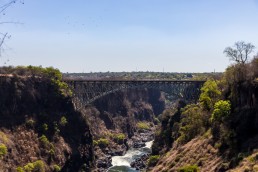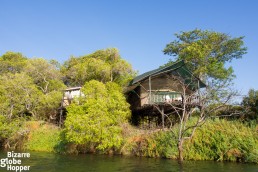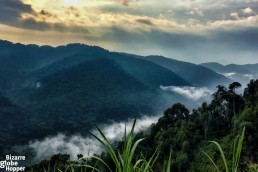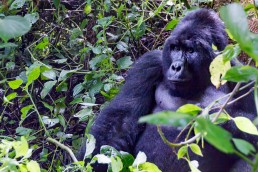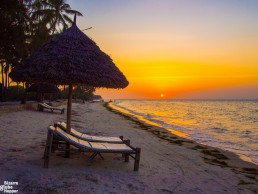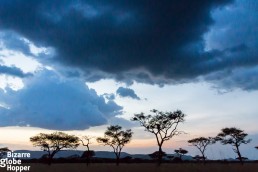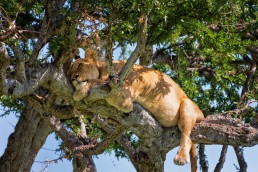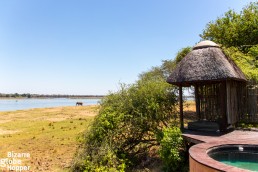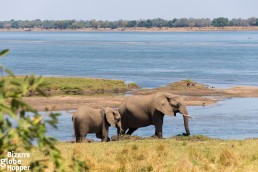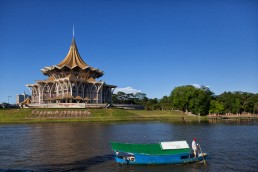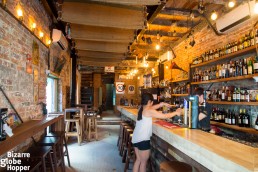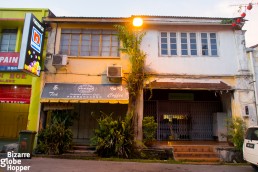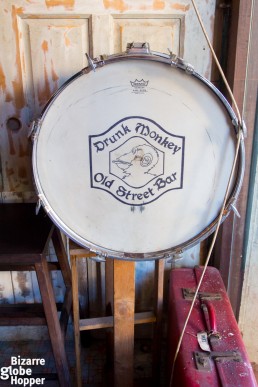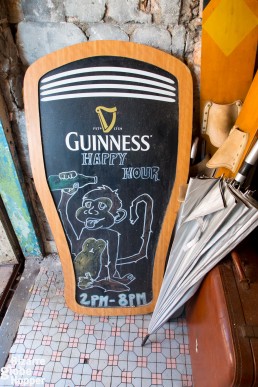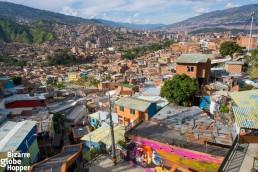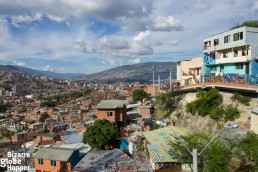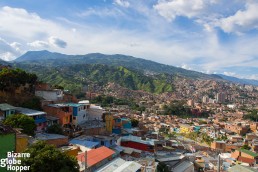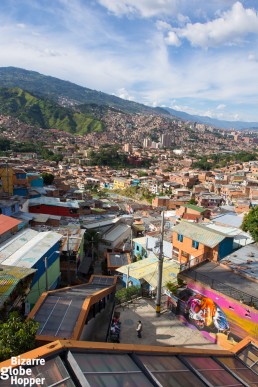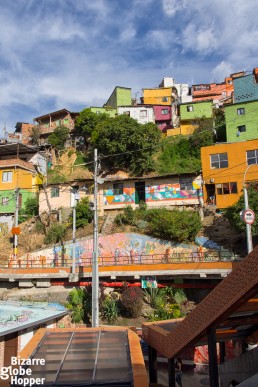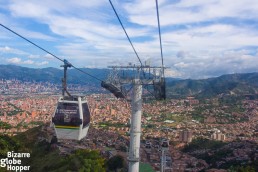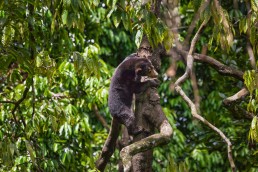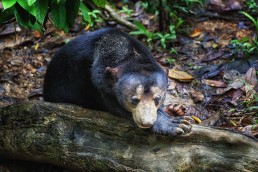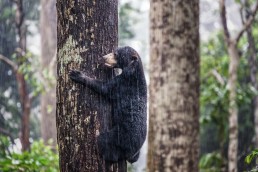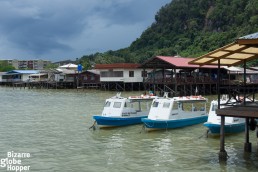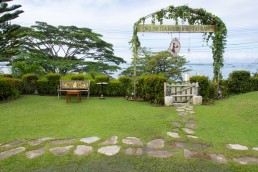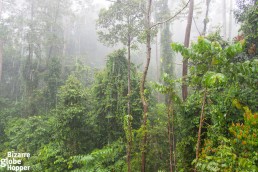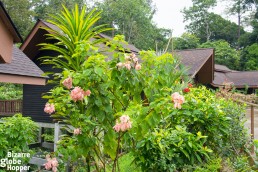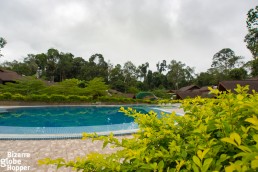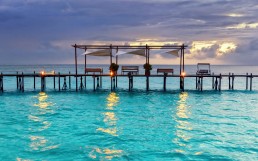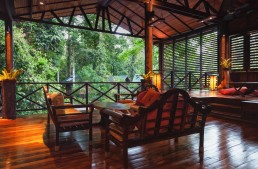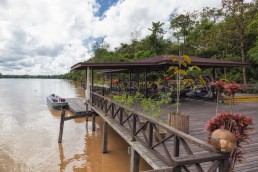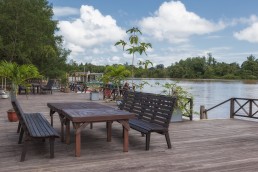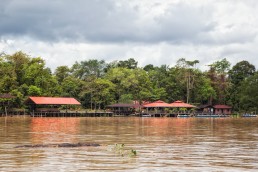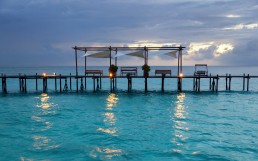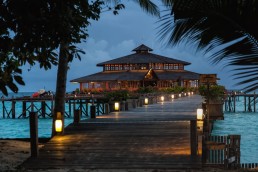Greater Kruger National Park vs. Kruger National Park: Key Differences in Safari Experience
When planning a South African safari, the first question is often: Kruger or Greater Kruger National Park? What are the key differences between the public sector of Kruger National Park and the private reserves belonging to the Greater Kruger National Park, when it comes to safari experience as a whole, price, and the authenticity? Let’s compare safaris in Greater Kruger vs. Kruger National Park – and find the best safari destination for you!
If you’re planning your first safari in South Africa, the terms might sound confusing. Thus, we’ll shed a little light into the division of Kruger National Park and Greater Kruger National Park at first, and then compare them to the surrounding fenced private reserves.
This article has been last updated in March 2024. We’ve been traveling extensively and full-time in the Southern and Eastern Africa for the last 5 years (and before that yearly on guided safaris) and have visited both Kruger National Park and the Greater Kruger several times. We’ve actually spent months inside Kruger at a time, many times. Thus we like to see ourselves fit for the argumentation and this comparison between Kruger and Greater Kruger.
What is Greater Kruger National Park and How It Differs from Kruger National Park?
Kruger National Park is one of the most famous and largest national parks in Africa. Making things a bit confusing, Kruger National Park is often separated from Greater Kruger National Park, although sometimes also the latter is called Kruger National Park.
The term Kruger National Park (KNP) means the public sector of (Greater) Kruger National Park, which is owned and run by the South African government (SANParks). Kruger National Park covers around 20 000 hectares of protected land.
Greater Kruger National Parks (GKNP) refers to the privately-owned reserves bordering the public sector of Kruger National Park in which wildlife roams freely. There are no fences between Kruger and the private reserves belonging to the Greater Kruger National Park, hence the name. These over 20 private reserves add up to 180 000 hectares to the nature reserve, making it one of the largest game reserves in the world. You could think of Greater Kruger as a buffer zone between the core area of the national park and the nearby settlements, or as an expansion of the Kruger Park.
We’ll compare the safari experience in Kruger and Greater Kruger NP in detail later on, but here are the key differences in short. You can see the same animals in Kruger and Greater Kruger, as there are no fences between the reserves.
Safari in Greater Kruger vs. Kruger National Park: The Main Differences
- Self-drives in Kruger NP vs. guided game drives in Greater Kruger NP
- Crowded wildlife sightings in Kruger NP vs. private sightings in Greater Kruger NP
- Big government-owned lodges in Kruger NP vs. exclusive private camps in Greater Kruger NP
- Affordable camping and lodges in Kruger NP vs. luxury lodges in Greater Kruger NP
- Fenced camps in Kruger NP vs. fenced and unfenced camps in Greater Kruger NP
- Game drives inside the whole Kruger National Park (20 000 hectares) vs. smaller designated game drive areas in Greater Kruger NP (depending on the reserve and your camp/lodge)
What’s the Difference Between Greater Kruger National Park and Fenced Private Reserves – and Why Greater Kruger is Better for Safari?
Greater Kruger National Park is one of the biggest game reserves in the world. With 2 million hectares – or 20 000 square kilometers – Greater Kruger National is huge and has more large mammal species than any other African national park (there are 148 mammal species in Kruger National Park).
Only in large game reserves like Greater Kruger National Park or Serengeti, you can expect to see large herds of prey animals, such as wildebeest and zebras, and huge concentration of predators, such as tens of lion prides.
There are many privately owned, smaller fenced reserves also nearby Greater Kruger National Park. The main difference between small fenced private reserves and Greater Kruger is the amount of predators: you cannot have many big cats in a small fenced reserve or your predator-prey balance would suffer (imagine a small reserve full of hungry lions and no buffalos, zebras, or impalas to keep them fed).
Why Kruger National Park & Greater Kruger are together the Number One Safari Destination in South Africa
- Regular Big 5 sightings and ease of finding wildlife (also on self-drive safaris in Kruger NP)
- Steady predator populations and huge herds of prey animals, such as buffalos, gnus, zebras, impalas and other antelopes
- Good roads inside the park (main roads in Kruger NP are tar roads, also gravel roads inside the park are well maintained; in private reserves, you’ll do game drives in camps’ 4×4 vehicles, so roads don’t matter that much)
- Easy access: Four airports with daily flights and affordable shuttle transports from nearby big cities (Johannesburg is usually the best starting point)
- The most extensive array of budget, mid-range and luxury lodges in Southern Africa
- Campsites and picnic spots all around Kruger National Park – and in GKNP you can stop anywhere for a luxury picnic in the wilderness or have a bush dinner organised by your camp
- South Africa’s largest and most important national park
10 REASONS TO CHOOSE GREATER KRUGER NATIONAL PARK VS. KRUGER NATIONAL PARK
The title tells our stance: we recommend Greater Kruger National Park over the crowded and commercial Kruger National Park – especially for the first-time safari. We’ve explored both options thoroughly during our last five years in Africa: we’ve also spent many months camping and self-driving inside Kruger National Park, and we love Kruger, but we still recommend Greater Kruger for anyone looking for the best possible safari in South Africa. Why? Well, the answer is long, so we’ll elaborate our opinion below through 10 reasons to pick Greater Kruger over Kruger National Park.
1. No Self-Drives in Greater Kruger National Park – It’s a Bliss!
Lack of self-driving tourists is one of the best selling points for private reserves of the Greater Kruger National Park. When you’ve visited Kruger National Park, you’ll understand why. The sheer volume of visitors, and especially nonchalant self-drivers breaking the rules all the time, makes visiting Kruger National park a rather chaotic and stressful experience. I’ll discuss this more in-depth in the next chapter.
Is the Comparison of Kruger and Greater Kruger National Park All About Guided Safaris vs. Self-Drive Safaris?
Many tourists see the decision between Kruger National Park and the private reserves as choosing between self-drive or guided safari, but there’s much more in the game here.
Let’s start from the simple rules. Self-drive safaris are not allowed in the private reserves of the Greater Kruger National Park. So, if you want to do independent self-drives, Kruger National Park is your only option. In the Greater Kruger reserves, private cars are only allowed to drive between the gates and lodges.
Guided Safari in Kruger National Park – Yes, It’s Possible!
SanParks offers game drives in most of the camps in Kruger, so you can book affordable guided morning, afternoon or full-day game drives even if you’re otherwise self-driving. Please note that SanParks’ game drives are group tours and they’re usually full: depending on the number of participants, the driver guide takes a smaller safari vehicle (like Toyota Hilux) for up to 6 guests or even a big truck for up around 20 participants. Although the ranger guides are trained and qualified field guides, they are more rangers than safari guides and the level of guiding doesn’t usually match the dedication, art and craft of guiding you can find in many private game reserves. You can check out and book SanParks’ game drives in Kruger on their website here.
Also many tour operators offer guided safaris in Kruger National Park: you can book either a day trip or a multi-day safari in Kruger National Park. It’s even possible to stay outside the gates of Kruger and explore the national park on long full-day game drives.
So, you can definitely do Kruger National Park safari with a trained wildlife guide and a driver, who will make sure that you’ll see as much wildlife as possible. Sometimes a guided Kruger day tour is combined with a Greater Kruger safari itinerary, too. You can also check out our experience on 3-day guided Kruger safari here.
2. Private Wildlife Watching with Professional Guides vs. Sharing the Sightings with Many Cars Lacking the Game-Viewing Etiquette
Private reserves of the Greater Kruger National Park limit the number of vehicles at each wildlife sighting. Many times, your car is the only one at a sighting – and there should never be more than one other car.
When professional guides are in charge, also the animals know that humans mean no harm, so they tolerate the open safari vehicles and let them approach them without changing their natural behavior. The safari experience gets better, smoother, and deeper. Wildlife photography gets easier, angles are better, and results more interesting.
The predator sightings inside Kruger National Park can be chaotic, noisy, and rather stressful (for tourists and animals alike). Unfortunately, in the public sector of Kruger National Park, many self-driving tourists don’t obey the rules and harass the animals – or other cars.
In Kruger proper, there can be easily over ten or twenty cars at one lion sighting, when you might need to wait for half an hour even to see the lion at a distance. We’ve left many lion sightings without even taking photos, as we would have needed to wait too long to get a decent shot. For a photographer, those kind of “mega sightings” turn into a nightmare: you can’t get the car properly positioned for good shots because off-roading is not allowed in Kruger NP and other cars are always on your way. You’ll only get frustrated because you miss the good frames and situations because of all the mayhem around you. Sometimes visiting Kruger feels like you’re in big zoo.
We’ve also seen outrageous attitudes, drivers shouting to each other at sightings and even hooting to get through (thus scaring off the animals), and people getting off the vehicles against the rules, causing dangerous situations. Please always adhere to the park rules and regulations and report the rule breakers (by calling to Kruger’s Emergency Call Centre, 013 735 4325).
In private reserves, self-drives are not allowed, which limits the number of cars on the roads and especially at the sightings. Many times it feels that your safari party is the only one exploring the vast wilderness. In bigger reserves or Greater Kruger, you can sometimes drive for hours without seeing other cars. That’s a proper African safari, if you ask us.
According to our experiences, wildlife sightings are always better in private reserves, as they are more serene and everyone respects the nature and animals. For us, that’s the true nature of African safari.
3. Offroading for the Best Wildlife Sightings vs. Staying on Marked Roads
Offroading is prohibited in Kruger National Park but allowed in the private reserves of Greater Kruger NP.
Offroading is a photographer’s best friend on a safari, as you can get closer to the wildlife and find the best angles to take photos (against the light, side light, backlight; facial shot, profile, action shot for a leopard descending a tree or a proper predator-prey chase; a photographer’s wish list can be endless and your guide can position the car according to your likings).
It’s also always exciting to leave the road behind to follow wildlife footprints deeper into the bush to track rhinos or big cats that you wouldn’t have been even able to see from the road. So if you see a lion with binoculars in Kruger NP, you cannot venture off-road to track it (like in Greater Kruger). In Kruger NP, you must stay on the roads and inside your vehicle.
Most lodges in private reserves use 4×4 open safari vehicles, where you can be closer to nature and its animals. The thrill of seeing the animals just beside the car without any physical boundaries never gets old!
4. Professional Safari Guides Fill You with Safari Knowledge and Can Find Animals That You Wouldn’t
A great safari guide makes all the difference, even if you’ve already been on countless African safaris like us. There’s always more to learn about wildlife behavior, little creatures, plants, even ants. Self-drives in Kruger can be epic fun, but nothing beats the educational aspect of a good guided game drive.
Professional wildlife guides are skilled in tracking down animals, which makes the safari experience much more profound. No matter how good you’d think you are in finding animals, trained safari guides are always better. We would have missed some of the best safari experiences in our lives if we had been driving in the bush on our own. And please note that by far we have been self-driving allover the national parks in Southern and Eastern Africa for the last five years!
Passionate safari guides in private reserves also love to tell you more about tracking and animal behavior, so you’ll start to see the surrounding bush in a different light. If the vervet monkeys are screaming, there might be a leopard nearby. If baboons go berserk, it’s usually a lion. Impalas and other antelopes snort when they notice a danger, be it a lion, leopard, wild dog, or hyena clan. Also zebras snort, but they also neigh and bark, different sounds signal different things. Bird warning calls reveal many many predators and some birds can also have a symbiotic relationship with them: for example, if you follow a honeyguide (bird), you might find one of our favorite predators, a honey badger!
5. Walking Safaris and Other Activities in the Wilderness
Private camps and lodges in Greater Kruger Park offer many exciting activities that are not available in Kruger NP. You can also usually also get private safaris, if you wish (in luxury lodges it can be a default not to mix guests in the same car).
Daily morning and evening game drives (also called sunrise and sunset drives) are usually included in the all-inclusive safari packages with a bush breakfast and sundowners with snacks. During the picnics, the guide will set up a table, and you can stretch your legs while enjoying the views (and sometimes distant wildlife sightings, for example, having morning coffee surrounded by a herd of elephants or zebras).
These exclusive picnic moments in the middle of wilderness make you feel like the only people inside the park. Sundowners in the bush are among the safari highlights, as you can admire passing animals with a cold drink in your hand while taking photos of the magical African sunsets.
Many camps in Greater Kruger National Park offer walking safaris that can be tailored into your interests (birds, plants, traditional bush medicines, elephants, etc), boat safaris (Olifants River in Balule Nature Reserve), visits to the nearby wildlife centers, hot air ballooning and micro flights, longer hikes, and cultural activities.
In Kruger National Park, self-drive safaris (and third-party guided safaris) are not allowed at sunrise, sunset, and after dark. The only option inside Kruger NP is to join guided sunrise, sunset, and night drives that are organized by SANParks and led by park rangers. Those drives are usually crowded, the rangers and park officials are not comparable to the guides in private reserves, and you’re not allowed to have breakfasts or sundowners out in the wilderness like in private reserves of Greater Kruger. Same goes with the walking safaris: you must book with SANParks and join their group activities.
6. Finding the Big Five in Peace vs. “Ferrari Safaris”
Kruger National Park offers unequaled diversity of wildlife and astonishing 20.000 hectares of protected land to track the animals – there are always predators and big game somewhere. However, with so much land to cover, game drives in Kruger National Park often become “ferrari safaris”, as the guides nickname them. It means that you will spend a lot of time driving on tar roads as fast as you can to get from one sighting to another.
Guides share wildlife sightings over radio, which means that after someone has found a lion, tens of cars race with each other towards the poor lion. At the sighting, not all guides follow the rules, blocking the animals from other vehicles. Many tourists forget the rules, as well, shouting “lion, lion” or otherwise scaring off the wildlife.
Many tourists spend only one day in Kruger National Park, thus their guides try to catch the whole Big Five within 5-8 hours of a guided full-day safari. It’s quite understandable that everyone wants to see the Big 5 at least once in a lifetime, but you might not want to use your own safari days driving like a crazy from a sightings to another and only spending a couple of minutes at each sighting to push forward to the next lion. Needless to say, ferrari safaris are not a great match for a photographer and they get old really fast for any nature lover.
So, bigger is not always better. Go for the quality, choose the private reserve (check the number 2 on our list) and maybe visit Kruger on a full-day safari.
7. Costs: Is Greater Kruger Safari Always (Much) More Expensive Than Kruger National Park Safari?
We want to bust the common myth: private reserve safaris are not necessarily more expensive than self-drives or guided safaris in Kruger National Park. Of course, private reserves offer luxury safaris, but there are also affordable lodges ranging from “lower luxury” to mid-range and even budget options.
To be honest, most lodges in Greater Kruger reserves are mid-range or luxury. Still, I’d advise comparing the costs of Greater Kruger all-inclusive safari and that of Kruger National Park (which comes with a rental vehicle or separately paid guided activities twice a day).
In Kruger National Park, you pay for the daily national park entry and conservation fee, daily meals, accommodation, and guided morning and night game drives if you’re interested to see the animals at prime time when they are most active. The costs quickly add up, although the price level in public rest camps is generally lower than in private reserves.
In private reserves of the Greater Kruger National Park, most camps have all-inclusive prices that cover all the game drives (morning and afternoon game drive, the latter can be extended into a night drive, too), additional activities depending on the camp (walking safaris or cultural tours), all meals (breakfast, lunch, multi-course dinner, afternoon tea with cake or snacks, bush picnics on game drives).
How to Get the Best Price for Greater Kruger Safari?
In general, lesser-known reserves of Greater Kruger National Park offer better value for money. For example, pick Balule Nature Reserve over Sabi Sand to get a more affordable safari.
Look at the map: Kruger National Park is surrounded with small private reserves. Search online for more info about the reserves and lodges, check reviews on TripAdvisor, and ask the right questions to find out if it’s your dream safari or not (check “how to find the right safari lodge” section below).
Go off-season: high season means highest prices. Shoulder and off-seasons bring tempting offers even to well-known reserves and luxury lodges. Note that most of the camps usually call the rainy season more commercially “the green season” or summer season. It’s not a bad time to visit Kruger or Greater Kruger: landscape is beautiful, migrant birds arrive, and you can still find great wildlife sightings, too (although it’s harder to spot animals through the lush foliage).
Check out our tented camp recommendation, Sausage Tree Camp, for the best price-quality ratio in Greater Kruger!
8. Seclusion: Private Safari Camps vs. Busy SANParks Rest Camps and Lodges
SANParks operated rest camps inside Kruger National Park are crowded, noisy, and busy. The atmosphere is like a summer camp for adults. Some of the bigger rest camps are like little villages with their own filling stations, restaurants, and budget-friendly accommodation options from a campsite to tented camps, bungalows, and budget rooms.
Imagine big buses offloading crowds for coffee breaks, lunch, and dinner. Then picture hundreds of people staying in the camp through the night, either camping or in numerous bungalows, and suites, while some are partying and barbecuing and some (like us) prefer to sleep. The pools in rest camps are crowded, restaurants serve mostly bland (mainly buffet) meals, and customer service is rather tired, as are the facilities.
In private reserves, the lodges and camps are generally beautifully laid out in a tranquil setting. Many camps don’t have fences (see the next argument), which allows wildlife like elephants, zebras, impalas, and wildebeest to pass your accommodation. The whole safari experience is crafted around enjoying the wilderness and wildlife, like it should be.
9. Unfenced Camps = Wildlife in the Camps
Unfenced camps are the best part of staying in the private reserves of Greater Kruger Park: animals can roam freely through the camps. Depending on the camp and wildlife populations around it, you could see (and meet) zebras, impalas, wildebeest and other hooves, elephants, and even big cats within the camp’s boundaries.
For us, unfenced camps offer the real safari experience. It’s always thrilling to share the camp with wild animals. We’ve been stuck inside our safari tent, when a herd of elephants decided to eat just by the door, and have found fresh kills inside the camp in the morning. We’ve heard loud lion roars through the thin canvas walls of our tent after dark, and shared the excitement of tracking them on foot with a professional guide, witnessing two lions fighting over an impala kill in the middle of the camp. Afterward, we heard that the lions were right under our elevated luxury tent!
Although the idea of unfenced camp might sound scary, the private camps take the needed measures to make the unfenced safari experience safe. Usually, guides or rangers escort visitors to their tent and dinner after dark: it’s not allowed to walk outside without an escort in the evenings. Rangers patrol the camp’s boundaries, so they know where the animals are, and can alarm you well in advance to stay inside if there are dangerous animals close-by.
All SANParks-owned camps inside Kruger National Park are fenced, which is understandable, as they cater to huge masses of tourists with limited staff, and need to guarantee the security of visitors.
10. Exclusive Safari Experience in Private Reserves: What Does it Mean?
When comparing Greater Kruger Park to Kruger National Park, or any private reserves to national parks, people talk mostly about “exclusive safari experience” in private reserves. But what does that “exclusivity” really mean – and why should you invest in it?
For us, the key point is the limited number of people, camps, and cars – all discussed before. Possibility to go off-road and get better wildlife sightings are part of the exclusivity, as well.
Then comes the personal safari experience. National parks, like Kruger, cater to masses – and high level of service is not the strongest selling point in government-owned camps. In private camps, safari experience gets elevated and more personal.
Smaller groups mean better safari experience. Many private camps limit the amount of people in the vehicles so that everyone can have a good seat for wildlife viewing, whereas in Kruger National Park you could go out in a full TRUCK (yes, a truck, not a Land Cruiser).
Private camps can also group people according to their interests, so that birders can go in the same car and get a birder guide, whereas the first-timers can be grouped in one car to search for the Big Five.
Safari guides are usually better in private reserves than in national parks. Of course, things are not black and white, and that depends on individuals and camps. Generally, private camps employ highly trained professional guides from established wildlife schools and train their staff further. In many private camps, you will have both tracker/spotter and a guide – or a driver and a guide on your game drives.
When you’re staying several nights in a private reserve, your guide knows what you’ve seen and what’s left on your wish list and can tailor the game drives to your interests.
Private camps invest in little details to polish your safari experience. Imagine multi-course dinners under the blanket of stars at camp’s boma, while staring at the campfire and listening to lion roars or elephant rumblings. You might as well get a surprise bush dinner, when you are driven through the wilderness to a candle-lit setting in the middle of nowhere. At arrival, you’re greeted with a cold towel and welcome drink, and during game drives you’ll stop to enjoy drinks and snacks. There might be binoculars and wildlife books in your room, a private plunge pool, and a beautiful pool and lounge area right by the camp’s own waterhole.
Private reserve safaris can treat you with the ultimate luxuries – or they can offer just intimate safari experience with all the modern comforts, depending on your budget and likings. One thing is sure: the safari experience in Greater Kruger Park is more exclusive than in Kruger National Park.
After this detailed comparison, your next question might be, which reserve and camp to choose within the Greater Kruger National Park. Worry no more, we have picked one luxurious yet affordable private camp inside the Greater Kruger!
Sausage Tree Safari Camp: Greater Kruger National Park Safari Perfection
If you’re looking for an affordable, yet luxurious safari experience in Greater Kruger National Park, Sausage Tree Safari Camp will exceed your expectations. Their price-quality ratio and hospitality are outstanding for a South African safari lodge located in prime Big 5 reserve.
Sausage Tree Safari Camp combines a classic South African safari with an intimate, warm atmosphere that makes you feel right at home. Their location in Balule Nature Reserve contributes to the more affordable price range than, for example, safari camps in Sabi Sands, Timbavati, or Klaserie. To their advantage, the location is perfect: in the middle of the game-rich area filled with sought-after Big 5 animals, overlooking Drakensberg mountains at distance and with no other lodges in sight.
The guides of Sausage Tree Safari Camp are among the best we’ve encountered by far in Africa. Their stylish safari tents and delicious, creative dinners give you the taste of exclusive South African luxury safari, yet their prices remain surprisingly affordable. Our favorite treat: stunning sky deck lounge and pool overlooking Sausage Tree riverbed and waterhole where animals come to drink.
Intimacy at Sausage Tree Safari Camp means that they only have 5 tents and can accommodate at maximum 10 guests at a time. Exquisite meals are social affairs around same table or campfire in the boma. You will leave with new friends and fond memories. Many guests end up returning over and over again.
Classic African Luxury Safari Tents
Each luxury safari tent in Sausage Tree Camp has a private veranda overlooking the surrounding wilderness and its animals, indoor bathtub, and a beautiful outdoor shower if you don’t like to admire the clear South African starry sky while showering. You have plenty of privacy and all the modern comforts, such as air-con, heater, and tea/coffee making facilities.
Tented camp allows you to blend in with nature and lets the sounds of wildlife lull you to sleep. Oh yes, we were so tired after a full day of game drives that we had no problems to fell asleep to the sound of not so distant lion roars. At waking up, the roars were even louder, and one guest was lucky enough to see the pride from his tent.
Sausage Tree Safari Camp is fenced, but in a seamless way, so that you can feel safe while walking around the lodge area and still see wildlife just a couple of meters away from your tent.
Sustainable Eco-Lodge
We love the sustainable attitude of Sausage Tree Camp: water waits for you in the game drive vehicles in reusable glass bottles, and you’ll be gifted a thermos mug to use during the stay (and take as a souvenir if you wish). Tents have ecofriendly air-con, and many other little things tell how they conserve nature.
Wildlife Conservation Policies of Sausage Tree Safari Camp
Sausage Tree Camp and its staff are passionate about wildlife conservation. They’ve supported several conservation organizations, such as Save the Rhino International, and are currently supporting Black Mamba Anti-Poaching Unit, The Bush Babies Environmental Education Program, and Daktari Bush School.
As a Sausage Tree guest, you can provide supplies to Daktari Bush School via Pack for a Purpose initiative, and a portion of each stay is donated to Daktari. We’re publishing a separate article on our visit to Daktari Bush School very soon!
Outstanding Big 5 Sightings and Tracking Experiences
With the expert guide and tracker, we were able to see the whole Big Five within just a couple of days – and without any hurry and “ferrari safari” feel. We had fantastic rhino encounters, one involving a rhino hanging out at zero distance in the back of the car, just check out the mobile shot and story below!
We witnessed lions mating several times and learned to identify many fascinating bird and insect species. We offroaded to photograph huge elephant bulls up-close. We rejoiced with nature after the first rains of the season poured upon us, crossed newly founded rivers and admired white rings of star flowers blooming all at once, and watched Southern red-billed hornbills dancing on the branches in the oxygen-rich air after the rains.
On the game drives, we learned to pick up the signs, sounds, and footprints of animals. Our guide Matthew surprised us by jumping off the car to track rhinos, and our trackers Themba and Polite did the same for the lions. They were gone with their radiophones in thick bushes for a long while, but we found them alive and were able to track the animals, as well. Speaking about going out the extra mile!
Thrilling Encounter with a Bad-Tempered Black Rhino
The half an hour we spent with three black rhinos is still among the best wildlife experiences we’ve ever had. We tracked down a black rhino female and her calf by footprints and were observing how they were reaching out to the leaves with their hooked lips and munching loudly. Suddenly, a bigger male appeared from the thickets at other side of the road, leaving us in between the rhinos (not an ideal place to be).
As the male rhino approached our car decisively, we learned that he’s known for his notorious temper, and the female was his former girlfriend who had abandoned him. Accidentally, we had landed on top of his territorial markings, so he came as close to our car as he could, sniffing vicariously. Our guide Matthew told us to remain calm no matter what would happen. Luckily, the back seats were empty, as the rhino was just a couple of centimeters away from them.
The excitement was palpable when I noticed his two beautiful horns peeking through backseats, probably just one and a half meters from me. Minutes felt long, but eventually, the rhino decided to proceed towards his ex-girlfriend and supposed baby, and I remembered to breathe again.
Spending that precious moment with those three rhinos filled us with gratitude and joy. It was a privilege to find them, as the location of rhinos should never be shared due to the poachers. So if you stumble upon rhinos in Greater Kruger, please don’t geotag your photos!
If you are still not convinced, check out the raving reviews of Sausage Tree on Booking.com. Accommodation rates in Sausage Tree Camp for 2020: R4660 (313 USD) per person sharing, including all meals and snacks and two daily game drives.
What Animals Can You See in Kruger National Park (and Greater Kruger National Park, as there are no fences)
Excellent chances to see these animals in Kruger National Park:
- Impalas (132.000-176.000 impalas, so they are pretty impossible to avoid)
- Buffalos (there are 37 000 Cape buffalos inside Kruger National Park, so you will probably bump into a buffalo herd during game drives)
- Zebras (23.000-35.000 Burchell’s zebras within KNP, so you’ll probably see many zebra herds)
- Elephants (there are 13000-14000 elephants inside Kruger National Park, so you have excellent chances to see elephants during the game drives)
- Kudus (11.000-17.000 greater kudus)
- Giraffes (6000-10.000 giraffes within KNP, it’s common to see giraffes on game drives)
- Wildebeests (6.000-13.000 blue wildebeests)
- White rhinos (half of South Africa’s rhino population lives in Kruger National Park: there are appr. 8000-12.000 white rhinos inside Kruger)
- Hyena (there are more than 5000 spotted hyenas inside Kruger National Park, and they are a common sight by the road and at a kill)
- Jackals (black-backed jackals are common, whereas side-striped are rarer)
- Lots of birds (505 bird species inside Kruger National Park)
- Vervet monkeys
- Baboons
- Mongooses
- Dassies (Rock hyrax)
Very good chances to see these animals in Kruger National Park:
- Lions (1600-1800 lions inside Kruger National Park: you will probably see lions during the game drives as guides share their locations with each other and on self-drives you will stumble on crowded sightings)
- Waterbucks (3000-8000)
- Hippos (around 3000 hippos within KNP and good chances to see some hippos in the rivers)
- Crocodiles (around 4000 crocodiles within KNP; very good chances to spot them especially on guided game drives, as the guides know their usual whereabouts: look at the river banks on self-drives)
- Warthogs (3000-6000)
You need a bit more luck to see these animals in Kruger National Park:
- Leopards (estimated 1000 leopards inside Kruger National Park: you can see a leopard with a bit of luck, especially on guided game drives, as guides share the sightings)
- Black rhinos (500-700 black rhinos inside Kruger National Park)
- Cheetahs (120 cheetahs inside Kruger National Park)
- Wild dogs (120 wild dogs inside Kruger National Park, although you have better chances to see them in the private reserves such as Sabi Sands, Timbavati, Mala Mala, and Manyeleti)
- Servals
Extremely Rare Sightings in Kruger National Park:
- Pangolins (Temmick’s Pangolin a.k.a. ground pangolin, our guide had seen one within his career; pangolins are definitely easier to see in KwaZulu Natal)
- Aardvarks (there are surprisingly many aardvarks in Kruger, but they are hard to see. The best spot within Kruger is near Pafuri gate. We saw an aardvark in one private reserve)
- Honey badgers
- Aardwolves
You can also see these species in Kruger National Park:
Eland, Roan antelope, Sable antelope, Nyala, Reedbuck, Mountain Reedbuck, Tsessebe, Oribi
Check out complete biodiversity statistics of Kruger National Park from here.
Short Introduction to the Private Reserves inside Greater Kruger National Park
The private reserves of Greater Kruger National Park vary between 11.500 and 65.000 hectares in size.
- Sabi Sands Game Reserve is the oldest private reserve in Greater Kruger: it was established even before Kruger National Park! Sabi Sands is famous for its excellent big cat sightings, especially leopards. The price level in Sabi Sands tends to be higher than in other reserves. Sabi Sands includes the reserves of Sabi Sabi, Londolozi, Singita, Lion Sands, Mala Mala, and Ulusaba. Before, the reserves allowed only their own cars, but nowadays, some share their prestigious game drive areas with others. Sabi Sands Game Reserve covers 65.000 hectares
- Klaserie is among the largest private reserves in South Africa with 60.000 hectares of protected land.
- Timbavati is known for its white lions. Timbavati covers 50.000 hectares and includes Ngala, Motswari, Tanda Tula, and Umlani game reserves.
- Balule Nature Reserve is rich with Big 5 and other wildlife thanks to the perennial Olifants River, which guarantees excellent birding. Balule covers 40.000 hectares of protected land.
- Umbabat Game Reserve borders the public sector of Kruger NP and is closest private reserve to Satara and Olifants Camps. Umbabat borders Timbavati and has also hosted a birth of two white lions. Umbabat consists of several small private reserves.
- Kapama Private Game Reserve lies between Kruger and Blyde River Valley, just 10-minute drive off Hoedspruit airport (Eastgate).
- Thornybush Game Reserve is located near Hoedspruit, and has both affordable and luxurious safari lodges. Thornybush reserve covers 14.000 hectares.
- Manyeleti is located between Kruger National Park and Timbavati. Manyeleti is owned by Mnisi tribe. Manyeleti is not as crowded as Sabi Sands or Timbavati but has also less wildlife.
- Makuya Nature Reserve is a lesser-known, small reserve in northern Limpopo, about a one-hour drive from Kruger’s northernmost Pafuri Gate. It’s one of the birding hotspots in Greater Kruger National Park.
- Letaba Game Reserve is bordering Kruger in the north, near the town of Phalaborwa. Letaba is known for elephants and buffalos, and you can see hippos and crocs by Letaba River. Letaba Reserve is welcoming day visitors to game drives in open vehicles.
Drone Photography in Kruger National Park and Private Reserves of Greater Kruger National Park
Flying drones inside Kruger National park is prohibited. Private reserves and concessions may have their own rules. Generally, drones are not allowed in any national parks, including the Greater Kruger National Park. South Africa was the first country to prohibit drone photography in national parks.
Using drones in Kruger National Park is illegal – and they’re serious about it. You can get arrested or banned for life, as this drone pilot in 2018. On top of that, you can get heavy fines, and they can also confiscate your gear.
The strict rules are based on the fact that drones disturb wild animals and other safari guests. Drones also pose a threat to rhino poaching, as the location of rhinos should remain secret.
To our knowledge, drone photography is still allowed in some private properties. Please double-check the situation from your lodge or safari company: most prohibit drones.
How to Travel to Greater Kruger and Kruger National Park
Getting to Kruger and Greater Kruger National Park is relatively easy. You can fly into four airports nearby Kruger and Greater Kruger, drive there from any other South African destination, or take a shuttle.
Flying into Kruger National Park from Cape Town, Johannesburg and Other Destinations
Kruger National Park and Greater Kruger area have daily flights from Johannesburg, Cape Town, and Durban.
There are four airports: Hoedspruit Airport (HDS, also called Eastgate Airport) near Hoedspruit (the main airport for visiting Kruger national park and Greater Kruger), Kruger Mpumalanga International Airport (KMI) in Nelspruit, Phalaborwa Airport (PHW) in the north, and Shukuza Airport inside Kruger National Park.
Where to Fly for Kruger National Park and Greater Kruger?
Your next question might be, which airport to choose to access Kruger and Greater Kruger National Park. Simply choose the closest airport depending on your destination – or pick the best price if you don’t mind a longer shuttle ride to your lodge (ask for shuttle prices first, as they might be high inside the park).
Kruger Mpumalanga International Airport (KMI) serves Sabi Sands and southern Kruger National Park. Kruger Mpumalanga Airport has straight flights from Cape Town, Johannesburg, Durban, Livingstone (Zambia), Vilankulos (Mozambique), and many private reserves, such as Sabi Sands, Phinda, and Londolozi.
Hoedspruit Airport (Eastgate Airport) is close to the main gate of Kruger National Park together with Timbavati, Klaserie, Timbavati, Balule, Thornybush, and Kapama reserves. Hoedspruit airport has daily flights from Cape Town and Johannesburg. Check the daily schedule to Hoedspruit/Eastgate from their site.
Northernmost airport, Phalaborwa or Hendrik Van Eck Airport, has less flights, but can fit your plans if you’re visiting Balule and other northern reserves. Airlink flies into Phalaborwa from Johannesburg.
Shukuza Airport inside Kruger is your best bet if you’re looking for quick access to Kruger NP and a rental car from the airport. Airlink operates daily flight to Shukuza from Johannesburg and Cape Town. Shukuza is also the closest airport to Sabi Sands.
Most tourists fly into Hoedspruit/Eastgate Airport, as it’s the main hub, and just a 30-minute drive from Kruger’s Orpen Gate. We flew into Hoedspruit to access Balule, Klaserie, some smaller private reserves, and Kruger National Park. Most shuttles operate to and from Hoedspruit airport, so when changing lodges and camps, we were transported back to the airport, from where the next lodge picked us up.
Road Transfers and Shuttles from Johannesburg and Durban to Kruger National Park
Driving to Kruger National Park
Driving from Johannesburg to Kruger National Park is straightforward, and many tourists do it with a rental car. The closest southern gate of Kruger NP is 420-500 kilometers from Johannesburg.
Driving from Johannesburg to Kruger National Park takes 4-5 hours. If you’re driving from Johannesburg International Airport (O.R. Tambo), the drive takes 3-4 hours. These driving times are calculated without stops, so plan to spend a little longer.
If you have time, choose the longer Panorama Route for visiting Blyde River Canyon on your way!
Shuttles to Kruger National Park and the lodges of Greater Kruger National Park from Johannesburg and Durban
There are several shuttle companies covering the distance between Johannesburg and Kruger National Park. Most shuttles pick up their customers from the big hotels of Johannesburg and O.R. Tambo International Airport.
Most shuttles drop guests at the Eastgate Airport, which is a popular pickup point for lodges of Greater Kruger NP, or Hoedspruit. Private camps in Greater Kruger National Park are happy to arrange pickups from Eastgate Airport/Hoedspruit (additional charges apply). Some shuttles can take you to the most popular lodges, as well.
Shuttles from Durban to Kruger National Park are not that popular, as it’s a long ride. Fly in if you can – or rent a car.
Kruger and Greater Kruger National Park FAQ
What is the Best Time to Visit Kruger and Greater Kruger National Park?
Generally, the dry season (April to August) is the best time in Kruger National Park for game viewing. Summer months can be hot and humid.
Still, I’d say that Kruger National Park is a year-round safari destination. We visited last time in December and enjoyed excellent wildlife sightings and pleasant weather.
One word of warning, still. Avoid school holidays and public holidays, when Kruger National Park gets overly crowded with local self-driving tourists.
Do I Need Malaria Medication When Visiting Kruger National Park?
Both Kruger and Greater Kruger National Park have a slight malaria risk, but the actual risk depends on the season (rains) and the area. The highest malaria risk within Greater Kruger is in the northernmost and southernmost part of the national park. We didn’t take any malaria medication while visiting Kruger and Greater Kruger National Park, but please consult your doctor and make your own decisions.
Is Kruger National Park Fenced?
There are no fences between Kruger National Park and Greater Kruger National Park.
Technically, like all parks in South Africa, Kruger is still fenced, as the borders of Greater Kruger National Park are fenced. The wildlife in densely populated South Africa needs to be protected with fences so that they don’t enter villages and get killed. Fences also help to keep poaching in control.
Can I See the Same Animals in Kruger National Park and Greater Kruger National Park?
Yes, in theory, you can see all the same animals in Kruger and Greater Kruger NP. In practice, the Greater Kruger area is huge (2.000.000 hectares), and different species prefer different habitats.
For example, you have good chances to see wild dogs in Timbavati Game Reserve, which is also famous for its white lions (we’ve seen wild dogs and white lions also many times in Kruger National Park over the years).
We saw wild dogs in Klaserie, and the wild dog packs frequently spotted in Manyeleti and Mala Mala.
Sabi Sands Game Reserve is famous for its dense leopard population, and there the leopards are also habituated (which leads to better wildlife photos but can be questioned, too).
Many birders say Balule Game Reserve is the best for birding, especially if you’re looking to tick off some rarities, like Pel’s fishing owl. During our visit in Balule, we saw lions, rhinos, buffalos, elephants, and even a leopard.
All the reserves within Greater Kruger National Park are Big 5 game reserves, meaning it’s possible to see elephants, lions, leopards, buffalos, and rhinos in any of the reserves.
What’s the Best Private Reserve in South Africa?
Ok, we might be biased, and as you’ve noticed, this article is about Greater Kruger National Park. Balule Nature Reserve and Klaserie are currently our favorite private reserves within Greater Kruger area. In Klaserie, we stayed at a very affordable luxury camp called Baobab Ridge, which we loved! Here you can check out the accommodation options in Klaserie ranging from upper mid-range to luxury camps.
Choosing the best private reserve for your safari is, of course, a matter of taste. However, I’d recommend starting from the private reserves of Greater Kruger National Park just for the variety and concentration of wildlife. In Greater Kruger National Park, you can experience the authentic South African safari and see as many animals as it’s possible within just a couple of days.
Whether you’d choose Kruger or Greater Kruger National Park for your next safari, when it comes to wildlife, you won’t be disappointed!
SUMMARY: COMPARING SAFARI IN KRUGER AND GREATER KRUGER
Choose Safari in Kruger National Park if You’re Looking for:
- Self-drive safari (then private reserves are just not for you)
- Covering as long distances and game drive areas as you can (you can drive freely within the 20.000-hectare area of Kruger National Park on marked roads)
- Camping (government-owned rest camps in Kruger are perfect for self-drive campers; camping is not allowed in private reserves)
- Self-catering safaris: most SANParks accommodation options (rooms, bungalows, cabins) have braai (BBQ) and kitchen facilities (either private or shared)
Choose Safari in Greater Kruger National Park if You’re up to:
- Luxury safari or affordable luxury safari (there are no luxurious options within Kruger National Park, although SANParks nowadays advertises its partner lodges in the adjacent private concessions as such)
- Close wildlife encounters (off-roading is allowed in private reserves, so you can get closer to the animals – a key factor for better wildlife photography!)
- Peaceful wildlife sightings (limited number of people and vehicles at a sighting)
- Game drives amidst pristine nature on gravel roads, exciting 4×4 tracks, and even crossing rivers if needed (instead of the tar roads of Kruger NP)
- Learning new things from passionate safari guides (although you can book guided game drives in Kruger National Park, SanParks’ rangers are not comparable to the highly trained wildlife guides that you can find in private reserves)
- Private game drives, walking safaris or other activities
- Multi-day walking safaris while staying in luxurious or comfortable camps (SANParks offers up to 4-day hikes in Kruger National Park’s wilderness and backpack trails but they are far from luxury)
- Delicious, multi-course boma dinners under the stars, surrounded by wildlife
- Sundowners in the wilderness while watching animals with a professional guide (on self-drives in Kruger NP, you can only get off the vehicle at designated picnic spots)
61 Free, Fun, and Unmissable Things to Do in Swakopmund, Namibia
Your trip to Namibia won’t be complete without these unmissable and fun things to do in Swakopmund! We’ll list the most exciting sights within the old town of Swakopmund, locals’ favorite restaurants and coffee houses, best viewpoints for those iconic Swakopmund photos, best spots for watching seals and flamingos, quirky shops and craft markets together with the best guided tours to the ocean and the desert surrounding Swakopmund!
Why You MUST Visit Swakopmund?
Firstly, you must include Swakopmund in your Namibian itinerary: it’s the number one beach holiday destination and undeniable adventure capital of Namibia with no shortage of adrenaline-fueled things to do both in the desert and the sea.
Getting there is easy almost anywhere else in Namibia, so if you’re spending at least a week in Namibia, Swakopmund is a must-see destination – there’s no city quite like it anywhere else in the world. Think of German architecture and culture mixed with vibrant African flare, natural wonders combined to the treats of the city break.
Swakopmund’s location is incredible and promises otherworldly views. The city is sandwiched between the red dunes of Namib desert – the oldest desert in the world – and the raging, blue Atlantic Ocean. The hostile but stunning Skeleton Coast starts from its northern borders.
Swakopmund is a small city by its size and population but has a huge heart and no shortage of exciting things to do and see that will keep you entertained for weeks. We spent two months scouting for the best activities and sights in Swakopmund to compile this ultimate list of unmissable things to do in Swakopmund. Let’s start the countdown!
FREE THINGS TO DO IN SWAKOPMUND – COVERING THE MOST POPULAR SIGHTS, DON’T MISS THESE!
Best things in life are free – same goes with Swakopmund! Luckily, you don’t have to spend tremendous amounts of money to experience the best of Swakopmund. Walking around the old town with a camera is free, so we’ll start with the must-see sights inside Swakopmund’s charming old town.
1. Photograph the Iconic Swakopmund Lighthouse
Our city walk starts from Swakopmund’s most famous landmarks: Lighthouse and the Mole. Both mark the foundation of the city.
The red-and-white lighthouse towers upon Swakopmund’s roofs and colors the most iconic photographs of Swakopmund. As it’s visible from afar in this low-rise city, it’s the easiest attraction to find and a convenient starting point for your Swakopmund old city exploration.
Lighthouse is among the most photographed sights in Swakopmund: it’s pictured in postcards, magazine articles, and art. To get the best angles, shoot the lighthouse from the Mole (when it looms upon the Mole area) or behind the state house (when you’ll get a classic shot with the garden and state house in front of the Lighthouse).
Swakopmund Lighthouse: History & Facts
Swakopmund Lighthouse was built in 1902-1903 and it’s still in operation as a navigational aid for ships heading to Walvis Bay.
The first lighthouse in Swakopmund was merely a beacon at the tip of the Mole. It was washed away within the first months, leading to the construction of the current Lighthouse.
First structure of the Swakopmund Lighthouse was 16 meters high, but it was raised to the current height of 28 meters already in 1910-1911. The light can be seen from 33 kilometers away from the sea.
2. Hang Around Swakopmund Mole (for the Views and Fun)
The seawall called Mole seems to be a cultural center of Swakopmund: it’s where both locals and tourists hang around during the days.
Grab an ice cream and sit on the colorful benches overlooking the beach with locals, watching kids – and dogs – swim and play. Eat lunch or dinner in some of the best restaurants in Swakopmund, all terraces have nice ocean views and usually a lovely breeze.
The sandy Palm Beach sheltered by the Mole is also the best place to swim in Swakopmund, so let’s move on to the next activity!
Short History of Swakopmund Mole
Mole is first breakwater in Swakopmund, built by the first German settlers in 1899. Within five years, the strong Benguela current swept so much sand into it that harbor entrance was closed and the current Palm Beach was formed. A better jetty was built a bit further (check the activity no 4, the Jetty of Swakopmund)
3. Swim in the Atlantic – The Coolest Thing To Do in Swakop!
Swimming in the Atlantic with local kids is literally the coolest thing you can do in Swakopmund. Thanks to the cold Benguela current, the water remains chilly throughout the year.
If you don’t dare to dip in, at least soak in the sun with locals and tourists. Palm Beach by the Mole is the most tropical place in Swakopmund. As it’s virtually the only sheltered cove in Swakopmund, it’s the best place to swim, as well.
The best beaches in Swakopmund
- Palm Beach by the Mole (for swimming)
- Tiger Reef (for barefoot day or night out, swimming possible)
- The long sandy beach south of Platz am Meer (for long beach walks, picnics, and hanging out with locals; there are also braai facilities)
4. Stroll Along the Jetty of Swakopmund – For Pictures of Swakopmund’s Skyline Against the Desert
Another major landmark in Swakopmund, the Jetty is a must-see – and a fun place to visit. Getting there is easy on foot, bike, or car. If you’re walking or biking and coming from the Mole, just continue south by the seaside promenade until you reach the long pier: that’s the famous Jetty!
Jetty is a popular spot among locals for afternoon and evening strolls, so expect to meet families, dogs, and lovers at the pier. It’s among the best places in Swakopmund to watch sunset over the Atlantic!
Don’t forget your camera! Over 200 meters’ long Jetty offers an interesting angle to the cityscape of Swakopmund and the surrounding desert. Furious waves often reach the wooden planks and spits salty water on careless wanderers, so be alert if your camera is not splash-proof.
At the end of the jetty, you can find a lovely restaurant called Jetty 1905. It’s among the best restaurants in Swakopmund (check activity x for more info) and has the widest panoramic views to the Atlantic. Tip: reserve your table well in advance to get the best spots by the window.
Short History of Swakopmund Jetty
Shortly after the Mole was built, the harbor of Swakopmund got busy. There was an urgent need to quickly off-load cargo ships and passengers, which were anchored off the shore.
The original wooden Jetty was hastily constructed within five months between 1904 and 1905, and widened and extended a couple of years later. Wooden structure was slowly eaten by the elements and the marine borer worm. Construction of a 640-meter long steel jetty started in 1912, but the war disturbed the plans and left the jetty in one third of the planned length.
Although it was a popular strolling and fishing spot for both locals and visitors, the corroded jetty was considered unsafe for pedestrians from 1983 onwards, until it was restored to its former glory and re-opened in 2006. Read the full history here: jetty1905.com
5. Stroll on Seaside Promenade Through Municipal Gardens of Swakopmund (Don’t Forget Your Camera)
Stunning seaside promenade is among our favorite places to visit in Swakopmund. You can bike or walk by the beach for almost 5 kilometers between the southernmost point, Tiger Reef (check things to do 10 & 31) and Platz Am Meer mall in the north (the best mall in Swakopmund, check activity 28 for more details).
Every weekend locals venture out to the seaside promenade to eat from the food truck parked in the middle of the hike (there are also food stalls nearby Aquarium if you don’t want to walk further from the center), walk their dogs and take kids to the beach.
Among the houses lining the coastal road you can find perfect examples of German architecture, some even imitating Alpine architecture. The seaside promenade takes you through palm-tree lined Municipal Gardens, where you can admire many coastal plants and spot small birds.
The beach garden walkways have amazing views of the Atlantic and when you get closer to Platz Am Meer, you can admire the silhouette of Swakopmund’s center over the long sandy beach, with desert looming in the background. Municipal Gardens is one of the best places in Swakopmund to take those iconic photographs of Swakopmund skyline!
UNMISSABLE THINGS TO DO IN SWAKOPMUND: BUCKET LIST FOR ONE DAY ITINERARY IN SWAKOPMUND
- The Most Popular Sights in Swakopmund: the Mole, Lighthouse, Swakopmund Jetty and Seaside Promenade + a Swim in the Atlantic by the Palm Beach (check the best things to do in Swakopmund #1-5)
- Woermann House Tower for the Best Panorama Over Swakopmund (check activity #6)
- Enjoy Lunch by the Beach in Ocean Cellar and Explore (activity #30)
- Shop Traditional Crafts at City Street Market and Meet Indigenous People of Namibia (activity #27)
- More Shopping in Brauhaus Arcade (activity #26)
- Enjoy Namibian Artisan Coffee in Slowtown Coffee Roasters (activity #36)
- Eat the Best Ice Cream in Swakopmund in Spice & Ice (activity #11)
- Visit the Namib Desert for Highest Dune in the World or Crazy Desert Adventures (things to do #12-15)
- Sundowners and Romantic Dinner with a View in Jetty 1905 or the Tug (things to do in Swakopmund #31 & #32)
- Sip Namibian Craft Beer or Gin (things to do in Swakopmund #47-51)
- Stay in Swakopmund Hotel (Old Railway Station) for the full colonial architecture immersion (activity #9)
BONUS: Rent a Bike to Cover All These Popular Sights More Easily Within One Day (thing to do #10)
EXPLORE THE GERMAN ARCHITECTURE IN SWAKOPMUND
Swakopmund feels like a little German town whisked into desert by African coast – that’s a weird mix! Spend at least a couple of hours exploring the German roots of Swakopmund and getting to know the history of this unique coastal town. Track down some of Swakopmund’s colonial buildings listed below – it’s easy as most of them will be along your sightseeing route anyway.
6. Visit Woermann House Tower for Panorama Over Swakopmund
Woermann House is among the most famous German-style colonial buildings in Swakopmund. It was built in 1905 for HQ of a trading company and later used as school dormitory and a hostel for merchants and sailors. It was declared as a national monument in the 70s. Nowadays it houses a public library and Swakopmund Arts Association.
Tip: pay a small fee to climb to Woermann House’s tower, called Damara Tower. It’s where early settlers spotted approaching boats and ox carts – and offers the same stunning panorama to the vast Atlantic Ocean and Namib Desert also for the modern day visitors. The tower has also served as a navigation point, as it’s visible far from the sea.
7. Stroll Pass Höhenzollern Haus – Camera Needed!
You cannot avoid seeing bombastic Höhenzollern Haus while strolling in the central Swakopmund. Höhenzollern Building is among the most photographed buildings in Swakopmund. Deservingly so, as it’s an unique example of neo-baroque, Victorian architecture in Namibia.
Look up for a classic Greek Atlas figure holding the world on his shoulders. There are also angels and lions in the frieze of Höhenzollern Building.
Höhenzollern Haus was built in 1905-1906 by Hermann Dietz as a hotel for German aristocrats, but served also as a brothel. Nowadays it’s divided into private apartments. Höhenzollern was declared as a national monument in the 80s.
8. Find More German Architecture in Swakopmund (Happens by Accident)
Even if you aren’t architecture buff, the German-style buildings in Swakopmund entice you to take photos. The best news: you don’t need to search for German architecture in Swakopmund. It’s enough just to walk around the old city and stumble upon stunning buildings.
Some of the most important colonial buildings include:
- Alte Kaserne (“the old barracks”; stunning fort-like architecture, similar to Namutoni Fort in Etosha National Park, address: )
- Deutsche Africa Bank Building (nowadays Bank Windhoek)
- Deutsche Evangelican Church (designed by Otto Erlt)
- State House (“Kaiserliches Bezirksgericht”, nowadays a summer residence of President of Namibia, address Daniel Tjongarero St)
- Old Court (“Altes Amtsgericht”, designed by Otto Erlt, address: in corner of Garnison and Bahnhof St)
- Prinzessin Rupprecht-Heim (originally military hospital)
- Otavi-Bahn Building (originally historical railway station, nowadays Living Desert Snake Park)
- Alte Gefänglis (Old Prison, check out thing to do #58 under bizarre treats)
9. Stay in Swakopmund Hotel (Old Railway Station) for Ultimate Colonial Architecture Immersion
After all sightseeing, there’s one final treat for baroque architecture lovers: book a room in Swakopmund Hotel, the Old Bahnhof (Railway Station) of Swakopmund!
Almost all rooms overlook a beautiful pool area. Check out the best rates for Swakopmund Hotel here.
Short History of Swakopmund Hotel (Old Railway Station)
Swakopmund’s old railway station (Bahnhof Swakopmund) was built in 1901. Swakopmund railway station was the starting point of the first railway line in German South West Africa.
Bahnhof Swakopmund was built by Imperial Railway Authority (Kaiserliche Eisenbahn Verwaltung) and designed by German architect Wilhelm Sander, who has also designed three castles in Windhoek – Heinitzburg, Schwerinsburg and Sanderburg – and Swakopmund Lighthouse.
The beautiful building had an unfortunate faith: Windhoek–Swakopmund railway line was closed already in 1910.
Nowadays, the working train station is outside the old center.
FUN THINGS TO DO IN SWAKOPMUND
In Swakopmund, the oldest desert in the world rolls into the Atlantic, which is teeming with seals, dolphins, and whales. There are tons of fun things to do centered around the dunes and the marine life, but let’s start from the city itself.
10. Rent a Bike and Explore Swakopmund on Wheels (BONUS: Stunning Seaside Promenade From Start to Finish!)
Swakopmund is like Amsterdam: everyone has a bike! The best way to get around Swakopmund is by bike.
The city is flat (unlike Windhoek, which rolling hills and high temps make biking too strenuous for most), traffic is rather calm (compared to Windhoek or other African cities), and weather rarely too hot for pleasant rides. As distances are short, biking is usually also faster than driving.
Bike rentals vary between city bikes, mountain bikes, and fat bikes. If you stick to the marked paths, mountain bike is well enough – although fat bikes allow you to have some fun in the sand.
Start your day out by exploring 5-kilometer long seaside promenade, where a concrete biking path swirls through the sand and lovely city gardens. Be ready to get your share of the spray of the Atlantic, if you choose the path closest to the waves (that’s fun if you ask me!).
With bike, it’s easy to cover the whole seaside promenade from Tiger Reef (check point x) to Platz Am Meer (check point x) and see the city center by zigzagging the streets and stopping by all the main sights within one day. Thus, you can cover all the sights mentioned here on an adventurous one-day bike itinerary in Swakopmund and save the rest of your days for tours exploring the surrounding areas.
Tip from a fellow traveler: It’s safe to leave your bike locked anywhere in the center when you’re enjoying a cup of coffee or shopping. Official car and bike guards patrol the center and will also look after your bike – it’s kind to give them a couple of dollars as a courtesy.
11. Find the Best Ice Cream in Swakopmund
As this one is a matter of taste, I can only offer you tips on where to head.
Ankerplatz inside the old Swakopmund, nearby Woermann House and just off Sam Nujoma Avenue, is the best place to start. It’s also probably the most atmospheric little square in Swakopmund, so take out your camera and pick a table from the shadow. Browse the selection of Ice & Spice Cafe: they have more than 50 flavors of homemade ice cream. It’s the best ice cream in Swakopmund if you ask me!
Many locals swear by Raith’s Deli, Gelateria and Bakery on Tobias Hainyeko (between Slowtown Coffee Shop and Brauhaus Arcade) – they are said to have also the best brötchens in Swakopmund.
Check also the ice cream kiosks in the Mole area: Café Mole and Swakopmund Museum Café.
12. Visit the Highest Dune in Namibia – and the World! – called Dune 7
You read right, the highest dune in Namibia is conveniently nearby Swakopmund! Many tourists don’t even don’t this, as Sossusvlei is (deservingly) more famous for its red sand dunes. However, the highest dune in Sossusvlei, called Big Daddy, loses by 58 meters to Dune 7.
With the height of 383 meters (or 1256 foot), Dune 7 is the highest dune in the world.
You can visit Dune 7 independently if you have a rental car: climbing Dune 7 is free! Getting there with a car is easy, as Dune 7 is just off C14, only 6 km from Walvis Bay and 37 kilometers from Swakopmund. There’s a parking and picnic area (search “Dune 7 picnic area” in Google Maps).
There are a restaurant and adventure tour outlets at the spot: Quad Bike Rental and Dune 7 Adventures. They sell a gazillion of desert tours, from quad biking to sand surfing and dune driving (in a monster bus).
As dunes are stunning, we encourage you to visit also the famous Big Daddy, which is watching over Deadvlei pan (check out section x for more detailed suggestion).
If you don’t have own wheels, check out the desert tour recommendations below.
13. Go Biking or Quad Biking in the Namib Desert
Biking in the middle of the red dunes is an unforgettable, adrenaline filled experience and a must-do when visiting Swakopmund! Depending on your preferences, you can choose either a fat biking or quad biking tour in the Namib Desert.
This quad biking tour includes transport from Swakopmund and you can choose between 1-hour, 1.5-hour, and 2-hour quad bike adventure. You can expect to ride past a lot of smaller and bigger dunes on all tours.
This affordable 2-hour desert bike tour takes you up and down dunes for more than 10 kilometers! Biking in the desert is both fun and ecological, and offers splendid photo opportunies.
14. Sandboard the Dunes of Namib Desert
Sandboarding in the Namib Desert is epic fun! It’s might be even more exhilaring than volcano boarding that we tried in Nicaragua.
The dunes are just 10-minute drive away from Swakopmund, so there’s no reason to skip the crazy desert activities (just choose the best adrenaline level for you, even biking is fun).
This sandboarding tour is excellent for both experienced and first-time (sand) surfers. You can choose easy or more challenging dunes – if you’re a first-timer, you can even lie down on the board. Tour includes transport from Swakopmund and a light lunch.
15. Skydive upon Swakopmund
Swakopmund is the adventure capital of Namibia and offers many daring airborne activities, as well. Sky diving the all-time favorite of all adventure junkies!
Thanks to breathtaking views over the Namib Desert, Atlantic and the little coastal town, Swakopmund is one of the top three skydiving locations in the world!
Check out this tandem skydiving tour for the ultimate thrills. The tour includes a tandem skydiving from 11.000 feet with an experienced and qualified instructor, transfers from your Swakopmund hotel and a video of your skydive adventure.
16. Kayak Among the Seals and Dolphins of Pelican Point
Pelican Point near Walvis Bay is the best place for kayaking nearby Swakopmund. Paddling in-between a huge Cape fur seal colony and dolphins is an activity that you’ll never forget! Sightings are guaranteed, as Pelican Point has staggering 50.000 Cape fur seals.
This guided tour includes both kayaking in Pelican Point and a scenic 4×4 drive through the Namib desert to the famous Sandwich Harbor.
17. Ocean Cruises for Spotting Dolphins, Whales, Turtles, and Seals
When visiting the charming little towns of Atlantic Coast of Namibia, be it Swakopmund or Luderitz, don’t skip the ocean cruises for spotting marine life!
Many tourists think that when they visit Pelican Point (activity 16) or Cape Cross Seal Colony (activity 38), they’ve “seen enough”, but the cruise is something totally different.
On day cruises from Swakopmund, it’s possible to find dolphins, whales, leatherback turtles on top of all the marine life and birds that you will see when passing Pelican Point from the sea.
Whale season in Swakopmund runs from July to November, when you can spot both Humpback whales and Southern right whales – or even Gray whales and Pygmy right whales if you’re lucky. Bottlenose, Dusky and Heaviside’s Dolphins populate the same waters with gigantic and playful Mola Molas aka sunfish. Mola Molas can weight up to one ton: they are known as the heaviest bony fish in the world and classified as vulnerable.
This affordable half-day luxury cruise takes you out to the Atlantic to find the “Marine Big Five” for 3,5 hours and includes snacks, coffee, fresh oysters, and bubbly. Pick between morning or afternoon departure from Walvis Bay Waterfront (30 minutes from Swakopmund by car/taxi/shuttle).
“Marine Big 5” cruises offer also excellent birding. You can expect to see pelicans, Kelp and Hartlaub gulls and Cape Cormorants.
18. Go Surfing or Fishing with Locals
Both surfing and fishing are big in Swakop – just pick your favorite. Fishing with friendly locals is free and fun if you find the right dudes by the beach promenade.
Swakopmund is an interesting surfing location for experienced surfers, as the climate is hard and the waves heavy, views to the desert are otherworldly, and the chilly Benguela current poses its own challenges. Element Riders offers introductory surfing courses in both Swakopmund and Luderitz.
19. Golf in the Desert in Rössmund – with Springboks!
Rössmund is a world-famous golf course in the middle of desert – one of the five existing full green fairway desert courses in the world!
This full 72 par golf course offers tough challenges, like inversion of grass fairways dispersed throughout the sand (instead of sand traps in the grass) and springbok footprints harassing your lie. Oh yes, you will be golfing in the middle of free-roaming springbok herds – an experience that’s only possible Namibia!
You can also stay in the oasis by booking a room in the attached Rössmund Lodge that overlooks the golf course and its springbok herds. Check their best rates here.
Another lovely option is Paradise at Rössmund Golf Estate Swakopmund, nearby fully equipped beautiful 2-bedroom apartment that is perfect for families. Check their best rates from here.
20. Visit Tropic of Capricorn Crossing
If you’re visiting Sossusvlei from Swakopmund, don’t forget to take photos of crossing the Tropic of Capricorn! The famous circle of latitude is marked with signs on the both sides of the road between Walvis Bay and Sossusvlei.
Tropic of Capricorn signs are on C14 road, approximately one-hour drive from Solitaire on the way to Walvis Bay and further to Swakopmund.
BEST MUSEUMS AND CULTURAL THINGS TO DO IN SWAKOPMUND
21. Visit Swakopmund Museum
Swakopmund Museum in the Mole is the most renown museum in the city. It offers an introduction to the nature, people, and cultures of Namibia.
It’s the largest private museum in Namibia, run by the Scientific Society of Swakopmund. It’s also a popular venue for interesting scientific talks, movie screenings, and workshops.
Entrance fee: N30 for adults, N25 for students and pensioners.
22. Visit Kristall Galerie for the Biggest Crystal in the World – And Shopping Gemstones
In Kristall Galerie, you can marvel semi-precious stones, including the biggest quartz crystal formation in the world. That famous crystal dates back to 500 million years and weighs more than 14.000 kg. The museum shop sells gemstones.
23. Browse Namibian Art in Fine Art Gallery & Swakopmund Arts Association
For Namibian art, visit Fine Art Gallery (the main street) and Swakopmund Arts Association (Woermann House).
24. Take a Township Tour in Mondesa
Explore one of the biggest townships in Namibia called Mondesa on a guided half-day tour. Mondesa on the outskirts of Swakopmund was created during the apartheid era to segregate black people and further divide them into ethnic areas within the township.
Visiting Mondesa gives you a deeper understanding of Namibian history and people: it’s also a fun day out in a colorful setting! This guided Mondesa tour takes you into the homes, schools, and kindergartens of Nama, Damara and Herero tribes. You will enjoy a local meal, music performance, and visit community projects.
If you don’t have a chance to visit Katutura in Windhoek, don’t skip visiting Mondesa while you’re in Swakopmund! It’s also possible to drive independently through Mondesa to get a glimpse if you’re short on time, but that way you miss all the interactions with locals.
BEST PLACES TO SHOP SOUVENIRS IN SWAKOPMUND
If you’re short on time and not into souvenir shopping in general, visit at least City Street Market. If you like shopping, Brauhaus Arcade is the best place to start.
25. Buy Your Postcards and Find Quirky Books in Swakopmund Museum Shop
Support the amazing work of Scientific Society of Swakopmund by shopping your postcards and souvenir books in their museum shop. We’ve found interesting books from there, many about wildlife conservation and cultural history. Pop in to browse the selection on your visit in the Mule area, even if you’re not visiting the museum.
26. Shop Souvenirs and Books in Brauhaus Arcade – With Lovely Photo Opportunities
Brauhaus Arcade looks always good in photos and is an interesting place to visit thanks to its small café, nice bookshop and several small shops. Of course, it’s where you’ll find Swakopmund Brauhaus, as well.
Expect to find safari hats and clothes, leather goods, postcards and books, plush toys, creative souvenir ideas and arts and crafts.
27. Browse City Street Market Near the Mole for Traditional Souvenirs and Gifts
Buying souvenirs from the city street market is a brilliant way to support indigenous. You can find Swakopmund’s widest collection of indigenous crafts just behind Lighthouse Restaurant and Swakopmund Museum nearby the Mole (it’s on your way to the Mole from the center).
28. Shop Everything Else You Need in Platz Am Meer – the Best Shopping Center in Swakopmund
The best place for shopping anything else in Swakopmund is Platz Am Meer shopping center.
There you can find the best grocery stores and many special shops:
- Checkers for cheap prices and wide selection of groceries
- Woolworths for the best quality fruits and vegetables and imported goodies
- Clicks and Dischem for cosmetics and pharmacy
- Cape Union Mart for outdoor wear
- A couple of sport stores and a camping equipment store
BEST THINGS TO DO IN SWAKOPMUND FOR FOODIES: TRY THESE DISHES!
Whereas Namibian cuisine is usually all about game meat, in Swakopmund it’s all about fresh and beautifully cooked seafood.
Good news for vegetarians: Swakopmund treats you much better than Windhoek or any other place in Namibia! You can find vegan sushi, vegetarian burgers, and many other options on top of the usual suspects – pizza and pasta.
29. Taste the Famous Fresh Oysters of Namibia
If you haven’t been in Luderitz yet, taste the world-famous Namibian oysters in Swakopmund! They can be found in most seaside restaurants and are best eaten as raw, seasoned with lemon and pepper (and maybe a bit of tabasco).
Boat tours from Walvis Bay serve freshest oysters on board with bubbly – a perfect day out! The secret behind Namibian oysters seems to be the cold Benguela current, which loads the water with oxygen and plankton. Thanks to Benguela, Namibian oyesters can be harvested within eight months, whereas French oysters take three years to grow.
30. Order Sailor’s Lunch in Ocean Cellar
Hands down our favorite lunch in Swakopmund, the dish called Sailor’s Lunch is a bargain. For NAD85 (USD5) you’ll get a delicious filet of hake with calamari rigs, chips, salad, and chili or tartar sauce.
Affordable lunch specials are available every day until 4PM. A la carte menu is available throughout the day with many choices for fresh fish, sushi, and, of course, delicious Namibian oysters.
31. Go Barefoot in Tiger Reef – With Fish & Chips or Calamari
If sun is out on Sunday, everyone in Swakopmund gathers to the southern edge of the city to dine out in Tiger Reef. Bike or walk there by the shore with locals before dipping toes in the sand and watching the waves lap right beside your table.
Simple meals, such as grilled calamari or fish’n’chips, are ordered from the bar. The brave ones (including dogs) take a swim on the long sand beach.
32. Book a Romantic Dinner in Swakopmund’s Jetty 1905
If I’d have to recommend a dinner spot to crown a one-day itinerary in Swakopmund, Jetty 11905 would be my pick for the unrivalled ocean views. Book as early as you can to get the best table by the window and schedule the dinner around sunset hour.
33. Sundowners and Fresh Fish with a View in Tug, Unique Boat Restaurant
Tug is among our favorite restaurants in Swakopmund for atmospheric sundowners and dinner with a view. It’s casual yet special.
Start with a sundowner on the terrace overlooking the Atlantic and Swakopmund Jetty, feeling like you’re onboard a tug boat – because you are! Oil-fired Daniel Hugo tug boat, built in Scotland, found its last resting place in Swakopmund and was turned into lovely marine-themed restaurant.
The Tug Restaurant specializes in local, sustainable and fresh fish. Also great vegetarian options are available (although we miss their excellent veggie burger that was dropped from the latest menu). Reservations are recommended for the inner cabin (window tables have amazing views), although we’ve been always lucky to find a table; no reservations are taken for the terrace or bar.
34. Sample Freshly Made Sushi in Yokohama
As a newcomer in Swakopmund’s restaurant scene, Yokohama has fortified its place quickly. In our opinion, it’s the best place in Swakopmund to feast on sushi. Everything is made to order, right under your eyes.
They have a wide menu and affordable special offers. Salmon platter (for two) is our all-time favorite.
Bonus points: Yokohama raises money to local animal charity, Have a Heart Namibia. Gotta love these guys!
Getting overwhelmed? Worry no more, we got you covered! If you have only day day in Swakopmund, eat lunch in Ocean Cellar and dinner in Tug. If you have two days, spend lunchtime sampling the sushi platters of Yokohama and book a table in Jetty 1905 for dinner.
If you’re looking for more options, check out the Wreck, Lighthouse Restaurant in the Mole and Fish Deli in the center.
BEST THINGS TO DO NEAR SWAKOPMUND FOR NATURE LOVERS
35. See the Flamingos of Walvis Bay Lagoon
It’s easy to visit the flamingos of Walvis Bay independently from Swakopmund either with your rental car or a taxi. Drive takes approximately 30 minutes.
Plan to arrive at Walvis Bay Lagoon early, preferably at 7AM, to see the flamingos up-close. Early mornings are the best time to photograph flamingos without a long lens.
36. Visit Swakopmund Salt Pans for Birding – And Surreal Views for Instagram
Swakopmund Saltworks lie just 7 km’s (4 miles) north of Swakopmund, in an area aptly called Mile 4. Salt was produced in the pans from 1933 to 1952.
Nowadays the northern guano platform of Swakopmund Salt Pans is an excellent spot for birding. The platform has supported 700.000 Cape Cormorants and can support many other water birds, such as flamingos, African oystercatchers; Chestnut-Banded Plovers and migratory Common Terns.
If you’re not into birding, Swakopmund Salt Pans offer excellent photo opportunities for Instagram-worthy pink water pictures. Imagine pink water of the salt pans meeting the Atlantic and desert. Check out some stunning aerial photographs of Swakopmund Saltworks for inspiration from here.
37. Visit Walvis Bay Island Rock for More Cormorants
Similar guano platform has been built over Bird Island, which lies between Swakopmund and Walvis Bay. This Walvis Bay Bird Rock dates back to the 1930s and is visible only at low tide.
About 99% of visiting birds are Cape Cormorants, but also Great White Pelicans, Crowned Cormorants, and White-Breasted Cormorants breed there. Walvis Bay Bird Island is known as the world’s largest White-Breasted Cormorant colony.
38. Visit Cape Cross Seal Colony – the Largest Cape Fur Seal Colony in the World
If you want to see seals independently (without cruise and 4×4), Cape Cross Seal Colony is the best place for you.
Cape Cross is Namibia’s biggest seal colony – and the best place to photograph seals. It’s much easier to photograph seals while you can walk close to them and search for the best angle compared to photographing seals from a boat. Of course, both have their pros and cons, and here you cannot take pictures of swimming seals like from the boat (if you’re lucky).
There are fences, which are meant to protect the seals from visitors, but the seals don’t seem to mind the fences, as they are constantly at the visitors’ side, meaning that you can get nice closeups. Please just be considerate as with any wildlife: don’t approach a seal which doesn’t like it – and don’t go too close.
Visiting Cape Cross independently from Swakopmund requires 1,5 hours’ drive on both ways (approximately 130 km). It’s easy to combine a short loop to Cape Cross on your way from Swakopmund to Etosha National Park (unless you’re driving through Skeleton Coast, then it’ll be on your route naturally).
If you don’t have a rental car, consider taking this guided tour to Pelican Point (near Walvis Bay) to see the seals. The tour includes 4×4 drive in deep sand to Pelican Point from Walvis Bay (hotel pickups from Swakopmund can be arranged). In Pelican Point, you’ll have enough time to photograph the seals and birds and see the historic lighthouse and the ruins of the old jetty.
39. Find Oryx and Other Desert Adapted Animals (Independently or On Tour)
If you have your own wheels, it’s easy to make a day trip to the Namib Desert from Swakopmund. On top of dunes and arid landscapes, you can expect to see oryx (gemsbok), springbok, and other desert adapted animals. There are also excellent guided desert tours which show you the many odd desert creatures, which are hard to see without a guide.
40. Find Welwitschia Plants Near Swakopmund
You can quite easily see smaller Welwitschia mirabilis plants while driving to Swakopmund from other Namibian destinations through the Namib Desert. Endeamic to Namibia and Southern Angola, this modestly looking but huge (diameter up to 30 meters) desert plant can survive decades, even centuries, in arid conditions.
Still, the best place to find and admire them is Welwitschia Plain, approximately 1-hour drive from Swakopmund. Welwitschia Plain has one 1500-year old plant and several others populating the same quiet desert area.
Bizarre fact: Welwitschia mirabilis decorates National Coat of Arms of Namibia.
If you don’t have a rental car, this Welwitschia tour is an excellent option. The 4-hour tour takes you to the Namib Desert (national park permit included), Moon Landscape (see activity 42), and Welwitschia Drive. You can choose between morning of afternoon departure.
41. Visit the Lichen Fields Near Swakopmund
Explore another beautiful natural wonder, lichen covered stones by the beach. You can find lichen even in Swakopmund.
The best place to see an array of lichen is called lichen fields, which can be found north of Swakopmund, near Hentiesbaai. Excellent lichen plains can be found also on Welwitschia Drive (on your way from Swakopmund to the Welwitchia Plain). These gray and black lichen fields were featured in the film called “The Private Life of Plants” by David Attenborough and the BBC.
42. Explore the Moon Landscape of Namib Desert from Swakopmund
Moon Landscape is nearby the above mentioned lichen fields and Welwitschia Drive, and can be explored either independently or with a guided tour. Expect dramatic scenery that has invoked the name “badlands”: deep valleys and narrow gorges carved by the Swakop River millions of years ago.
You find the “Moon Landscape” by driving C28 from Swakopmund, then turn to the Welwitchia Drive after entering Namib-Naukluft National Park.
Note that you need a permit to explore Moon Landscape, as it’s inside Namib-Naukluft National Park. Permits can be obtained at Ministry of Environment and Tourism offices in Swakopmund and Windhoek (open Monday-Friday 8AM-1PM and 2PM-5PM, Saturday-Sunday and public holidays 8AM-1PM).
43. Take a Sandwich Harbor Tour
If you have more than two days in Swakopmund, we highly recommend investing in Sandwich Harbor tour – you won’t be disappointed! It’s where the ancient dunes of Namib Desert roll into the Atlantic. There are no settlements, nothing but nature at its roughest. Pure beauty, I’d say.
Sandwich Harbor used to be restricted area and it’s still a conservation area, which is accessible only with a guided tour. The harbor that the name is implying was established in the 15th century by Portuguese sailors; nowadays it’s eaten by the sand and sea. Unique desert landscapes, excellent birding, and exciting 4×4 tours are the best reasons to visit Sandwich Harbor.
We recommend this guided full-day Sandwich Harbor tour from Swakopmund. Tour takes you up and down dunes to Sandwich Lagoon (weather permitting) in off-road vehicle. The tour stops by Walvis Bay Lagoon to marvel the flamingos and Salt Works to photograph the beautiful salt pans. Tour includes a lunch and drinks, transport to and from Swakopmund, and park permits. It’s possible to see seals and other wildlife as you drive through Dorob National Park and by the shore.
If you’d like to do a self-drive to Sandwich Harbor and have your own rental vehicle, check out this tour! Self-drives to Sandwich Harbor are only allowed as part of a guided tour, as it’s still restricted area. The tour includes briefing, two-way radios and recovery equipment.
44. Visit Spitzkoppe, “the Matterhorn of Namibia”
Although we’d recommend spending at least one night in Spitzkoppe, you can visit the rocky mountains – or the Matterhorn of Namibia – from Swakopmund in just one day.
It’s easy to drive from Swakopmund to Spitzkoppe if you have a rental car – and you can visit x shipwreck on your way.
Check out this guided Spitzkoppe tour if you don’t have your own wheels (tour includes transport from Swakopmund and Walvis Bay).
45. Visit Sossusvlei and Deadvlei Pan
Although Sossusvlei and Deadvlei can be visited from Swakopmund on a long day trip, they deserve a couple of days on their own. We’ll be covering the mysterious dead trees of Deadvlei pan and the vast dune landscapes of Sossusvei in another article very soon – stay tuned!
Plan to spend at least two nights in Sossusvlei, as you will need a half day for visiting Deadvlei and the highest dune of Namibia, Big Daddy. Climbing Dune 45 can be done on your way to Deadvlei.
46. Get Fueled in the Best Coffee Shops of Swakopmund
Swakopmund treats coffee geeks well – much better than Windhoek. There are two excellent roasteries, whose beans are available throughout Namibia, both originally from Swakopmund: Two Beards Coffee and Slowtown Coffee Roasters. Visit both if you have time!
Slowtown is the easiest to tick off, as they have two cafes right in the center of Swakopmund. The main joint is conveniently at the corner of Daniel Tjongarero and Tobias Hainyeko Streets, so you will pass it while strolling through the center (open Mon-Fri 8AM-4.30PM and Sat 8.30AM-12.30PM). It has a nice terrace for people watching and lots of tables indoors for working (but no wifi).
Smaller Slowtown Roastery Café has a lovely courtyard setting on Swakop Street, near the beach promenade (Swakop St 15, open Mon-Fri 8AM-4PM). Slowtown serves good quality beans and caters to several brewing methods.
Slowtown is the first artisan roastery in Swakopmund – and in Namibia. They have several cafes in capital, as well, which makes Slowtown the best coffee shop in Windhoek (and unfortunately the only third-wave coffee shop in Windhoek).
Reaching a bit more experimental Two Beards Coffee requires a short drive (or bike/taxi trip) from the center, but their Two Beards and a Saint Gourmet Bar & Bistro is a true oasis for coffee lovers in Namibia. They know their beans and brewing methods, turning up beautiful tasting experiences.
Wide courtyard has tables in the sun and shadow and two-storey industrial-chic coffee shop invites you to stay longer than planned with tasty food and a wide list of artisan-roasted single-origin Arabica beans to choose from.
While you’re in the area, be sure to pop in Namib Dunes Brewery and Stillhouse Distillery in the same Eastern Concepts complex (see the next alcohol-fueled things to do).
BEST THINGS TO DO IN SWAKOPMUND FOR BEER & GIN LOVERS
47. Taste Namibian Craft Beer in Namib Dunes Brewery
Namib Dunes is our favorite craft brewery in Namibia. All their beers are unfiltered and unpasteurized. Pale ale is our favorite.
Craft beer culture is still a new thing in Namibia: Swakopmund-born Namib Dunes is the country’s largest independent craft brewery. You can get their beer already in many lodges and restaurants around Namibia, but the brewery is of course the best place for true tasting sessions!
48. Taste Namibian Craft Gin in Stillhouse Atlantic Craft Distillery
Following the footsteps of South Africa, Namibia has learned the art of distilling some excellent small-batch craft gins. Gin tasting in Stillhouse Atlantic Craft Distillery opens your taste buds for different aromas of the famous Namibian gin. Stillhouse is located conveniently next to Namib Dunes Brewery.
49. Taste Our Favorite Namibian Gin in Copper & Coal Distillery (Walvis Bay)
Our favorite Namibian gin, oak-barrel rested Devil’s Claw version of Desolate Gin, is produced by craft distillery from Walvis Bay. You can organize gin tastings at Copper & Coal Distillery – or just pop in to buy their liquid gold.
50. Visit Bavarian Brewery Pub in Namibia: Swakopmund Brauhaus
Taste more German beers in Swakopmund Brauhaus! Atmospheric Bavarian-style brewery cum pub setting in the middle of a picturesque shopping arcade that’s named after it (Brauhaus Arcade) makes you believe that you’re somewhere in Germany.
51. Grab a Tasting Platter at in Swakopmund Brewing Company / Brewer & Butcher
Swakopmund Brewing Company has a lovely terrace in the Mole: order a tasting platter and sip in-house brewed German-style beers while gazing at the Atlantic and Palm Beach. If you like meat, pair the beers with adjoining Brewer & Butcher’s meat-heavy menu. You can also take a microbrewery tour here.
52. Find the Best Terrace in Swakopmund
Once again – this one is a matter of taste and we urge you to explore the terraces of Swakopmund to find your own favorites. If it’s chilly, most terraces have heaters and plankets.
Without further ado, here are our terrace picks all around the town:
- Bar Zonder Naam: The best terrace in Swakopmund if you don’t need ocean view. Frequently live music. Cozy atmosphere (outside and inside). The best craft gin selection in Swakopmund and creative gin cocktails with garnished ice cubes; a great craft beer and wine selection (it’s called a wine bar for a reason).
- The Tug for sundowners right by the famous Jetty and Atlantic rollers
- Two Beards Coffee Roastery for coffee and lunch amidst tropical courtyard – excellent spot for digital nomads to catch up with work
- Ocean Cellar for lunch or dinner with view over the Palm Beach
- Brewer & Butcher / Swakopmund Brewing Company for a German beer with those Palm Beach views
53. Late Night Cold Ones in Kücki’s Pub
Kücki’s Pub is a local legend, it’s the number one small-town local pub in Swakopmund. Go there for the cold ones (don’t expect craft beer or gin) or honest pub grub. Kücki’s Pub is never empty and atmosphere is always welcoming!
BEST THINGS TO DO IN SWAKOPMUND FOR FAMILIES
54. Visit Swakopmund’s Aquarium: National Marine Aquarium of Namibia
You cannot miss Swakopmund’s Aquarium while strolling through the beach promenade. Pop in for a quick introduction to the marine life of Atlantic – especially if you don’t have time for a cruise!
Swakopmund’s Aquarium is the only one of its kind in Namibia. You can see sharks, sting rays, turtles, and many more fascinating Atlantic fish species.
Practical tips for visiting Swakopmund’s Aquarium:
- Be sure to visit during the feeding time (daily at 3PM). If you can, schedule your aquarium visit for Tuesday, Saturday, or Sunday when feeding is done by the divers.
- The coolest thing is a huge tank with a long tunnel, which gives the feeling that you’re surrounded with the scary beasts of the ocean.
- Don’t forget to visit upstairs, as well, to see the upper part of the fish tank. There are less crowds!
Opening times of Swakopmund Aquarium:
Tuesday-Sunday 10AM-4PM
CLOSED ON MONDAYS
55. Visit Living Desert Snake Park
Swakopmund’s Living Desert Snake Park is among family favorites in Namibia. It has 60 resident snakes (both venomous and invenomous) complimented with some chameleons, agamas, scorpions and other creatures.
Reptiles are frequently abandoned at their doorstep, including exotic, rare, and smuggled species. Please note that we haven’t personally visited Living Desert Snake Park but have heard about their good reputation.
56. Ride Camels or Horses in Swakop River Valley
Swakopmund Camel Farm offers short camel rides along Swakop River Valley for kids and adults alike (20 minutes for kids 100NAD/$6 and for adults 200NAD/$12).
Please note that we haven’t personally vetted the site, but locals have told us that it’s a reputable family business. Swakopmund Camel Farm is 12 km out of the city.
You can also go ride horses along Swakop River Valley. The stables of Okakambe Horse Trails are nearby the camel farm, also 12 km away from Swakopmund. Short rides span from one to three hours; also 15-minute pony rides are available for the kids (160NAD per 15 minutes). Long rides can take you to the stunning desert sceneries, where you can also spot wildlife if you’re lucky.
BEST GUIDED TOURS IN SWAKOPMUND
BEST DAY TRIPS FROM SWAKOPMUND
- Cape Cross Seal Colony and Skeleton Coast
- Spitzkoppe’s Rocky Mountains
- Pelican Pay for Cape Cross Seals, and Birds
- Cruise for Spotting Seals, Dolphins, Whales, and Birds
- Dune 7: The Highest Dune in the World
- Sossusvlei Desert and Deadvlei Pan
- Namib Desert: Welwitschia Plants, Desert Animals, and Moon Landscape
- Walvis Bay Lagoon for Flamingos
- 4×4 Tour to the Sandwich Harbor
BEST ADRENALINE ACTIVITIES IN SWAKOPMUND
- Sandboarding
- Quad Bike Tours in the Desert
- Skydiving upon the Namib Desert
- Horseback Riding in the Swakop River Valley
- 4×4 Self-Drive to Sandwich Harbor
- Surfing in the Atlantic (only for experienced surfers)
BIZARRE TOURS & SIGHTS IN SWAKOPMUND
57. Hunt Down Mad Max Filming Locations in Swakopmund and Around Namib Desert
Oh yes, “Mad Max: Fury Road” was filmed in Namibia, although it wasn’t planned so. The first Mad Max movies were all filmed in Australia, but before filming of Fury Road, rains turned the Outback green and flowery, bringing the filming crew to ever arid – post-apocalypse dystopia friendly – Namib Desert.
The scene where Imperator Furiosa’s (Charlize Theron) war rig fell apart was filmed on the salt pans near Walvis Bay called Paaltjies.
Blanky Flats near Henties Bay marks the filming location for the epic armada chase rides through the desert. You can go off-roading through the same desert landscape if you wish, although 4×4 vehicle is required.
The rest of the epic action scenes were filmed in Namib-Naukluft National Park (the canyon sceneries can be found near Welwischia drive) and Spitzkoppe. It’s easy to recognize the rocky silhouette of Spitzkoppe in the movie, and it was the location for some of the basecamps.
Wanna hang out in Swakopmund like Mad Max crew? Book a dinner table from Wreck!
Hungry for hunting down more filming locations? Namib Desert has set scenes also for The Mummy (starring Tom Cruise).
58. Check out Filming Locations of “2001: A Space Odyssey” and “10.000BC” in Spitzkoppe
A Space Odyssey’s “The Dawn of Man” opening sequence was filmed in Spitzkoppe, although most of the 1968 film was produced in the studios of UK.
Also Roland Emmerich’s 10,000 BC was filmed in Namib Desert and Spitzkoppe.
59. See the Old Prison (Alte Gefängnis) for the Chills
From outside, you wouldn’t believe that this impressive, ornamental colonial-era building was constructed and used as a prison. Guess what? It still houses a prison!
The Old Prison was built in 1909 and claimed as a national monument in the 70s. You can see similarities with the Old Court, which was built by the same German architect Otto Erlt. It might be the most beautiful prison building in the world!
For some odd reason, we love to visit old prisons when possible: check out our report of the famous Patarei Prison in Estonia here.
Please note that Alte Gefängnis is a working prison, so you don’t really want to get inside.
Address: Alte Gefänglis, Garoeb Street, Swakopmund (slightly off the old city)
60. Visit Old German Cemetery
Another quirky favorite of ours: cemeteries! Historical and old cemeteries are the best. If you have time, pop by the Swakop River to see the Old German Cemetery, dating back to the colonial era.
61. Photograph Skeleton Coast’s Shipwrecks (Nearest to Swakopmund)
Notorious Skeleton Coast proves its name in form of decaying shipwrecks that are peppered along the coastline north of Swakopmund. Zeila shipwreck nearby Hentiesbay is the easiest one to visit from Swakopmund: just drive north C34 from Swakopmund almost to Hentiesbay.
The photogenic Zeila wreck is visible from the road, appr. 14 kilometers before Hentiesbay. As many other wrecks, Zeila hosts Cape cormorants and other birds, making it even more enticing sight for photographers. There’s a fake skeleton in sand at the site and always a couple of locals selling crafts.
Zeila makes a welcoming break if you’re driving through Skeleton Coast or from Swakopmund to Spitzkoppe or Damaraland. We’ve visited the site trice: it’s a nice stop for photographers.
BONUS: WHAT NOT TO DO IN SWAKOPMUND: SKIP THESE SIGHTS
61. Visit Uranium Mine
Whereas visiting uranium mines is not quite on our list, it’s possible to visit Rössing Uranium Mine in Swakopmund. Tours are organized by Swakopmund Scientific Society on first Friday every month.
Uranium was first discovered in the Namib desert in 1928, and the country’s first uranium mine Rössing Uranium was launched in 1976. Nowadays, Rössing produces 4% of world’s uranium oxide. Namibian government is one of its shareholders.
Please note that we don’t support mining, as it affects environment and the health of the miners. We haven’t and wouldn’t visit the mine ourselves.
62. Questionable Colonial Monuments in Swakopmund
Due to the colonial history, there are some questionable monuments in Swakopmund – and in Namibia – that represent colonialism and racial oppression.
The Marine Memorial (Marine Denkmal) in Swakopmund is an unfortunate example of these remnants of colonialism. It’s a statue of two German soldiers, one with a rifle in hand and another fallen, built in 1908 as a monument of Germany’s suppression of Namibia’s Herero and Nama people under colonial rule.
Between 1904 and 1908, the German Empire killed appr. 80% of Herero and half of Nama people in the Herero wars. The bloody period is also better called the first genocide of the 20th century or Herero and Nama genocide. Here’s an interesting article about Herero and Nama genocide and its aftermath.
How to Get to Swakopmund
Getting From Windhoek to Swakopmund & From Swakopmund to Windhoek
Most tourists travel to Swakopmund from Windhoek, the capital of Namibia.
Driving is the most popular way to get from Windhoek to Swakopmund, and it offers stunning sceneries. If you’re planning to rent a car in Namibia, you’re probably driving from Windhoek to Swakopmund. Many tourists and business travelers opt to fly, but we’ll describe below why it’s not necessarily the best idea.
Getting from Windhoek to Swakopmund by a Car or Shuttle
The drive between Windhoek and Swakopmund takes around 3,5-4,5 hours depending on traffic, weather, and your car. Bizarre fact: Namibians like to calculate distances rather in hours than in kilometers.
Shuttles between Windhoek and Swakopmund are a convenient, affordable, and ecological way to cut the distance (compared to flying). We’ve used several shuttle companies for the Windhoek-Swakopmund leg, and can only recommend Swakopmund-based Welwitchia Shuttle Service. http://welwitschiashuttle.com/ Luckily, they are also among the cheapest shuttles that you can be between Swakopmund and Windhoek.
Getting from Windhoek to Swakopmund by Plane
Flying from Windhoek to Swakopmund is an easy option in theory. AirNamibia has one daily flight between Windhoek and Walvis Bay (Swakopmund doesn’t have its own airport). The flight takes only 40 minutes and offers beautiful sceneries.
We’ve done it twice for the speed but would recommend to think twice before booking. Getting to the international airport in Windhoek (Hosea Kutako) takes time (reserve at least one hour and prepare to pay at least 300NAD per person one-way for the taxi). Same thing goes with the taxi or shuttle from Walvis Bay airport to Swakopmund. Add at least 2-hour waiting time at the airport and frequently delayed flights. Thus, driving (or a shuttle) can be quicker and more hassle-free option between Windhoek and Swakopmund than flying.
In theory, you can also take a train between Windhoek and Swakopmund, but it would be even slower than driving.
Helpful Tips for Visiting Swakopmund
- Pack warm layers for chilly nights, especially during the winter months (April to October)
- Pack a rain jacket (Swakopmund can be foggy and rainy like London)
- Check all the available activities, sights and day tours from Swakopmund before deciding how many days you will spend in Swakopmund. Many tourists reserve too short time for visiting Swakopmund and don’t have enough time for all the exciting day trips!
- If you stay just one day in Swakopmund, it’s hard to squeeze in a day tour, unless you skip some of the main sights in the city (or rent a bike and prepare to have a hectic day: check out our suggested one day itinerary at the beginning of this article)
- Book your accommodation from the center (unless you have bikes to explore the city as locals or a rental car)
Swakopmund Facts
Swakopmund is fourth biggest city in Namibia, after Windhoek, Rundu, and nearby Walvis Bay. It’s a capital of Erongo district.
Swakopmund’s population hovers just under 45 000.
Swakopmund FAQ
What Does Swakopmund Mean?
The word Swakopmund means “mouth of Swakop” in German, referring to the fact that Swakop River flows to the Atlantic at the southern point of the city.
Name “Swakop” is adapted from the indegenous languages of Damara and Nama, where it was called Tsoaxaub.
Bizarre fact: “tsoa” means opening or anus and “xaub” means excrement. Tsoaxaub describes the muddy discharge that the river releases to the Atlantic during the rainy season. The first adaption of the Nama word was “Swachaub”, which was turned into Swakopmund in 1896, when the district was declared independent.
How Old is Swakopmund?
Swakopmund was founded in 1892 as the main harbor of German South West Africa, as a competitor to British owned Walvis Bay.
Who Founded Swakopmund and Who Were the First Settlers?
The founder was German Schutztruppe captain Curt von François. The first settlers were 120 German soldiers and 40 civilians.
Which is the Best Time to Visit Swakopmund?
Always! Swakopmund is a year-round destination.
Summer months (November to April) are the best time to visit Swakopmund if you enjoy pleasant summer weather with the highest day temperatures from 23C to 30C. December, January and February are the hottest months in Swakopmund.
Winter months (May to October) are the best time for wildlife watching in Namibia and thus popular tourist season. Winter brings relatively cold weather to desert and the cities on Atlantic coast (Swakopmund and Luderitz). During winter, daily high temperatures in Swakopmund hover around 20C and the night temperatures can drop under 10C.
In our opinion, Swakopmund is at its best during Namibian summer months, when temperatures are warmer and you can (almost) comfortably plunge into the Atlantic to cool off!
We fell in love with Swakopmund so badly that we extended our supposed vacation into 2-month stay – and ended up returning twice! Swakopmund has so many exciting sights, activities, and things to do for all travelers, that we recommend to double your planned stay. If you have visited this lovely coastal town, please let us know in the comments your favorite things to do in Swakopmund!
Helsinki Christmas Markets and Best Festive Things to Do in Finnish Capital
Helsinki Christmas Market is the oldest and largest holiday market in the Finnish capital, and has been listed among the best Christmas markets in Europe. During the last years, Helsinki has turned into a magical Christmas destination with no shortage of festive things to do, from Christmas saunas to ice skating and other winter activities. To crown it all, Helsinki is full of smaller and lesser-visited Christmas markets to explore and get your Yule spirits high! What could be a better place to meet Santa Claus than his home country!
The Best Christmas Market in Helsinki: Helsinki Christmas Market, Senate Square (a.k.a. ”Tuomaan Markkinat”)
Conde Nast Traveler, The Guardian, and Evening Standard have all ranked Helsinki Christmas Market among the best Christmas markets in Europe. It’s hands down our favorite holiday market in Helsinki, and the oldest and biggest Christmas market in the Finnish capital.
What makes Helsinki Christmas Market So Unique?
Conde Nast Traveler praises the perfect mix of old and new: from traditional Christmas delicacies and carols to trendy street eats and quirky happenings. Count in holiday outfit contest for dogs, circus, karaoke, and many free events during December.
The Guardian calls Helsinki Christmas Market “the fairytale festivities”. The setting in the historic Senate Square, by Helsinki’s official Christmas street, is fabulous indeed. Wooden huts are framed by the traditional Christmas lights of Aleksanterinkatu and four stunning neoclassical buildings designed by Carl Ludwig Engel: the cathedral of Helsinki, the Government Palace, the National Library of Finland, and the main building of the University of Helsinki.
Picture light snowfall upon the wooden huts during the long blue hour of Finnish winter and fairytale-lit traditional carousel in the middle of the market. This Christmas market waves its magic wand over the center of Helsinki – and behold, everything is softer and Christmassy!
Why is Helsinki Listed Among the Best European Christmas Destinations?
Thanks to Helsinki’s colorful Christmas market scene and magical winter wonderland appearance, Finnish capital has finally made it to the lists of the best European Christmas destinations.
Uniquely Scandinavian Christmas markets, almost guaranteed winter appearance, northern location, sauna culture, and all other festive things to do add to the charm of Finnish capital. We list our favorite winter things to do in Helsinki in the end of this article – be ready for Helsinki’s Christmas spell!
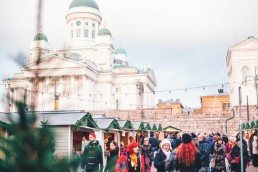
The Food, Drinks, Gifts, and Crafts of Helsinki Christmas Market
You can find almost everything for the festive season in Helsinki Christmas Market: traditional, high-quality handicrafts and Christmas ornaments, Finnish design gifts, hand-made candles, and Christmas delicacies. If you still don’t have traditional woolen mittens or socks, you’ll find them here. If you haven’t yet tasted Finnish take on mulled wine called glögi, sample through different variations while you’re browsing through more than a hundred wooden huts (last year glögi came in 10 different infusions from spruce sprout to apple).
Shop organic Christmas delicacies, wild honey and wild game products, Karelian pies, mustard, sausages, dry meat, smoked fish and gravlax, cinnamon buns, Christmas cakes, artisan chocolate, or fudge. At least, take advantage of the free samples throughout the market. Tasting tip: the fudge stands are our favorites, but I wouldn’t resist the chocolate stands either.
Many legendary Finnish restaurants and street food chains have their own stands at Helsinki Christmas Market. Food options vary from traditional Christmas food to contemporary street eats, from sausages to creative vegan dishes.
There’s also an atmospheric heated café bar serving Finnish Christmas beers, wine, snacks, cakes, and traditional ginger cookies. It has become our new Christmas tradition to sit down behind the glass windows to observe the Christmas Market and its old-fashioned merry-go-round. We love the fact that nowadays you can sip high-quality craft beers and wines while watching the winter wonderland of urban Helsinki.
The Traditional Carousel of Helsinki Christmas Market
Beautiful, traditional carousel in the heart of Helsinki Christmas Market steals the show. Kids love the free rides on wooden horses, and also adults are welcome to take a ride. Carousel is the perfect spot for those Christmassy Instagram images from Finland, whether you’d fancy a photogenic ride or just a stunning picture of the carousel, Christmas market huts, and the white Helsinki Cathedral in the background.
After a couple of years of rehearsal, I’m proud to say that Helsinki Christmas Market is finally the most beautiful Christmas Market in Finland. The unique setting in Senate Square, in the shadow of the white cathedral and around the statue of Emperor Alexander II, is part of its spell. People from Turku probably disagree, as Turku’s traditional Old Great Square Christmas Market is probably the most famous Christmas market in Finland – Finnish Declaration of Christmas Peace has been done at Turku since 13th century.
Helsinki Christmas Market is called Tuomaan Markkinat in Finnish (St. Thomas Market), and it’s held in Senate Square, in the center and historic area of Helsinki. Helsinki Christmas Market is usually open 6.-22.12. from Tuesday to Friday 11 AM t o 8 PM and Saturday to Sunday from 10 AM to 8 PM (please check this year’s specific opening times from their website). Helsinki Christmas Market is unfortunately usually closed on Mondays.
Santa Claus visits Helsinki Christmas Market on weekends.
Address: Senate Square, Aleksanterinkatu (in the center of Helsinki)
Official website: tuomaanmarkkinat.fi
Tallinn is just a short ferry trip away from Helsinki and Tallinn’s Christmas Market is among our eternal favorites. Check out our complete article about Tallinn Christmas Market! Here’s a full guide about Christmas time in Copenhagen with a list of the best Christmas markets.
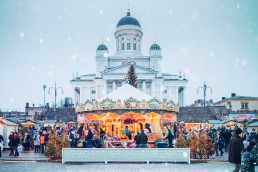
Vanhan Joulutori Christmas Market
Vanhan Joulutori is a cozy Christmas market held at Old Student House (Vanha Ylioppilastalo). It’s the best market in town for buying Christmas ornaments and artisan gifts. Café serves Finnish mulled wine (glögi), snacks, and even lunch.
Address: Mannerheimintie 3 (in the center of Helsinki)
Ornamo Design Joulu: Design Christmas Market at Helsinki Cable Factory
Three-day design Christmas Market at Helsinki Cable Factory showcases Finnish design, fashion, and ceramic art in early December.
Address: Kaapelitehdas, Tallberginkatu 1
Korjaamon Joulumarkkinat (Korjaamo Xmas Market)
The official Christmas Market season kick-off, Korjaamo’s Xmas market, is held in the old tram hall of Korjaamo Culture Factory in in early December.
Address: Töölönkatu 51
Teurastamo Christmas Market
One of the locals’ favorite, Teurastamo Christmas Market, has been growing each year and will no doubt break its records again this year. Old slaughterhouse (teurastamo in Finnish) is a creative urban space with lots of artisan food makers, from a pasta factory to craft chocolate, ice cream, and coffee. Thus, this merry holiday market offers a delicious mix of food and craft stalls, combined with fun events, music, and workshops.
Teurastamo Christmas market is open usually for one weekend only in mid-December.
Suomenlinna Fortress: Christmas at the Fortress
Our favorite from the smaller-scale Christmas events is the festivities in Suomenlinna fortress island, just 10-minute ferry ride from the center of Helsinki (South Harbor). Also museums and galleries have special Christmas program and themes, and local artists are selling their crafts – plenty of lovely gift ideas there, as well. Please check out their opening times, as they vary each year.
The first weekend of December marks the magical point in celebrations, as the Christmas trees of Suomenlinna are lit and the fun festive activity called Trail of the Fortress Gnome is launched for kids. Suomenlinna Toy Museum stays open whole Christmas season, except December 23-25.
What About Helsinki’s International Christmas Market?
Helsinki’s traditional take on Central European Christmas Markets is called International Christmas Market. We hope this huge holiday market will make a comeback in 2024!
Christmas time in Helsinki: Where to Go & What to Do
For foreigners, it’s not that easy to navigate in Helsinki during the Christmas time. As a Finn who’s originally from Helsinki, I share with you both the traditional things to do in Helsinki at Christmas and some of the best winter activities that fit perfectly for Christmastime.
Good news: most shops stay open during Christmas time, excluding Christmas Day and New Year’s Eve. I’ll list the usual opening hours and other practicalities of Christmas time at the end of this article.
TRADIONAL CHRISTMAS THINGS TO DO IN HELSINKI
1. Drink Glögi, Finnish Mulled Wine
If you survived visiting Helsinki’s Christmas markets without tasting glögi, you still must do it! The original Finnish glögi is made with alcohol-free, spiced juice with vodka.
Nowadays, we have also the “real mulled wine”, made from wine – and to keep things simple, it’s called glögi, as well!
Finnish glögi is garnished with almonds for good luck and raisins.
2. Eat ”Pipari”, Finnish Christmas Gingerbread Cookies
Finnish gingerbread is the best in the world (I might be biased) – taste traditionally spiced up Finnish gingerbread called “pipari” and judge yourself.
3. Sample Finnish Craft Beers – Yes, We Do Have Christmas Brews!
Craft beer culture is getting bigger each year in Helsinki. Head to some of the best craft beer pubs in Helsinki to sample Finnish Christmas brews. Here are our favorites:
- Kaisla: craft beer pub in Kaisaniemi, pretty near the main railway station. They have one of the best craft beer selections in town – both Finnish and foreign beers.
- Pien Shop & Bar: a pleasant newcomer in Ateneuminkuja (behind Ateneum museum). Originally a craft beer bottle shop, this little pub has both amazing Finnish craft beer selection and atmosphere.
- Bier-Bier: Slightly off the center, but near Esplanadi. Lovely setting in an old bank hall and a great, although changing selection.
- Teerenpeli: Finnish brewery pub in Kamppi, opposite the big Kamppi shopping center.
4. Celebrate St Lucia’s Day in Helsinki (13th of December)
If you happen to be in Helsinki on the 13th of December, go to see St Lucia’s Day celebrations in Helsinki Cathedral and Helsinki Christmas Market (Senate Square).
St Lucia’s Day is a Scandinavian tradition, celebrated especially among Swedish speaking Finns. It’s a celebration of light during the darkest period of the year (a.k.a “kaamos” when sun doesn’t rise at all in Finnish Lapland). St Lucia (St Lucy) was a young Christian martyr who was killed in 304 by Romans. She was among the earliest Christian martyrs.
St Lucia’s Day is traditionally celebrated in schools and churches. The biggest celebration in Finland takes place in Helsinki Cathedral, from where a procession of white-clad girls with candles in their hands and heads descent down to the Senate Square.
Similar St Lucia processions are done all over Finland. When we were kids, our schools had Lucia processions each year. Nowadays the majority of the celebrations are in the churches and town squares.
5. Go to Sauna: Christmas Sauna is an Old Finnish Tradition
If you haven’t been in sauna yet, now you can’t avoid it anymore! Christmas sauna is ancient Finnish tradition, which meant been both spiritual and physical purification.
Helsinki has a wide range of public saunas if you can handle being naked with others. Some of the best traditional, wood-fired public saunas are Kotiharjun Sauna and Sauna Arla, which both date back to the 1920s. Although I must admit that both of them are a bit spartan for most of the tourists, but still Anthony Bourdain visited Arla and took a cupping session there!
More tourist-friendly and spa-like saunas include Löyly and Allas Sea Pool: you can dip into the chilly Baltic Sea in both!
If you want more privacy, rent an apartment with a sauna! It’s said that Finland has 3,2 million saunas (fact by Finnish sauna society) – and we only have under 6 million people! We used to have a sauna in our apartment in Helsinki and used it many times a week.
Also, many hotel rooms come with a private sauna – or you can book a private sauna per hour in hotels or spas.
WINTERY THINGS TO DO IN HELSINKI FOR COUPLES
6. Ice Skating in Rautatientori (Central Square by the main railway station)
Ice skating is both relatively new and ancient winter thing to do in Helsinki. In the past, people went skating on the Baltic Sea. Nowadays, we have a beautiful ice skating ring in the middle of the city center, which has made ice skating the favorite winter activity among tourists. Even locals love it!
CHRISTMAS THINGS TO DO IN HELSINKI FOR FAMILIES
7. Meet Santa Claus – He’s From Finland!
You can meet and greet the real Finnish Santa Claus at Helsinki Christmas Market and many of the shopping centers during December. Did you know that Santa Claus is originally from Finland, and lives in Lapland? His ancient home is at Korvatunturi fell, although he can now be met all year round in Santa Claus Village in Arctic Circle (nearby Rovaniemi).
8. Marvel the Christmas Window of Stockmann
For decades, seeing the “Christmas Window” of Stockmann Department store has been among the winter highlights for kids. I still remember the excitement of seeing it the first time each December when I was a kid. The old-school Christmas display changes every year, but it usually includes Santa with his sleigh and many moving characters.
9. Share the Christmas time with the Animals of Korkeasaari Zoo
Whereas many sights in Helsinki are closed on Christmas Day, Korkeasaari Zoo stays open – although not even many Finns know that! In Christmas, Korkeasaari Zoo usually stays open on every day during the Christmas time, also on Christmas Eve.
For example, European bison stay outside in the snow in winter, among many other animals (brown bears are still hibernating in December). Check out the opening times and daily feeding times on Korkeasaari Zoo’s website.
We don’t usually recommend visiting zoos, but visiting Korkeasaari is a pleasant and educational experience, and they do valuable conservation work.
10. Christmas Shopping in Helsinki: Best Shopping Centers, Department Stores, Boutiques, and Shops
Firstly, check out the boutiques and quirky shops in Torikorttelit nearby Senate Square and Helsinki Christmas Market. In Torikorttelit you can find everything from Finnish fashion and design to Lapland-style knives, old-time toys, traditional linen home textiles, and rare vinyls.
Then, move on to the shops on Aleksanterinkatu, the official Christmas Street in Helsinki- and one of the best streets for shopping. Pop in Kluuvi Shopping Centre and Kämp Galleria Mall. The brand shops on Aleksanterinkatu include the famous Minna Parikka flagship store and Marimekko brand store.
End your Aleksanterinkatu shopping spree in Stockmann, the largest department store in Scandinavia. If you love books, visit the adjacent Akateeminen Kirjakauppa (Academic Bookstore) for the biggest book selection in Helsinki.
Walk through nearby Esplanadi Street for Finnish design shopping, there you can find, for example, Kalevala Koru jewelry, Aarikka, and Artek brand stores.
The best department stores in Helsinki include above mentioned Stockmann and Sokos in Mannerheiminkatu: add the latter to your Helsinki itinerary, as well. The best shopping centers are nowadays Kamppi (the biggest and newest one) and its nearby Forum, along with above mentioned Kluuvi and Kämp Galleria.
Christmas in Helsinki, Finland: Checklist for Opening Times and Practicalities
What are the Christmas Opening Hours in Helsinki?
Nowadays, Finnish shops and grocery stores are allowed to decide their opening hours independently. Unlike before, many grocery stores in Helsinki stay open all holidays.
Traditionally, shops in Finland have been open on Christmas Eve until 12 PM and closed on Christmas Day. Most shops have reopened their doors on Boxing Day.
Be prepared for the fact that most shops and restaurants in Helsinki are closed on Christmas Day.
Christmas in Helsinki FAQ
Where I Can See Santa Claus in Helsinki?
You can meet Santa Claus every day in December in Helsinki’s Christmas markets and department stores and malls all around the city. Helsinki Christmas Market is among the best places to greet Santa Claus.
Is there snow in Helsinki at Christmas?
Yes, usually, we have white Christmas in Helsinki. The first snow arrives in Southern Finland usually during November or December the latest, wrapping the capital city in a white fairytale gown.
We’ll add more Christmas markets and Christmassy things to do for 2024 as soon as the events are announced. Please let us know if you’re favorite Christmas market or event is missing in the comments below. We’d love to extend this article into the ultimate guide of spending Christmas in Helsinki with all the Christmas markets and things to do around the city.
How to Plan the Best Amazon Tours in the Colombian Amazonas: Leticia & Puerto Narino
If you’re planning to explore the Colombian Amazonas, base yourself in Leticia and Puerto Narino for the best Amazon tours. Organize your Amazon adventures at the spot with local guides to help the local economy and support the indigenous tribes of the Amazon. Added bonus: you’ll get the most authentic Amazon experience!
Independent Amazon Tour is Cheaper and More Fun!
We prefer to venture off-the-beaten-path and plan our tours independently: Colombian Amazon was no exception. Follow our steps: fly in the border town Leticia in the Colombian Amazon and take a public ferry with locals to a tiny Amazonian ecovillage called Puerto Narino. From there, it’s easy to organize all kind of Amazon tours directly with local guides.
You’ll score both much cheaper Amazon tours and more authentic experience by staying in an indigenous village instead of a jungle resort. In Puerto Narino, you can stay in a nice hotel but at the same time make friends with indigenous people in the riverfront and small village restaurants!
Why are the Amazon Tours in Colombia Better Than Amazon Tours in Brazil and Peru?
Brazilian and Peruvian Amazon suffers from mass tourism, while Colombian Amazonas remains much more authentic.
Why? If you’re on a vacation in Colombia, it’s much harder and also slightly more expensive to get to the Amazon than from Brazil or Peru. Whereas you can take a ferry from Manaus (Brazil) or Iquitos (Peru) to the Amazon, you need to fly through Bogota to Leticia from all Colombian destinations. So, adding Amazon tours to itinerary in Colombia is not as popular as in Brazil and Peru.
Can You Do Colombian Amazon Tours From Brazil or Peru?
Want to hear a secret? Surprisingly, if you’re on holiday in Brazil or Peru and want to tour the less-crowded Amazon behind the Colombian border, it’s super easy! The border towns of all three countries (Colombia, Peru, Brazil) are clustered together in an area called Tres Fronteras (Spanish for Three Frontiers). This means that you can easily walk from country to another – just like walking through suburbs.
How to Do Amazon Day Tours From Colombia to Brazil and Peru
It doesn’t really matter in which country you start your Amazon adventure, as crossing borders is easy. You can even do Amazon day trips in certain areas without any border formalities, visas or passport stamps (from Colombian side all the way to Brazilian town called Benjamin Constant, generally within 80 km radius from Leticia).
TIP: If you’re doing a multi-day Amazon tour, remember to get your exit stamp to avoid borders problems. Check also whether you need a visa to enter Brazil (some nationalities need it; not for a day tour in Tabatinga but for longer stays).
How Big is the Colombian Amazon a.k.a. the Amazonas?
The area surrounding the Amazon River and its tributaries in Colombia is called the Amazonas. It’s located in the southernmost department of Colombia, called Amazonia. With more than 400 000 square kilometers, Amazonia is the largest department of Colombia, covering a third of the whole country.
More than 100 000 square kilometers of the Amazonia is protected as forest reserves and national parks. The Colombian side of the Amazon has four national parks: Amacayacu, Cahuinari, Rio Puree, and Yagoje Apapori.
The Amazon proper forms the border between Colombia and Peru. Amazon also has many major tributaries in Colombia, which offer less-crowded day and overnight trips for than the Amazon proper.
Planning Amazon Tours: Step-By-Step Guide to the Colombian Amazonas
First, check out the flight schedule to the Amazon. If you’re staying in Colombia before your Amazon adventure, check the flights between Bogota and the only Colombian town with an airport in the Amazon, Leticia. If you’re coming from Brasil, check the flights or ferries into Tabatinga, the Brasilian counterpart of Leticia. From Peru, you should take a ferry from Iquitos to Isla Santa Rosa. If you’re coming from Colombia, flying in Leticia is the only option to get to the Amazonas.
How Many Days You Need in Leticia
Plan on spending at least two nights in Leticia before taking multiday Amazon tour, and preferably one day after your Amazon adventure. That way you can leave your heavy luggage to your hotel or hostel and take just a day backpack to the jungle trip. Many hotels also lend rubber boots so that you don’t need to buy or carry your own.
Beware Fake Amazon Tours in Leticia
One tip and word of warning for booking Amazon tours in Leticia: streets are full of opportunistic “guides” selling false tours. If you decide to skip Puerto Narino and make Leticia your base in the Amazon, we recommend booking the day trips through your accommodation or at least getting their approval for your chosen tour company or guide.
Take enough time to find an ethical, environmentally friendly, and safe tour operator. We can recommend booking Amazon day tours through the charming Amazon B&B Hotel, where we stayed.
Why We Chose Independent Amazon Trip to Puerto Narino
After chatting with several tour companies, checking their backgrounds and reviews from TripAdvisor, we decided to take an independent ferry trip to Puerto Narino and take Amazon day tours while staying in Puerto Narino. It’s a way cheaper option to explore the rainforest than Amazon tour packages and gives you the freedom to choose your guides in person.
We also found out that there were more than a handful of shady players doing tours in Colombian, Brazilian, and Peruvian Amazon, including guides who mistreat animals for the sake of a show for the tourists. Also, many jungle lodges seemed a rip off in terms of price and quality. Most rainforest lodges within one-day boat trip from Leticia (or Tabatinga or Isla Santa Rosa) are extremely basic and in a pretty rundown condition.
Organize Amazon Tours from Leticia
It’s easy to arrange Amazon hikes and boat trips at the spot in Leticia, and the town has some quirky sights to keep you entertained. To get orientated, stay at least a couple of nights in Leticia eating your way through the Amazonian cuisine and taking day tours to the Amazon.
From Leticia, you can visit nearby natural reserves either on day trips or multi-day rainforest expeditions. You can also go kayaking or birding, and visit indigenous communities. Check out our article about all the fun things to do in Leticia – including different day trips to the surrounding Amazon! You might end up staying longer than you planned!
Book Your Independent Amazon Tours in Puerto Narino
I should add an exclamation mark in the title: we highly recommend that you book Amazon tours directly with local fishermen in Puerto Narino. We contacted several tour companies while planning our Amazonas adventures, but all of them fell short somehow – and the others hooked you up with the same local fishermen.
When you settle the price straight with the locals, it’s cheaper for you and the money goes straight to the pockets of your guide. All our indigenous guides were amazing: although they spoke Spanish and maybe a couple of words English, we understood each other well enough.
Best Tours in Colombian Amazon (From Leticia & Puerto Narino)
We’ll list below examples of the most exciting tours in the Colombian Amazon to give you inspiration. Check out our things to do in Leticia article for full details!
- Short Amazon day hikes and night walks in Tanimboca Nature Reserve, Chacara da Coruja Reserve, and Reserva Natural Omagua
- Tarapoto Lake tour with pink and gray dolphins and walking trees (from Leticia or Puerto Narino)
- Monkey Island Tour (Isla de Los Micos)
- Zip-line and canopy tour in Reserva Natural Tanimboca
- Boat and fishing tours in Marasha Nature Reserve (Peru)
- Amazon night safaris (by boat or boat trips with short walks)
- Rio Yavari Amazon safari (day trip or overnight tour)
- Sacambu Lake dolphin tours
- Canopy tour in Omagua Reserve
- Kayak tours in Yahuarcaca Lakes
- Birding tours in the Amazon proper and its tributaries
- See the waterlilies in Victoria Regia Nature Reserve
- Visit the indigenous tribes and villages of the Amazon
- Jungle Survival Tours
Best Amazon Tours From Manaus, Brazil
I know, I’ve been hyping the Amazon tours from the Colombian side during the whole article. If your journey takes you to Manaus, you can, of course, book interesting Amazon tours starting from Manaus. The key for Brazilian Amazon tours is to have enough time to get out of the beaten path.
If you’re lucky to have one week for the Amazon tours and would like to sleep in a hammock learning some valuable jungle skills, consider this 6-Day Amazon Jungle Survival Experience starting and ending in Manaus. This tour ventures deep in the rainforest, unlike many others, showing you the real treats of the Amazon.
If you have 2 to 4 days for the Amazon tour from Manaus, check out these affordable tour packages in Anaconda Lodge, which take you off the beaten path but offer basic facilities in the jungle.
If you’re looking for an Amazon day tour from Manaus, check out this boat tour.
How to Choose Ethical Amazon Tours
Unfortunately, many Amazon tours include unethical animal interactions, for example capturing alligators or caimans for the fun of tourists. Please read the tour description online before booking or ask enough questions from the tour company to make sure that the guides won’t harass wildlife.
What to Pack for Amazon Tours & What to Wear
Here’s a list of essentials for your Amazonas adventure:
- lightweight clothes for the hot and sticky weather: preferably t-shirts, tops, shorts/skirt, and long-sleeve shirts and convertibles or lightweight long pants for covering up for bugs, snakes, and other creatures
- waterproof hiking shoes or even rubber boots (you can find the latter in Leticia: the jungle is muddy)
- raincoat or another kind of rain cover, we also had waterproof pants
- long socks (for avoiding bugs and leeches)
- bug repellent (you can find it in Leticia)
- sunscreen
- day backpack for day trips and hikes
- torch
Where to Stay in Leticia, Colombia
We loved our stay in Amazon B&B, which is constantly listed as the best hotel in Leticia. Their rooms offer affordable yet chic accommodation. Bungalows with own verandas and hammocks are the most luxurious option. Breakfast is great, and the leafy garden soothes your senses in the middle of this mildly chaotic jungle town of Leticia.
Where to Stay in Puerto Narino, Colombia
We stayed in lovely Wayra Selva, which was recommended for us by our Colombian friends. It’s hands down the best hotel in town and still super affordable. We loved the view from our own little terrace. The room was clean and location excellent.
Where to Eat in Leticia & Puerto Narino
Eating out is also an exciting activity in the Amazon! In Leticia, we loved to dine at El Santo Angel’s terrace in the center, sampling casabes (local pizzas) and fresh fish. Tierras Amazonicas has rave reviews, but for us, El Santo Angel was the clear winner.
Restaurants in Puerto Narino are traditional and modest, but food can still be delicious. Try Las Margaritas by the football field (it’s where most tourists go) and the grill restaurant by the riverfront: we preferred eating with the locals in the latter. Also, the street food stalls in Puerto Narino offer tasty snacks.
How to Get to Leticia & Puerto Narino, Colombia
If you’re coming from the rest of Colombia, the only way to get to Leticia, the capital of the Colombian Amazon, is by plane. Check our tips for finding cheap internal flights in Colombia.
All Amazon tours include boat transfers from Leticia. If you’re planning an independent Amazon tour and visiting Puerto Narino ecovillage, take a public boat from Leticia to Puerto Narino (2 hours). Book your tickets the day before to secure seats.
Have you been in the Colombian Amazon? Did you plan your Amazon visit independently? If you took guided Amazon tours, which were your favorites?
Pin This Story!
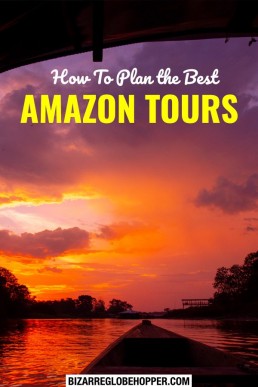
Balule Nature Reserve: Off the Beaten Path Safari Destination in Greater Kruger National Park, South Africa
Balule Nature Reserve is a Big Five safari destination within Greater Kruger National Park, yet pleasantly remote and off-the-beaten-path. There are no fences between Balule and Kruger: wildlife is the same, but in Balule the safari experience remains more sublime. As Balule is a relatively new private reserve, there a just a dozen of lodges.
Get the Taste of Balule’s Private Wildlife Sightings
In Balule Reserve, you’ll have more private wildlife encounters than in Kruger National Park and many of the other reserves with the Greater Kruger. Self-drives are not allowed in Balule, and as there are just a handful of lodges, vehicles are few. Unlike in Kruger, you don’t have to compete over animal sightings with other tourists – and your guide can drive off-road closer to the wildlife.
What Wildlife Can You See in Balule Nature Reserve?
Game drives unwrap the exceptional and varied biodiversity of Balule. While bouncing on gravel roads over steep little hills and passing majestic rocky outcrops, keep an eye out for jackal families hunting, elephant herds and giraffes peeking out of the bush, lions resting in the shadows and leopards lurking in the koppies.
In flat lowveld woodland, elephants are pushing down mopane trees and warthogs trotting away with offspring in tow. Balule also hosts some rare species, such as honey badgers.
Olifants River pierces Balule Nature Reserve, providing a steady crocodile and hippo population and attracting herds of elephants, giraffes, buffalos, and waterbucks for a drink – especially during the dry season (June–August). Thanks to the perennial Olifants River, Balule has impressive birding.
What wildlife did we see in Balule Nature Reserve? Black rhinos, herds of elephants and buffalos, several jackal families with tiny puppies, lions mating, freshly born impalas, kudus, zebras, giraffes, different species of vultures, and a myriad of other birds. We didn’t manage to see leopards this time, but it was just bad luck, as the rainy season had just started and all animals were slightly harder to see than usually. Still, that’s a pretty impressive list for five days of game drives!
All photos in this post by Piritta.
Balule Nature Reserve Vs. Other Private Reserves in Greater Kruger National Park
Sabi Sand, Klaserie, and Timbavati are far more famous private reserves within the Greater Kruger National Park than Balule. We hadn’t even heard about this off-the-beaten-path reserve, which promised already that there wouldn’t be as many tourists around. That’s the main reason why we chose a safari in Balule Reserve – and you should do the same.
As a rising safari destination, Balule Nature Reserve has more affordable safari packages than other private reserves within the Greater Kruger National Park. Compared to Sabi Sand and Timbavati, Balule has also better budget and mid-range accommodation options.
Don’t get us wrong: we still encourage you to visit Klaserie, Timbavati, and other areas in the Greater Kruger National Park. All private reserves are unique and offer amazing and private wildlife sightings if you choose your lodge wisely. We loved our visit Klaserie and will write a separate story about it, featuring stunning leopard and wild dog sightings (there we had the luck!).
Still, if you need to pick just one place to stay in the Greater Kruger National Park, I’d recommend safari in Balule Nature Reserve. I’ll discuss the big and beautiful “why” in details in the chapters below.
Highlights of Balule Nature Reserve
- Winning Value for Money: Affordable Safari Packages (When Compared to Sabi Sand, Klaserie and Timbavati Reserves)
- Off-the-Beaten-Path: Fewer Vehicles and Tourists, Better Wildlife Sightings
- Big Five Game Reserve: See Lions, Elephants, Buffalos, Rhinos, and Leopards
- Walking Safaris by Olifants River (Almost Guaranteed Animal Sightings)
- Amazing Birding Thanks to Olifants River
- Versatile Landscapes: More Diverse Backgrounds for Wildlife Photos Than in Kruger
- From Luxury Safaris to Affordable Middle-Range Safaris
- Kruger Day Safaris in Open Vehicles
10 REASONS TO CHOOSE BALULE NATURE RESERVE
1. Balule Nature Reserve is An Affordable Safari Destination
Compared to Klaserie and Timbavati, safaris in Balule Nature Reserve are more affordable. That means that you’ll get a better luxury or middle-range lodge for the same price – and there are some attractive budget-friendly options, as well (which are hard to find in Klaserie and Timbavati). The price-quality ratio in Balule Nature Reserve is simply better than in the more famous parts of Greater Kruger National Park.
2. See the Big Five in South Africa – Without Crowds
The Big Five – Lions, Elephants, Buffalos, Rhinos, and Leopards – is the bucket list for every safari-goer. As there are no fences between Balule and Kruger National Park, the Big Five roam freely in the area.
Many private reserves within the Greater Kruger National Park market themselves as the best place to see the Big Five in South Africa. In my opinion, choosing the best private reserve for you is a matter of taste. Take into consideration also other factors, which are discussed here. If you want to experience game drives without other vehicles around and appreciate private wildlife encounters, Balule Nature Reserve is hard to beat.
After countless of game drives, we don’t see ticking off animals as the ultimate safari goal, but it’s always exciting to observe big game in their natural habitat – and spot also new species outside the famed Big Five. In Balule, lack of other tourists makes game drives feel like a personal discovery.
3. Versatile Landscapes and Eco-system of Balule Nature Reserve
On game drives in Balule Nature Reserve, the landscapes keep changing quickly unlike elsewhere in the Greater Kruger National Park. The conserved area called Balule Reserve spans over 7.000.000 acres of woodland lowveld, which flora and fauna are among the most complex within Greater Kruger National Park.
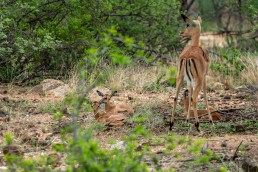
4. Walking Safaris by Olifants River: Always Something to See!
Walking safaris in Balule Reserve usually pop by Olifants River, which invites animals to drink and makes wildlife spotting a lot easier. As a perennial river, Olifants offer relatively easy hippo and crocodile sightings, which makes walking safaris more rewarding.
We’ve been on many walking safaris and learned to accept the fact that you might not see any big game even after 3 hours walk in the bush. If there’s a river teeming with hippos and crocs nearby, you are almost guaranteed to see these animals relatively close by. In Balule Reserve, we were also lucky to observe elephants at a short distance.
5. Birding by Balule’s Olifants River
Olifants River offers impressive birding with 250 recorded species. Thus, Balule Nature Reserve is one of the best places in South Africa for birding and bird photography.
Raptors and weavers are easily spotted at the riverfront. One of our favorite birds, the stunning lilac breasted roller, arrived last year in the Greater Kruger at the same time with us.
6. Off the Beaten Path Safaris in Grietjie Nature Reserve (Within Balule Game Reserve)
World-famous Kruger National Park is more crowded than you could imagine, which was disappointing for us. In the remote corners of Greater Kruger National Park, it’s still possible to do game drives without seeing any other vehicles.
Grietjie Nature Reserve at the northern tip of Balule is just that unspoiled wilderness area that every safari-goer is dreaming about. Game drives unwrap the exceptional and varied biodiversity. While bouncing on gravel roads over steep little hills and by majestic rocky outcrops, keep an eye out for the elephants pushing down mopane trees, warthogs trotting away with offspring in tow, and big cats hiding in the shadows.
Grietjie Nature Reserve hosts some rare species, such as honey badgers, and has impressive birding with 280 recorded species. On our first game drive in Grietjie Reserve, we didn’t see any other vehicles.
To be able to experience Grietje Reserve, choose a lodge that has permission to do game drives there (such as Baluleni Safari Lodge).
7. Rising Eco-Tourism Safari Destination in Greater Kruger National Park
Many of the private reserves surrounding Kruger National Park are marketed as eco-tourism destinations. With eco-friendly lodges and sustainable practices, Balule is a lesser-known rising star.
Choose a nature-friendly safari lodge in Balule, which supports local conservation efforts and acts conservation-mindedly towards visiting wildlife. Check out chapter nine for our detailed recommendation.
8. The Winning Combination: Balule Game Reserve With Day Safaris in Kruger National Park
If you have only 3-5 days for a South African safari, combine Balule Game Reserve with a full-day safari in Kruger National Park. Thus, you get the taste of game drives in one of the largest – and most famous – game reserves in Africa.
It’s astonishing how much animals you can see within just one day in Kruger National Park. But it’s equally mind-boggling how many other vehicles and tourists you will see. We have visited many of the best national parks in Africa, such as Serengeti and Masai Mara, and weren’t still prepared to how commercial Kruger National Park is nowadays. For many safari tourists, it’s enough to visit Kruger National Park on a full-day tour, after which they can spend the rest of their safari in more pristine private reserves within the Greater Kruger area.
There are currently only two safari companies within Balule Reserve, which have a license to organize Kruger day safaris in open vehicles – and Baluleni Safari Lodge one of them. We tried them both, and state whole-heartedly that the guides, safari vehicles, and the level of service of Baluleni are unrivaled.
9. Baluleni Safari Lodge: Hidden Gem in Balule Nature Reserve
For us, picking the right safari lodges in Balule Nature Reserve made all the difference. If you’re searching for affordable and authentic South African safari experience, you cannot go wrong with Baluleni Safari Lodge.
Baluleni combines old-world South African hospitality with the ultimate attention to details, pushing the boundaries of a conventional safari lodge. The value of their safari packages is outstanding – and the level of service unheard-of in this price range.
Remote Boutique Lodge in the Wilderness of Balule Reserve
Firstly, the location of Baluleni is ideal for those seeking tranquil safari experience away from the crowds. Baluleni lies by the bank of Olifants River, at the end of long and winding little gravel road that climbs over bushy hills and descends to the valley with a dry river bed. We used to see many animals just by their private road.
When we arrived, a fresh impala kill awaited at the center of their well-manicured garden, posing intriguing questions of what had happened there in the night before. You will stay in the middle of the wilderness, in the Big Five area. There are no fences around the property – and that makes every moment exciting. You can see anything from your tent, chalet, or lunch table.
Baluleni Safari Lodge has only five chalets and two safari tents overlooking the riverine landscape. This creates a sense of seclusion and intimacy.
Heartfelt Safari Experience
In Baluleni Safari Lodge, you are treated as both a VIP guest and a family member. That’s a rare skill, which only a few safari lodges that we’ve visited have mastered (and usually, the successful ones have charged ten times more than Baluleni).
The atmosphere is casual, dinners are among the best we’ve had in South Africa, and service is always heartfelt. The owners, Elke and Evert, connect with each guest and share their stories over dinners like old friends. The safari experience is effortless and delightful at each moment.
Your days just flow in Baluleni, from morning game drives with bush coffee breaks to multi-course breakfasts, chilling at the pool with visiting elephants, spontaneous river walks to spot hippos with the owners, to casual lunches at the restaurant and evening game drives in the bush. I’ll address the most magical part, boma dinners, and stargazing, in a separate chapter below.
Everything is smooth and easy for the guests thanks to the invisible but extremely efficient mode of operation. Even the reservation process is smooth: no other lodge has ever provided me with as quick, helpful, and in-depth email answers as Baluleni.
Good Wildlife Conservation Policies
Still, we appreciate most of Baluleni’s true conservation-mindedness. When elephants raid their beautiful garden, they watch lovingly the precious creatures and tell guests how they are taking care of the ecosystem – not destroying their garden but helping the bush and other creatures. Like Evert puts it, elephants have been designed to keep bush open and help it to fight against erosion.
The owners take an open stand against wildlife interactions, which are unfortunately widely available in the Greater Kruger and Hoedspruit area. Elke and Evert are among the most good-hearted and animal-loving persons we’ve ever met. We even saw how they talked over guests who were interested in doing elephant interaction at the end of their safari.
What animals can you see in Baluleni Safari Lodge?
Baluleni’s resident elephants are getting famous thanks to continuous Facebook updates. We were lucky to witness a rare event of warthog eating an impala at the yard while having our first lunch. We saw baboons, warthogs, and impalas crossing the yard on every day of our stay.
The chalets are at the bank of Olifants River, meaning that you might share the pathways with hippos. They’ve had big cats on the property, as well. We listened to the lion roars while savoring multicourse dinner at the outdoor boma.
Balule Nature Reserve is the Big Five area, and Baluleni Safari Lodge doesn’t have fences. So, you can encounter any wild animal at the lodge but fear no more. After dark, guides escort you to the chalets and tents.
Rare Treat: Honey Badger Eating a Scorpion at Baluleni Safari Lodge
Yes, it’s disturbing and among the “to die for” wildlife encounters which have happened at the property of Baluleni Safari Lodge. We still cannot believe that the death-defying honey badger can eat venomous snakes and scorpions! It gets even weirder with these badass creatures, as they use the venom to boost their immune system: think of it as a venom vaccine. Check out the video below (courtesy of Elke Van Eeden/Baluleni Safari Lodge) for the rarely seen, incredible encounter!
10. Boma Dinners and Stargazing in Balule Nature Reserve
South Africa and Namibia offer the best stargazing spots in Africa. The distant corners of Balule Nature Reserve are far away from the light pollution of modern civilization. Even the nearby towns are small and as the lodges are few, the night skies lit up with bright constellations. We’ve experienced better stargazing only in Namibia.
The most memorable boma dinners of our Greater Kruger safari tour were in Baluleni Safari Lodge. Nothing beats listening nearby lion roars under a blanket of stars, around the dancing flames. In Baluleni, the campfires are even more magical than usual, as Evert’s secret recipe keeps fiery blue flames flickering through the night. Elephants are frequent guests in Baluleni’s boma dinners, peeking their trunks across the wooden enclosure (called boma in Swahili), which is designed to protect the camp.
Tips for Picking a Lodge in Balule Nature Reserve
- Consider whether you want to combine Kruger National Park into your Balule safari: only two companies in Balule Reserve can do Kruger day safaris in open vehicles
- Check that the lodge is eco-friendly and supports local conservation efforts
- Check where the game drives are done: each lodge in private reserve operates in different areas where they have permission to drive
- Check the reviews on TripAdvisor, SafariBookings, and other services
- Consider whether you’re looking for a luxury safari or affordable safari, chalet or tent, remote or central location, etc.
Best Times to Visit Balule Nature Reserve (For Safaris & Wildlife Watching)
Balule Nature Reserve can be visited year-round. Each season has its pros and cons. Generally, wildlife watching is excellent throughout the year in the Greater Kruger National Park.
Dry season (from May to September) is officially the best timing for wildlife watching in Balule Reserve and the Greater Kruger National Park as a whole. It’s winter time in South Africa, which translates into pleasant weather in otherwise hot Kruger area with virtually no rain. Visibility is better than in summer months due to thinner vegetation. Bring a jacket for early morning game drives.
Summer months (October to April) mark the wet season in Balule and the Greater Kruger National Park. The rain patterns have varied during the last years (it’s been the worst drought in the history of Kruger National Park), so the division isn’t that clear anymore. Summertime brings lush vegetation and baby animals.
We loved our visit to Balule Reserve last December, at the beginning of the rainy season. We witnessed the first rains: how bush candles burst in white and purple flowers, stunning migratory birds returned, impalas gave birth, and tons of baby animals posed for our cameras. We felt privileged to see how quickly the first rains transformed the barren scenery into a fragrant flower garden.
Balule Nature Reserve Facts & Figures
- The word “balule” means buffalo in Shangaan
- Balule Nature Reserve’s conservation area is appr. 7.000.000 acres (23.000 km2)
- The borders between Balule Nature Reserve and Kruger National Park
- Balule is just one-hour drive from the two main gates of Kruger National Park
- Balule is lowveld area and mixed woodland eco-zone
- Balule Reserve is also the birth place of the Black Mamba Anti-Poaching Unit that we admire. The Black Mambas are female rangers who protect the Olifants West Nature Reserve from poachers.
How to Get to Balule Nature Reserve
Getting to the Balule Nature Reserve is easy. Most tourists take a shuttle or internal flight to Hoedspruit. Balule Reserve lodges can pick you up from the airport or shuttle drop off locations. Depending on your lodge, some shuttle companies even offer door-to-door rides.
Johannesburg to Balule Nature Reserve (Through Hoedspruit)
Daily shuttles from Johannesburg to Hoedspruit take around 6 hours and cost around R500-1000. There are morning and afternoon shuttles available.
Flying is the most convenient and scenic way to travel from Johannesburg to Hoedspruit. The flight takes around one hour.
A rental car allows you to take the Panorama Route on your way from Johannesburg to Hoedspruit (highly recommendable if you have time). Also some safari companies offer transfers through Panorama Route and Blyde River Canyon, which makes the long journey more rewarding.
Driving from Johannesburg to Hoedspruit (450km) takes around 5 hours without breaks. Add 0,5–1 hour more for reaching your lodge in Balule Nature Reserve, depending on the location.
Durban to Balule Nature Reserve (Through Hoedspruit)
Durban is 10 hours drive from Hoedspruit. Unless you have your own car and can split the journey in half, I’d recommend flying between Durban and Hoedspruit. You can also fly to Johannesburg and take a shuttle to Hoedspruit.
Cape Town to Balule Nature Reserve (Through Hoedspruit)
Fly from Cape Town to Hoedspruit and negotiate a pick-up service from your Balule Nature Reserve lodge.
Have you been on a safari or in the Greater Kruger National Park? Would you pick Balule Reserve for your next safari destination? Please share your thoughts in the comments below. Our visit in Balule Nature Reserve was hosted by Baluleni Safari Lodge but, as always, all opinions remain our own.
Help us to spread the word – Pin this story!
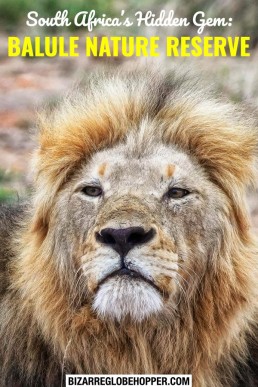
41 Cool Things to do in Cartagena, Colombia: Best Sights, Attractions, and Hidden Gems
While exploring the laidback Caribbean coast of Colombia, be sure to check out these fun activities and things to do in Cartagena! We list the best places to eat and drink, the coolest day tours, the must-see sights and quirky attractions within the walled city and up-and-coming Getsemani. Let’s get the party started!
This article may contain affiliate links: if you decide to buy something through the links, we will make a small commission at no additional cost to you. Think of it as buying a coffee for us on someone else. Thanks for your support!
1. Stroll Through Muelle Turistico to the Clock Tower and Main Gate of the Old City
Find your way to Muelle Turistico, a boulevard leading to the Old Cartagena from the new city where you learn to say “no” to overly enthusiastic street vendors.
Walk towards the yellow clock tower called Torre de Reloj, which marks the main entrance to the Old City of Cartagena. The clock tower is the first stop for taking those iconic photos of Cartagena – and a starting point for getting lost in the maze of old alleyways!
2. Get Lost in the Streets of Old Cartagena de Indias (Independent Walking Tour)
Undeniably the best thing to do in Cartagena is to roam the cobbled streets of Old Town aimlessly. Getting lost is a part of the experience, so just walk through the main gate and forget the map.
Let the Old City unfold by itself, one alley at a time. Pop in galleries, cafés, bars, and quirky shops. Don’t worry about finding the best spots quite yet, we’ll get to that later. Just breath in the atmosphere, take photos, and enjoy the colorful colonial city vibes!
Click here to check out the ultimate 4-week itinerary around Colombia, from Cartagena and the Caribbean beaches to the mountains, colonial cities, and the Amazon! Our itinerary features the most famous sights of Colombia and the hidden gems to make your trip a perfect mix of iconic sightseeing and independent exploration. The route is easily modified into 1-week, 2-week, or 3-week Colombia itineraries.
3. Get Orientated on a Walking Tour Around the Old City
After your independent walking tour, you’ve already passed by many of the major sights of the walled city. Now it’s time to deepen the experience!
Join one of the walking tours and follow a local guide for a couple of hours. Be amazed by the history and little details that slipped your attention. Knowledgeable local guides make all the difference: forget the guidebooks.
There are excellent free walking tours of Cartagena but remember that you’re always supposed to tip anyway. Tours are available in English and Spanish, and there are also bike and Segway tours. If you wish to book in advance, check out this walking tour.
4. Explore Castillo de San Felipe de Barajas (San Felipe Castle)
Spanish fortress called Castillo de San Felipe is the most famous sight of Cartagena and shouldn’t be missed. Looming over the city, it’s luckily hard to miss. Take a short walk past Getsemani to the root of San Lazaro hill and climb up to explore the walls and dark tunnels of this 1600th-century castle.
The views across the harbor of Cartagena are photogenic – Don’t forget your camera!
5. Take a Boat to Tierrabomba Island for Photo Opportunities
The short local boat trip to nearby Tierrabomba Island is an exciting activity in itself. Enjoy fantastic photo opportunities as the boat leaves Cartagena behind. This a local way to travel – fun and cheap!
Finding the right boat is an adventure in itself. Follow the pier from Muelle Turistico and ask from locals where to find a water taxi to Bocachica (a small village on Tierrabomba).
6. Visit Fuerte de San Fernando de Bocachica (Fort San Fernando)
San Fernando fort is our favorite sight in Cartagena. Take a boat to Tierrabomba (check out the previous activity) and hire a guide from the tiny port of Bocachica when you arrive in Tierrabomba. Your guide will walk you through the village telling about the strategic meaning and history of San Fernando Castle, which used to guard the entrance to Cartagena.
Plan to explore the fortress at least for an hour: Visit vaults that served as food storage, chapel, gunpowder storage, artillery, and officer’s barracks. Climb up to the roof to photograph the view towards Cartagena and Bocachica village through the cannons. Some of the vaults are pitch-black and have bats: take a flashlight.
The 18th-century Spanish fort has also served as a prison. Your guide will pour amazing stories from the eventful history – I won’t spoil the fun here!
7. Get Sun-Toasted with Locals and Sip Tropical Drinks at Beaches of Tierrabomba
The best beaches on Tierrabomba are at the northern tip of the island and they’re all cleaner and less crowded than the mainland beaches of Cartagena. We recommend the gorgeous Bomba Beach, which overlooks the skyscrapers of Bocagrande.
You can also stay overnight in Tierrabomba: we recommend Blue Apple Beach House and Hotel Fenix Beach Cartagena. Bombastic Hostel is your best bet for a lower price and gets raving reviews.
Tips for visiting the beaches of Tierrabomba: Beware boat scams and fake guides selling the tours at the port. Tourists report scams where they are sold all-inclusive beach packages but in reality, the price includes only one-way boat trip and everything else is charged separately at a hefty price.
We recommend booking a legit day tour or visiting Tierrabomba independently. You can take the water taxi from Muelle Turistico to Bocachica and visit San Fernando fort (check out the previous activity) and haggle a cheap mototaxi ride from Bocachica to the northern beaches of Tierrabomba. From there, book a boat back to Cartagena (your guide will help to do it at a local price).
8. Visit El Totumo to Bath in a Mud Volcano
Visiting Totumo Volcano is among the most fun things to do in Cartagena – slightly weird and intimidating, yet hilarious and even healthy! Climb a staircase to the top of a volcano cone and descend the ladder to take that sulfur-smelling mud bath with other enthusiasts.
It’s easiest and cheapest to visit El Totumo mud volcano on a guided tour which includes 1-hour transfers from Cartagena – unless you have your own wheels.
9. Spend Evening at Plaza de la Trinidad and Walk Around Getsemani Neighborhood
Plaza de la Trinidad is one of the best places in Cartagena to spend a relaxed evening. Grab a beer, lemonade, or cheap street eats from the street vendors and sit at the stairs of Iglesia de la Trinidad, beautiful church in the center of the square. There are usually street performances or at least kids playing around. Lovely terraces are perfect for early evening drinks or beer and
Walking around colorful Getsemani neighborhood is the second best thing to do in Cartagena, if you ask me, right after getting lost in the walled city. Getsemani feels authentic and fresh after the walled city, it’s hipster and cool, but still local and not too crowded.
10. Photograph Street Art in Getsemani
If you’re into street art like us, Getsemani area won’t let you down. Murals are plentiful, colorful, and varied. You can find the best spots independently by just walking around Getsemani, although there are also guided street art tours.
Tip: Go in the morning, preferably on Sunday, to beat the crowds and see most of the murals when the shops are closed.
11. Find the Best Café in Cartagena
Drinking premium Colombian coffee in Cartagena was so high on our wish list that we ended up touring the most cafes in town and listing the best coffee shops in Cartagena.
I’ll encourage you to try at least two different cafes during your holiday in Cartagena. Tiny Café San Alberto in the walled city has the best coffee in Cartagena if you ask me. The other highly recommended coffee house is Café del Mural in Getsemani. Check our coffee house list for the full caffeine dose!
12. Find the Best Cocktails in Cartagena
The coolest thing to do in Cartagena must be searching for the best cocktail in town. The cocktail scene in Cartagena is quite astonishing for its size, making it an excellent weekend destination.
Because finding the best cocktails is usually a matter of taste, this activity requires pleasant legwork from a terrace and bar to another. The best cocktail bars are in the Old City and Getsemani.
Alquimico translates into Alchemy and lives up to its name, whisking together just the right ingredients inside a stunning colonial mansion. From their “sensory experiments” menu, try at least Inquisition: in-house ginger rhum with rose salt, lime, and syrup. Doors open at 6PM and crowd gets wilder near the midnight.
For rhum cocktails, head to El Arsenal or legendary Café Havana if you’re planning salsa all night long (both in Getsemani). Cafe Havana is Cartagenian institution and famous for hosting celebrities, such as Hillary Clinton (doors open at 9PM, live bands start around 11PM). For speakeasy vibes inside the walled city, find El Baron.
Whatever you choose, don’t forget to taste the Espresso Martini or Boundless Russian in Boundless Mezcal Café which offers both kick-ass specialty coffee and cocktails.
13. Walk upon the Walls of Cartagena
Take a romantic stroll on the walls of Cartagena. Begin at the Plaza de las Bovedas.
The walls of Cartagena surround the Old City and stretch for seven miles and are dotted with fortifications and bastions. Walls were built to protect the city from pirate attacks. Construction began in the 16th century and took almost 200 years.
Tips for visiting the walls of Cartagena: As there’s no shade from the sun, remember a hat and sunscreen. The best time is, of course, the sunset or sunrise. Don’t forget your camera!
14. Watch a Sunset at Café del Mar – on the Wall of Cartagena!
Finish off your walk on the walls in Café del Mar, a cool bar on the walls of Cartagena. It’s the best place in the Old City to watch the sunset while sipping a tropical cocktail. The chill terrace of Café del Mar is popular among locals and tourists alike: get there well before sunset hour to get a seat!
15. Find the Best Ceviche and Sushi in Cartagena
You’re on the Caribbean coast, so eat fresh fish! Cartagena’s restaurant scene offers something for everyone: there are good steak restaurants and decent ethnic restaurants, but seafood is the star here.
La Cevicheria has been recommended for years as the best spot for, you guessed it, ceviche. Same goes with Senor Toro considering steaks (if you yearn for that option).
Nowadays there are a dozen sushi restaurants in Cartagena: Masaki Sushi Wok, Tabetai Sushi Bar, and Kokoa Sushi Wok are some of the best. Pick Peru Fusion for a sushi dinner date (also other creative dishes on the menu).
16. Unwind in Book-Store Café
Abaco Café y Libros in the walled city combines coffee and books – who could possibly resist it? Abaco is a pleasant spot to take a break from the heat and shop your Gabriel Garcia Marquez copy. High ceilings are tapered with books from floor to the roof for some extra points from this bookworm.
17. Paddle Board, Kayak, Kitesurf, or Paraglide for Views to Cartagena
Stand-up paddleboarding lets you see Cartagena from yet another viewpoint. It’s fun and relaxed watersport that doesn’t require previous experience. Just rent a board and enjoy the sun!
Paragliding and kitesurfing are available for brave souls, as well as kayak rentals. LED-lighted Paddleboard Tour is among the best things to do in Cartagena at the sunset!
Check all the exciting watersport activities in Cartagena from here and airborne activities (including helicopter tours) from here.
18. Visit Famous Playa Blanca – Best White Sand Beach in Cartagena
Many people claim that Playa Blanca is the best beach in Cartagena – some even list it among the most beautiful beaches in Colombia. What you should know before planning a beach day is that Playa Blanca is not in Cartagena: going there takes 30-40 minutes by boat. It’s easiest to book a tour including boat transfers, although you can also haggle a taxi or use public transport to reach Baru peninsula (around two hours by bus and mototaxi combination or one hour by car).
Expect white sand and turquoise ocean, but be prepared to crowds and hawkers, especially during weekends. Plan to have a beach lunch at Play Blanca: fresh fish with coconut rice.
We recommend this full-day tour to Playa Blanca.
Tip: If you would like to have the beautiful, but often overcrowded Playa Blanca all by yourself, stay overnight! Tours leave at 4PM the latest, so the evenings are laidback. The only con: accommodation options are basic.
19. Take a Day Trip to Rosario Islands to Snorkel (Islas Rosario)
Searching for a tropical paradise in Cartagena? Take a day trip to Rosario Islands to snorkel in crystal-clear waters and unwind at Caribbean island retreat with a drink in your hand. Rosario and San Bernando Corals National Park is blessed with the largest and most diverse coral reef on the Caribbean coast of Colombia. The protected area includes Rosario Archipelago (Tesoro and Rosario Islands) and San Bernando Archipelago (Mangle and Maravilla Islands). In short, Corales del Rosario y de San Bernardo National Natural Park is the best place to snorkel near Cartagena de Indias.
Here’s the best Rosario Islands tour that we could find. Note that this tour includes catamaran trip from Cartagena to Rosario, unlike many other tours, which have a long bus transfer to Baru and just short boat trip to Rosario. Tour also includes non-alcoholic drinks, lunch, snorkeling equipment, and national park fees.
If you’d like to visit both Playa Blanca and Rosario Islands, this full-day tour is our favorite.
20. Drink Fresh Coconut Juice – Or Coconut Lemonade
Nothing beats a fresh, young coconut in a hot afternoon! Look for young, green coconuts for the best coconut water.
Coconut water is nature’s own sports drink, which keeps you hydrated on those hot summer days in Cartagena. Coconut water has more potassium than artificial sports drinks and loads of other healthy electrolytes and nutrients.
Tip for coconut lovers: Try also local coconut lemonade, which is sold in street stalls and almost all restaurants and cafes in Cartagena.
21. Eat Street Food
Cartagena is a perfect place to sample Colombian street food. Grab cheese arepas and empanadas (pastries) from street carts, taste local lemonades, patacones (fried plantains), tamales (boiled yucca or taro wrapped in leaves), and all that good South American flair. Cartagena is a melting pot of cuisines, as it used to be the main port of Colombia.
Feel free to find the best stands by trial and error or take this awesome street food tour!
Foodie tips: Plaza San Diego in the Old City has the best arepas in town. Cartagena has the best patacones (fried plantains) in Colombia: they are double-fried and made with garlic. We recommend eating ceviche only in restaurants to avoid stomach issues.
22. Hop on Chiva, Colombian Party Bus
Whether you’d like to make new traveler friends or just dance crazily on a colorful wooden bus, hop on a Chiva bus! It’s among the craziest things to do for tourists: loud and tacky, but also rather cheap way to see the city and drink more than you should.
Afternoon tours take you to the main tourist attractions: think of hop on hop off tours with crazy local flair. Night tours include live music on board, open bar (aguardiente or rum), light snacks, and nightclub cover.
Chiva tours last 3-4 hours and can be booked through your accommodation or nearby Torre del Reloj.
23. Dance the Night Away in Salsa Bars of Cartagena
Follow the beats and locals to find the best salsa spot in Cartagena. If you’d like actually to learn the art of salsa dancing, book a salsa bar hopping tour!
23. Dance the Night Away in Salsa Bars of Cartagena
Follow the beats and locals to find the best salsa spot in Cartagena. If you’d like actually to learn the art of salsa dancing, book a salsa bar hopping tour!
24. Visit Tayrona National Park
Don’t miss Tayrona National Park when you’re in Cartagena! It’s among the most beautiful national parks in Colombia, with palm-fringed sand coves and hiking paths through lush rainforest.
You can rent a horse and gallop through the rainforest to the best beach, Cabo San Juan del Guia, or just walk leisurely and stop to snorkel and swim wherever you please. Check out our complete guide on visiting Tayrona National Park.
Although it’s possible to visit Tayrona National Park on a day trip from Cartagena, we’d recommend staying one night in Santa Marta area, closer to Tayrona National Park, to make the most of your visit.
Day trips from Cartagena to Tayrona National Park leave well before sunrise and return late. Day trips from Santa Marta to Tayrona are more convenient and allow more time in the park. It’s also possible – and rewarding – to visit Tayrona independently and stay overnight: check out our article for further tips.
25. Visit Inquisitor’s Palace (Palacio de la Inquisicion)
The headquarters of Spanish Inquisition in the Americas was in Cartagena. The castle-like colonial façade and Baroque entrance at the leafy Plaza de Bolivar hides a horrendous torture palace of Inquisition.
You can visit the House of Dungeons, where heretics were left to wait for their fate and see many torture tools, which were used to obtain confessions. During more than 800 trials, no-one was declared innocent.
Inquisitor’s Palace is among the most beautiful colonial buildings in Cartagena. Inquisitor’s guillotine stands in the beautiful yard reminding about the macabre past.
26. Climb to Convent of Santa Cruz de la Popa for the Best Views Over Cartagena
Visit a small nunnery for a raven’s view of Cartagena. Haggle a taxi to Convent of Santa Cruz de la Popa to pay respects to the patron saint of the city, la Virgen de la Candelaria and photograph the best view over Cartagena. I wouldn’t recommend the steep and rather uninteresting climb, because the weather is hot in Cartagena.
This 4-hour historic tour visits the main sights of Cartagena and La Popa Monastery – extremely convenient way to tour Cartagena if you’re short on time!
27. Take a Day Trip to Minca Mountain village
Tranquil Minca is a world apart from the bustle of Cartagena. Set in the lap of Sierra Nevada Mountains, Minca offers splendid sceneries and cooler climate than Cartagena. Go hiking, birding, or mountain biking, visit coffee and cacao farms, plunge into waterfalls and mountain streams, or just relax in cool hipster cafés that line the tiny main street of Minca.
28. Feed Pigeons with Locals at Plaza de Bolivar
Plaza de Bolivar is a haven from the sun and crowds inside the Old Town of Cartagena. It’s shaded by trees, soundtracked by four fountains, overlooked by Palace of the Inquisition.
Unlike its more popular counterparts, Plaza Bolivar is filled with local couples and families and doesn’t feel touristy, although it’s right at the center of the walled city. There are usually free seats left: linger awhile over a fruit bowl, ice cream or cup of coffee before continuing your walking tour through the Old City. Blend in by buying corn to feed the pigeons.
29. Grab a Fruit Salad From the Iconic Palenquera
Buy a fruit salad from palenqueras, widely smiling fruit sellers clad in colorful dresses. In a matter of seconds, these ladies chop a tropical feast on the bowl. The first palenqueras wait just outside the Clock Tower Monument.
Palenqueras of Cartagena have become cultural icons of Colombia. Taking photos requires a couple of dollars, but if you buy fruits, the photo opportunity is usually included in the deal.
Tip from a fellow traveler: Unfortunately, men sell better fruits from weary wooden carts.
30. Rub “La Gorda Gertrudis” (famous Botero sculpture) for good luck
Medellin and Bogota are famous for their Botero sculptures, but there’s one curvy beauty in Cartagena, as well.
Find your way to Plaza Santo Domingo in the Old Town and look for a huge bronze statue of a naked woman. Do as the Colombians: Rub La Gordita Gertrudis on the breasts or bum to guarantee good luck in love!
31. Visit the Gold Museum (Museo del Oro Zenu)
Almost all gold stolen from the Incas left South America through Cartagena. Even if you’ve visited the gold museum in Bogota, the small Cartagena Gold Museum might be worth a short visit to admire gold and pottery from Zenu people. The Gold Museum of Cartagena is practically located in the walled city, so it’s on your walking route anyway.
32. Find Your Favorite Church in Cartagena’s Old City
The yellow tower and terracotta dome of Cartagena’s cathedral colors the iconic – and most photographed – street views of the Old City. Officially, it’s called the Cathedral of St. Catherine of Alexandria.
The oldest church in Cartagena, Convent of Santo Domingo (Convento de Santo Domingo) is one of the favorites of visiting tourists. The atmospheric Plaza Santo Domingo has numerous terraces for al-fresco dining.
San Pedro Claver church and convent, aptly located in the Plaza de San Pedro Claver, is the among the most famous churches in Cartagena. The remains of Saint Peter Claver, a monk who defended the slaves of Cartagena, lie below the altar. San Pedro Claver’s impressive baroque façade is hard to miss when you stroll in the old city of Cartagena.
The building works of all three above listed beautiful churches started already during the 16th century. The old city of Cartagena is also full of lesser-known, quirky churches: Go find your own favorite!
33. Taste Local Candies at Plaza de Los Coches (Portal de Los Dulces)
Plaza de Los Coches (Square of Cars) is right by the Clock Tower. The name comes from a tradition to park cars by the candy stalls that populate the arcaded walkway below the gorgeous colonial balconies.
Portal de Los Dulces is still a good place to sample traditional Colombian sweets, pastries, and confectionary. You can also buy gift boxes of artisan sweets.
34. Shop in Bazurto Market (Central Market of Cartagena)
Mercado Bazurto is loud and colorful. Go there for cheap street eats, crafts, fresh fruits and meat (unfortunately, also turtles are on offer). Bazurto Market is best visited on a guided tour and this tour is our favorite!
35. Visit Rafael Nunez House in Cartagena de Indias
Visiting Rafael Nunez’s House is an interesting cultural activity. It’s home to Colombian president, author, and journalist Rafael Wenceslao Nunez Moledo. Colombia’s constitution was signed at Rafael Nunez House in 1886. The house showcases 19th-century Colombian architecture and design.
Bizarre fact: Nunez is mentioned in “Love at the time of Cholera” by Gabriel Garcia Marquez.
36. Cartagena’s Less-Visited Colonial Fort: San Sebastian del Pastelillo
Fort San Sebastian del Pastelillo marks the spot of Fort del Boqueron, the first fort in Cartagena. Nowadays, Fort San Sebastian del Pastelillo houses now a fish restaurant Club de Pesca.
It’s a perfect example of a colonial fortress and well worth visiting even if you’ve visited San Felipe Castle and Fort San Fernando. San Sebastian del Pastelillo is said to be the world’s largest colonial fortress built by the Spanish.
37. Swim in Castillogrande and Watch Sunset at Bocagrande Beach
Let’s get it straight: Bocagrande beach, Playa de Bocagrande, isn’t tropical paradise. It’s touristy, noisy, and dirty. But it’s also central, easy to visit, and the longest beach in Cartagena – and a good spot to watch the sunset.
Castillogrande is the best beach on Bocagrande peninsula: head there for an afternoon swim. It’s much more tranquil and clean than Bocagrande beach.
38. Visit La Boquilla, a Local Fishing Village – Go Fishing With Locals or Make Your Own Coconut Souvenirs!
While the fishing village of La Boquilla is well off-the-beaten-path, visiting can be a welcome change from the bustle of Cartagena. The village has so lovely beach that it’s lined with expensive condos and frequented by rich Colombians: check the next activity for beach hopping.
If you’re interested in fishing we recommend this fishing tour where you visit two lagoons and learn local fishing ropes using fish line, nets, and traps.
If you’re into cultural immersions, book Coconut Workshop and learn to make souvenirs from coconuts at a beach restaurant with “coconut ladies”.
39. Beach Hop at Manzanilla del Mar (Near La Boquilla Village)
The area surrounding La Boquilla fishing village is called Manzanillo del Mar. It’s a popular beach hopping destination for locals: join the fun and search your favorite cove!
If you’re not into guided tours (check the previous and next activities), you can just take a taxi from Cartagena (30-minute ride) and enjoy a relaxed beach day at 3-kilometers long Playa Boquilla, where you can book kite surfing, canoeing or other activities. More tranquil coves can be found by walking or taking short taxi trips, but even Playa Boquilla feels serene after Cartagena.
40. Canoe Through Mangroves
La Boquilla fishing village (check previous activity) is also a starting point for mangrove canoe trips into Cienaga de la Virgen mangroves.
To avoid extra hassle, book your trip in advance: this 3-hour tour includes taxi transfers and canoe trip with local English speaking fishermen.
41. Find Gabriel Garcia Marquez House in Cartagena Old City
If you’re into literature, finding Casa de Gabriel Garcia Marquez in the Old City is one off must-dos in Cartagena. It’s a private house nowadays but I still enjoyed tracking it down and seeing where Gabo used to live and write.
Where to Stay in Cartagena
We stayed in Getsemani for the best price-quality ratio. Getsemani is just 5-minute walk from the Old City of Cartagena; it’s a pleasant area to walk around, dine and grab evening drinks – and feels much calmer than the tourist-filled Old City.
We stayed in Allure Chocolat Hotel By Karisma: a nice and affordable 4-star boutique hotel in Getsemani. Their Price-quality ratio was excellent for Cartagena, where hotels are pricier than in the rest of Colombia. If you’d like to invest slightly more, I’d recommend Tcherassi Hotel + Spa.
Check out all the hotels with reviews in Cartagena de Indias from here.
If you’re planning a trip around Colombia, check here our article about the best affordable boutique hotels in Colombia.
How to Get to Cartagena, Colombia (By Air, Road, and Sea)
Cartagena de Indias is one of the most popular places in Colombia, thus getting to Cartagena is easy by both air and road.
If you’re short on time and flying in Colombia, consider looking international flights to Cartagena instead of Bogota. Cartagena is just 2,5 flight away from Miami, for example.
Getting to Cartagena by Air: Cheap Flights Within Colombia
Most tourists pick return flights to Bogota, Colombia’s capital. And most tourists craft an itinerary where they either drive or take a tiring bus trip to Cartagena. Before choosing that option, check our tips for booking cheap internal flights in Colombia.
Flights to Cartagena from Bogota and Medellin are cheap and short. Flying is our favorite way of getting around Colombia’s mountainous terrain. You can book one-way ticket from Bogota to Cartagena for as low as $20!
Getting to Cartagena by Road: Rent a Car
Driving is relatively safe in Colombia; thus you can rent a car in Bogota’s airport and drive to Cartagena and other destinations at your leisure. Don’t plan to do it overnight, though.
The distance between Bogota and Cartagena is 1050 kilometers, and the drive can take anything between 10-20 hours. There are many lovely spots by the route, so consider splitting the journey if your schedule allows.
The distance between Medellin and Cartagena is a bit more than 600 kilometers, and the drive takes around 12 hours. Even locals avoid driving the mountain roads, as they are unpredictable. I’d recommend flying, especially if you’re short on time and can find affordable flight tickets (please check out our flight hacks in a separate article).
Getting to Cartagena by Bus from Bogota
Bus travel is relatively hassle-free and safe in Colombia. Downside: it’s painstakingly slow, and distances are enormous.
While it’s possible to take a bus from Bogota to Cartagena, you might not want to take the trip: it takes around 20 hours for the bus to crawl from Bogota to Cartagena. Consider flying or modify your itinerary so that you can split the bus trips. Also, the price of a bus ticket can be almost the same as the cheapest flight ticket.
Getting to Cartagena by Bus from Medellin
The same goes with buses from Medellin: although the trip is shorter, it’s still long and tiring. Night bus from Medellin to Cartagena takes around 13-15 hours.
Getting to Cartagena from Santa Marta (By Bus or Shuttle)
If you’re already on the Caribbean Coast, bus travel is easy and distances at least a bit shorter. Still, we preferred a shuttle between Santa Marta and Cartagena. Bus trip between Cartagena and Santa Marta takes around 5-6 hours. Door-to-door shuttles are just a tad more expensive, much easier and more comfortable – and usually 1-2 hours faster.
Have you been to Cartagena de Indias? Please share with us your favorite activities, restaurants, tours, and things to do in Cartagena!
Pin This Story!
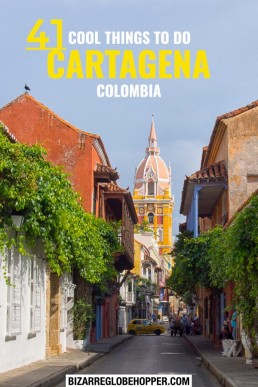
Recap: Expat Life in South Africa, Epic Safari, and Healing Pneumonia With Herbs
We’ve started a new expat life in Africa in last October, which has been nothing like we expected: historic highs and lows, struggles with bureaucracy, amazing wildlife sightings spiced with health issues, and getting used to the rhythm of Africa. Thus, we decided to share our (mis)adventures and lessons learned with a recap series from South Africa and Namibia.
From a Bitter Start in Johannesburg to Happy Safari Days in Kruger
Warning: this will be a rant. We’re positive people and consciously practice gratitude. Still, we can’t escape the fact that our first weeks in South Africa were an honest struggle. We didn’t like Johannesburg, at all. It wasn’t the South African expat life that we had dreamed about for so long.
It took me three weeks to learn to love Johannesburg, and Piritta hasn’t still warmed up a bit. It has never taken more than a week to like a destination. But more about that later.
A promise: this rant has still a happy ending. Our 16-day safari in Kruger was filled with fantastic animal sightings, and we scored some rare species that we’ve always wanted to see, like a honey badger and an aardvark!
Our 2,5-month stay in South Africa was closed with spending Christmas with an adorable Alaskan Malamute in Simon’s Town: it included a housesitting disaster, as well, but was generally sweet time walking in the mountains and watching penguins.
To balance our twisted relationship with Johannesburg, we loved Cape Town from the moment we saw Table Mountain. We spent a couple of happy days in Cape Town before and after our house-sitting gig in December. While we wouldn’t be excited to live as expats in Johannesburg, we would love to spend more time in the Cape Area next fall!
South African Visa Problems and Change of Plans
We were supposed to stay in South Africa for 4-6 months but realized that we couldn’t renew our tourist visas. We had also planned to get our driving licenses in South Africa, but it wasn’t possible with a tourist visa. So we had to change plans.
How I Get Tourist Visa Extension in South Africa?
Nowadays, South Africa gives only one-time 90-day tourist visas as a default, and there’s no way that you could prolong that tourist visa at the spot. The only option would be to return to your to home country and apply for a new tourist visa, but even then you might be turned down. People tell different stories about tourist visa extension processes, and the decision is always down to the individual border officer.’
However, there are some companies who can assist you with applying for a visa extension when you’re already in the country, but we’ve heard that even then it’s not guaranteed that you’ll get the extension. And the companies’ services are pretty expensive.
Can Digital Nomads Get a Work Visa in South Africa?
In case you’re wondering the other options for digital nomads, you cannot apply for a work visa without a South African employer, who would need to send you an invitation letter. Thus, South Africa is not a good option for self-employed digital nomads, who cannot get work visas.
As a tourist, you can generally enter South Africa only for those 90 days within one year. How strict! So we’re planning to return in October/November 2019 for an epic 1-2-month road trip. We just have to get driver’s licenses first here in Namibia – and buy a car!
Travel Disappointments in Maboneng, Johannesburg
We landed in Johannesburg in mid-October with an Airbnb-booking for two weeks. We had read about the hip inner-city suburb called Maboneng, which is also safe for tourists, so we decided to make it our first base in South Africa.
I had heard great things about Maboneng and was slightly disappointed with what we saw. These travel disappointments are a rare thing for me, as I usually like every destination already at the arrival.
Don’t get me wrong: Maboneng is a perfect sample of urban renewal and filled with great restaurants and nightclubs, world-class street art scene, fashion boutiques, and weekend markets. In the upcoming weeks, we’ll write another article about all the cool things you can do in Maboneng and surrounding Johannesburg.
Getting back to my rant: Maboneng is also an extremely tiny area and cramped with tourists, beggars, opportunistic pickpockets, noisy and drunken crowds, and pushy street vendors. I mean, the whole area is like 200 meters point 400 meters. Inside that area, you can walk rather safely as a tourist (even when talking on the phone or carrying a camera, although that’s not really recommended by the restaurant owners and locals).
Maboneng is a cool urban slice if you’re just spending one afternoon in Johannesburg. But after two days, we felt like prisoners. Maboneng was a way too small for us to live in for even two weeks – and we had planned to stay there for almost three months! It isn’t safe to walk outside the heavily patrolled Maboneng area (remember that tiny swatch), but I’ll get back to that later.
Weather in Johannesburg October to November: From Cold Nights to Perfect Summer Vibes
We were waiting for sunny summer days in Johannesburg, but in 2018 summer was late, and the whole October was chilly in South Africa. Usually, in October Johannesburg sees pleasant day temperatures from 18 to 24 C (64-75F), although night temperatures can fall near 10C (52F).
When we arrived, night temps were hovering around 4C and days were well below the twenties, although mostly sunny. Nothing to complain when you come from Finland other than our Airbnb apartment was freezing during the nights, which brought a persistent 2-week flu for both of us.
Imagine old factory building with leaking, single-glazed windows and balcony doors with 5 cm gaps between them and the floor. Nice natural ventilation system, but not very practical for freezing winter nights (temps were around winter averages for the first days of our stay). Old brick walls and cement floors are perfect for keeping hot summer weather out, but leave the apartments cold in winter.
We had a communication breakdown with our Airbnb host, who wasn’t willing to offer us a heater or wouldn’t allow us to buy a heater for keeping ourselves warm (electricity is expensive in South Africa). So, for the first night, we booked a hotel. Second night brought that terrible flu. On the fourth day, the host luckily lent us his gas heater, which solved the problem.
Weather in Johannesburg changed rapidly in November. We embraced the sun and hot days nearing 35C and were entertained by beautiful afternoon thunderstorms. It was the perfect African summer weather that we had been waiting for! Let’s open the next challenge.
Living Like Locals in Maboneng’s Rocket Factory
We were staying in the old rocket factory of Maboneng. The whole building is renovated into urban cool industrial flats. The location is perfect for a short holiday in Johannesburg, as the center of Maboneng (Main Street) is just a 2-min walk away.
Still, Rocket Factory lies slightly further from the noisiest night clubs and crowds partying at the streets of Maboneng every weekend. We needed earplugs only when the adjacent night club had bigger party nights.
After getting that gas heater, we liked the place. Our apartment had decent wifi, complimentary Netflix, ergonomic bed, working table and bar table (I always prefer the latter), espresso machine, plenty of hot water, and a balcony. Amazing health juice joint and the best sushi bar in Johannesburg were just 2-3-minute walk away, several nice lunch spots and the best café in Maboneng took 5 minutes to reach (I’ll list all those places in our upcoming article). What else could a digital nomad wish for!
Well, the balance to last. After one week’s stay, we got an early reminder of Africa. Rocket Factory lost all electricity and running water for a couple of days. Suddenly, we didn’t have wifi, lights, flushing toilet, or even water to wash our hands. The smell got soon disgusting, as it was summer already. We were lucky to check-in a nice hotel again but felt sorry for the locals.
Although the communication with our Airbnb hosts was terrible, after a couple of days we managed to get a refund, as we ended our stay due to the electricity and water shortage. Of course, it wasn’t their fault. The whole building was off the grid. We’re still grateful that they let us go.
Load Sheddings in South Africa
This accidental electricity shortage introduced us to the South African load sheddings, which are a completely different thing but equally annoying.
Load sheddings are scheduled electricity downtimes, which are driving South Africans mad. Country’s biggest electricity supplier Escom has a monopoly status, which it uses to save resources (money) to bribe regional officers, especially before Christmas time. In November and December, load sheddings (electricity blackouts) were almost daily and some times there were even several (and long) downtimes within one day.
Escom states that load sheddings secure the electricity supply and protect the power system from a total blackout. Locals disagree. You can read more about load sheddings here.
Where to Stay in Maboneng: Hallmark House Hotel and Apartments
In November, we rented Airbnb studio from Hallmark House. It’s a flagship hotel and residential building in Maboneng – and the only real 4-star hotel in Maboneng. For luxurious standard and deluxe rooms, we ended up paying just $30-60 per night through amazing deals on booking.com: check the current deals for your travel dates here!
We stayed in three different rooms in Hallmark House before renting a flat and loved them all! Most rooms have huge balconies overlooking the skyscrapers of Johannesburg, decorated with swinging chairs. Rooms are stylish, the beds are amazing, wifi is strong, breakfast is varied, and prices are super affordable compared to the other 4-star hotels in Johannesburg CBD. We’d definitely stay in Hallmark House every time we’ll visit Johannesburg.
The best thing: the rooftop terrace of Hallmark House has terrific views of the Johannesburg CBD area. We loved the rooftop gym (free for hotel guests and residents of Hallmark House) and used to do our Krav Maga trainings there. There’s enough space for training martial arts, yoga, or anything else on top of using the gym equipment. There’s also a rooftop spa, and they’re building a rooftop restaurant.
Is It Safe to Stay in Hallmark House, Maboneng?
Hallmark House is slightly further north from Maboneng, where its owner, property development company Propertuity, initially started to renovate old industrial buildings. Thus, the area surrounding Hallmark House is still not safe, although it’s merely 500 meters to the center of Maboneng.
Hallmark House Hotel offers a free shuttle service to Maboneng. The hotel itself feels extremely safe with 24/7 security. Apartments have a biometric fingerprint security system.
Propertuity is slowly taking over more buildings between Hallmark House and Maboneng, so in future also these streets will be patrolled and it would be possible to walk around freely. Luckily, Uber is affordable and easy to use, so we shuttled between the malls, sights, Maboneng, and Hallmark House almost daily with Uber drivers. We’ll list the best malls and sights in our upcoming Johannesburg article.
Healing Pneumonia in South Africa With Herbs, Mushrooms, and (Il)Legal Drugs
My condition was pretty bad for our first month in Johannesburg. I had pneumonia and declined to use corticosteroids to heal it, as I hate them. I tried to biohack my pneumonia away with my usual supplements, but they were not helping this time.
Luckily, I found a great herbalist in Johannesburg, who recommended me some traditional African herbs: Sutherlandia and Pelargonium. The latter is an African version of Pelargonium flower. I took them every two or three hours together with licorice root to heal my collapsed cortisol levels. I also took oxygen supplement many times a day and dropped my morning coffee to soothe my body with slight diet changes, as well (I had dropped also alcohol earlier, as it made me cough more). Within a couple of days, I felt slightly better already.
After four weeks, the symptoms got back, as my body got too used to these herbal supplements. I had to do some radical changes recommended by my herbalist. I changed the herbs to cordyceps, a weird Chinese medicinal mushroom, which I usually carry in powder format while traveling. I also started taking a couple of drops of FECO oil before going to sleep.
FECO translates into full extract cannabis oil. It was my first time using any cannabis oil, and I thought about it long and hard. I saw it as my last resort before giving up and starting corticosteroids.
Using FECO oil is legal in South Africa, but I still had to bought it under the counter. Due to high THC content, FECO oil is illegal in my home country, Finland, and in Namibia, where we were supposed to continue later. That made me anxious, but I’m happy that I had the courage to give it a try.
The new combination calmed my system so that I could sleep well again, which made the biggest difference in healing. Within one month, I felt almost normal, although breathing was still a bit difficult. Within two months, just before Christmas, I was completely healthy again and able to drop both FECO and that weird Chinese mushroom, cordyceps.
Many people have asked how cannabis oil feels. I never got high or felt intoxicated (what a disappointment) and just stopped using it when I felt healthy again. It made me a little bit drowsy sometimes, so falling to sleep was easier. When I woke up, I felt energized.
Long story short: I’ve biohacked harsh pneumonia before and use a lot of herbal remedies, so with a skilled herbalist I felt safe. I cannot recommend this to others, though. Please do not try this at home (or in Africa).
16-Day Safari in Greater Kruger National Park
The highlight of our time in South Africa – and the whole year – was an epic 16-day safari in the Greater Kruger National Park. I’ll keep it short here, as we will pour many articles about Kruger National Park shortly.
We were extremely fortunate to see honey badgers, an aardvark, and African wild dogs for the first time in our lives. All those elusive species had been on our wish list for many years, and we had traveled through five African countries without seeing a glimpse of them.
We did a 6-day safari with one tour company, staying at a beautiful tented camp with a private plunge pool and touring Kruger National Park, Greater Kruger, and a couple of nearby private reserves. That was when we saw two honey badgers and an aardvark within half an hour on one evening game drive. Aardvarks are so rare that even many rangers have never seen one.
Then we explored Balule Nature Reserve for six days staying in two separate camps at the different sides of the reserve. We photographed herds of elephants, witnessed lions mating, and observed many rhinos up-close: one male came so close to the back of our car that the people sitting at the back could have touched it (luckily no-one was sitting there, as that particular rhino was known for his temper).
We managed to see the wild dogs in Klaserie Private Reserve, where we stayed for two nights before exploring Kruger National Park again on a full-day safari. We finished off with Panorama tour: a gorgeous sightseeing route, which visits Blyde River Canyon, world’s third largest canyon, together with several breathtaking viewpoints and waterfalls.
A promise: All these destinations will be covered in separate articles very soon!
If you’ve been following our adventures, you probably know how we fell in love with Africa four years ago. These are among our best African adventures by far:
Trekking to the Endangered Mountain Gorillas in Uganda
Tracking Rhinos on Foot
White-Water Rafting in Zambia
Bungee at Victoria Falls
Canoe Safari in Zambia
Climbing Active Volcano in the Democratic Republic of the Congo
Help Us Spread the Word – Pin This Story!

Christmas Time in Simon’s Town and Cape Town: Sightseeing and House-Sitting
To keep up the good flow, we spent a couple of lovely days in Cape Town visiting Table Mountain, Robben Island, and other famous sights – it was our first visit in the Cape Area. We feasted with amazing vegetarian food, hung out in cool cafes, and gulped down craft gin cocktails and craft beers (I was healthy – I could drink alcohol again!). We’ll list all our favorite spots in a separate article.
We had been waiting for our Christmas house-sitting gig for many months; it was one of the reasons that had brought us to South Africa. Just two days before the start, we heard that our host had messed up and double-booked us and another couple.
I don’t want to go into details here, but maybe I’ll write more about our house-sitting experiences later; we’ve also had amazing stays. In the end, this case turned out just fine and we were the only ones staying with the beautiful Alaskan Malamute girl.
We spent eight happy days walking in the mountains and beaches with our new furry friend – and watching penguins together. Oh yes, she was totally blasé about the penguins. Our favorite evening walk went through (free!) penguin beach (we’ll list our favorite spots in Simonstown in a separate article).
New Adventures in Namibia: 2-Week Road Trip, Driving School, and Volunteering
We left South Africa behind at the end of December to spend New Year in Namibia, where we are currently. A lot has happened since, but I’ll wrap our (mis)adventures in Namibia into another recap. We’ve just returned from a mindblowing 2-week road trip to craft another happy ending. Tomorrow we’ll embark on another adventure, volunteering in the wildlife rehabilitation center and taking care of pangolins!
Stay tuned for more African expat life hits and misses, driving school mishaps, lovely dogs and a kitty cat doppelganger, bureaucracy, wildlife, and chasing the dreams! Follow us on Facebook for real-time updates and Instagram for Piritta’s gorgeous wildlife pics. See you in the wild!
6 Exciting Sabah Itineraries: 3-5-Day to One-Week Trips in Sabah, Borneo
Sabah itineraries can be tailored to different kinds of Borneo adventures, emphasizing either orangutans and other wildlife, beaches, rainforest hikes, river cruises, or cool colonial city getaways. Choose from six exciting routes ranging from 3-5-day stay to one-week itineraries. Read on to find the best destinations for your interests and budget – and start planning your trip to Sabah, Borneo!
After checking out our ultimate 2-week itinerary through Malaysian Borneo, several people have asked us where to go in Borneo if having only one week or even 3-5 days to spare. Our answer is clear: pick only one area in Malaysian Borneo and make it Sabah!
All these short Sabah itineraries have now been field-tested by our readers and we’ve received raving reviews.
Can You Really Visit Sabah In Just 3-5 Days?
Of course, crafting just a 3-5-day itinerary in Sabah is a hardcore task. To be realistic, you need to select which highlights of Sabah you’d like to experience if your time is limited to one week or less. If you have 2 weeks or more, please check our complete 2-week Borneo itinerary (link above).
The other warning: excluding Sarawak is not fair play – go there if you can expand your trip to Malaysian Borneo. We also love Kuching, so we made an extra itinerary for those who’d prefer Sarawak: check it out here to make the tough choice between Sabah and Sarawak.
All the same, all these short Sabah trips have the potential to be just that elusive trip of a lifetime! You can pack amazing things in 3-day itinerary in Sabah: orangutans, sun bears, proboscis monkeys, river cruises, and rainforest hikes to name a few.
This Article Contains Six Sabah Itineraries
1. Short Sabah Itinerary With Orangutans: Kinabatangan River, and Sepilok (3-5 Days)
2. Sabah Trip in the Real Wilderness: Danum Valley (3-5 Days)
3. Diving or Snorkeling Trip in Sabah: Lankayan Island (3-5 Days)
4. One-Week Sabah Itinerary “Orangutans, Sun Bears, and Colonial Charm”: Kinabatangan, Sepilok, Sandakan, and Kota Kinabalu
5. One-Week Sabah Itinerary “The Ultimate Orangutan Encounter”: Danum Valley, Kinabatangan River, and Sepilok
6. One-Week Sabah Itinerary with Orangutans And Turtles: Lankayan Island and Kinabatangan River
1. Short Sabah Itinerary With Orangutans: Kinabatangan River and Sepilok (3-5 Days)
Our first itinerary is a classic for a short vacation in Borneo. Choose this trip if you want to see as much as you can in just 3-5 days and are not afraid of long travel days.
I dare to give your Sabah trip “an orangutan guarantee” since you start your adventure in Sepilok’s world-famous Orangutan Rehabilitation Centre. During feeding times, you can watch behind a glassed wall as orphaned baby orangutans come to feast on bananas and play recklessly. Adults move freely inside the reserve, but a handful of them seem to swing to the feeding platforms like clockwork.
While in Sepilok, be sure to visit sun bear sanctuary, as these smallest bears in the world won’t cross your path in the wild. Check out our things to do in Sepilok article for further inspiration.
The real adventure awaits you at Kinabatangan River cruise. Squeeze the best of the Bornean jungle in just two long days. The chances to spot wild orangutans in their natural habitat are highest in Kinabatangan: we were lucky to see six orangutans in only one day!
Book a tour combining Abai and Sukau areas for all-round rainforest experience in Sabah. Wake early to take misty morning cruises, enjoy al-fresco jungle breakfast, and take guided or independent walks inside rainforest on elevated pathways. Sunset wildlife cruise was our favorite, as we were lucky to spot also the rare pygmy elephants! Check out our 2-week itinerary for further details.
Getting to Sepilok and Kinabatangan
Take a cheap 45-minute flight from Kota Kinabalu to Sandakan, from where it’s another 30 minutes by car to Sepilok. Bus from Kota Kinabalu to Sepilok is a waste of time, as you have much to explore.
Pros of This Sabah Itinerary
- Fantastic river boat jungle adventure with potentially several up-and-close encounters with orangutans and proboscis monkeys – and even pygmy elephants if you’re lucky!
- Affordable Sabah vacation and rainforest adventure if you compare to Danum Valley.
Cons of This Sabah Itinerary
- Danum Valley offers more genuine rainforest experience without crowds. But in Danum Valley, the wildlife sightings are more rare and distant.
- No beach, snorkeling or diving this time.
- No colonial city vibes – unless you combine one night in Kota Kinabalu, but it’s still a pale shadow of Kuching. Sepilok isn’t even a village; it’s more like a cluster of hotels and houses by the highway, but it’s still much pleasant to stay near rainforest and wildlife sanctuaries in Sepilok than staying in the city of Sandakan.
2. Sabah Trip in the Real Wilderness: Danum Valley (3-5 Days)
This is hands down our personal favorite for a short vacation in Sabah, Borneo. The itinerary combines exciting activities and wildlife encounters with ultimate relaxation.
Danum Valley is the last haunt of Borneo’s primary rainforest and paradise for any nature lover, naturalist, and photographer. Inside one of the most complex ecosystems on this planet lies just one five-star lodge, which gives you exclusive access to the centuries-old rainforest.
Take hikes under 70-meter tall rainforest canopy to meet a long list of its exotic residents, including orangutans. Complimentary activities include night drives and walks, exclusive rainforest canopy walkway, swimming and tubing in the clear Danum River, and fish massage in the natural jacuzzi pool.
We managed to spot six wild orangutans and the rare pygmy elephants, together with civets and other nocturnal creatures, flying squirrels, several species of monkeys, frogs, birds, and reptiles. Our readers have reported equally amazing wildlife encounters within just three days in Danum Valley: this Sabah trip won’t let you down.
Among our favorite moments were the serene breakfasts and evening drinks at the terraces observing the surrounding rainforest. If I needed to choose just one location in Borneo (or in Sabah), it would be Danum Valley for its off-the-grid remoteness and pristine primary rainforest. If you’re ready to fall in love, check our complete guide on Danum Valley.
Getting to Danum Valley and Further Tips
You need return flights from Kota Kinabalu to Lahad Datu to make this Sabah trip work smoothly. The 2-hour jeep drive deep into Danum Valley Conservation Area is included in the prices of Borneo Rainforest Lodge.
Please allow at least three nights for the magic of Borneo Rainforest Lodge – and even more if you can afford.
Note that depending on your international flights, you might need to spend a night in Kota Kinabalu at either end of your trip. Please check the domestic flight times before booking your Danum Valley package. Check the itinerary 4 for inspiration on things to do in Kota Kinabalu for one day.
Pros of This Sabah Trip
- The most authentic way to experience the real Borneo if you ask me!
- Exclusive night safari drives
- Exclusive access to the amazing treetop canopy walkway
- Once-in-a-lifetime experience – go for it!
Cons of This Sabah Trip
- Costs: staying at the lavish Borneo Rainforest Lodge and those private walking safaris don’t come cheap
- No colonial city vibes – unless you combine one night in Kota Kinabalu
- No beaches or underwater treasures this time
Kinabatangan River, Danum Valley, and Sepilok Orangutan Rehabilitation Center are among the best places to see orangutans in Sabah. Check this article for further tips on where to see orangutans in Borneo, how to behave near them, and learn more about these orange-furred creatures!
3. Diving or Snorkeling Trip in Sabah: Lankayan Island (3-5 Days)
If snorkeling is your thing, then Lankayan Island is your best bet in Borneo. Snorkeling is out of this world already at the jetty and gets even better after a short boat ride.
Lankayan is also a favorite of many divers, as it’s much more secluded than the famed and thus overcrowded Sipadan. It’s a famous macro diving destination with also wrecks and rare species, such as jawfish and ever elusive leopard shark. Or if you’re just looking for a romantic setting by the turquoise ocean, this uninhabited paradise island must have been whisked into the Sulu Sea just for you.
Did I already mention the turtles? I almost dare to guarantee that you can swim with the turtles – and friendly sharks! – right at the jetty. Lankayan is also a nesting site for sea turtles, where you can watch both nesting and hatching. Check our complete article on Lankayan Island if you’re still not convinced!
The best news for people planning a short Sabah trip: it’s much easier to visit Lankayan than Sipadan. You don’t need to apply for any diving or snorkeling permits. The transits are shorter and cheaper, and it’s easy to add Sepilok’s wildlife sanctuaries to your itinerary.
Getting to Lankayan and Further Tips
As time is short, take an internal flight to Sandakan. Lankayan Island Dive Resort (the only accommodation option in Lankayan) will pick you up from the airport. Reaching Lankayan requires 1,5-2-hour speedboat trip. All-inclusive prices of Lankayan Island Dive Resort cover transfers from Sandakan.
Personally, I’d stay at least 3 nights on Lankayan Island, otherwise, it makes no sense to venture that far to the sea.
If you have 5 days to spare and yearn to see orangutans, stay one night in Sepilok and visit the orangutan sanctuary, it’s well worth it! Sepilok is only 30-minute drive from Sandakan airport, and the lodges usually offer the transfers.
Pros of This Sabah Trip
- The best snorkeling in Borneo and interesting macro dives
- Swimming with the turtles
- Mellow island vibes: the whole family will love this paradise!
- Guaranteed relaxation
- Honeymooners: Lankayan is your dream destination in Borneo!
Cons of This Sabah Trip
- No orangutans unless you include Sepilok’s Orangutan Sanctuary – but that’s more than easy if you have 4 days to spare! Don’t forget Sepilok’s another added bonus: the sun bear sanctuary!
- No jungle adventures, but hey, you had a tough choice to make!
4. One-Week Sabah Itinerary: Kinabatangan, Sepilok, Sandakan, and Kota Kinabalu
This one-week Sabah trip is based on our itinerary 1: spend four to five blissful days in Kinabatangan River and Sepilok meeting the orangutans and proboscis monkeys in the wild and visiting sun bear and orangutan sanctuaries, breathing the fresh air and taking short rainforest walks.
Expand the original 5-day Sabah trip by spending one night in Sandakan either before or after your Kinabatangan River cruise. Indulge in local cuisine and small-town feel of Sandakan, have rooftops drinks, eat dinner by the shore with locals and sample fresh seafood in Sim-Sim water village if you still have room.
Stay one to two nights in Kota Kinabalu in the beginning or end of your trip, depending on your flight schedule. Take a walk in Kota Kinabalu waterfront, do some souvenir shopping, visit night food market, and dine by the shore. If you’re in the city during Sunday, check out Sunday morning market on Gaya Street.
If your schedule allows, visit the islands of Tunku Abdul Rahman Marine Park (20-min boat ride away from the center of Kota Kinabalu). Swim, snorkel, dive, or soak in the sun with a tropical drink in your hand!
Transfers On This Sabah Trip
You need return flights between Kota Kinabalu and Sandakan. It’s just 30-min flight but check that your international flights leave enough time for transfer (at least 2-3 hours would be our suggestion). Taxis cut the distance between Sandakan and Sepilok in 30 minutes.
Kinabatangan packages include river transfers between Sandakan and the lodges in Kinabatangan River. You can usually include a one-night stay in Sepilok in your package with sanctuary visits and transfers. You can also visit Kinabatangan independently, but finding rides between Sandakan and the lodges of Kinabatangan might be an issue (if your lodge doesn’t organize transfers).
Where to Stay in Sabah, Borneo
We listed the best hotels in Borneo: Find unique lodges for your Sabah trip!
5. One-Week Sabah Itinerary “The Ultimate Orangutan Encounter”: Danum Valley, Kinabatangan River, and Sepilok
This one-week Sabah itinerary combines luxurious Danum Valley rainforest adventure (itinerary 2) to river cruise down Kinabatangan River (itinerary 1) to spot even more orangutans and proboscis monkeys, and even pygmy elephants if you’re lucky.
Start your trip in Sepilok with orangutan and sun bear sanctuary visits – this Sabah trip has orangutan guarantee! Sepilok is the best place to rest after a long flight and gives an exciting introduction to the rainforests of Borneo.
If your flights require so, finish off with a colonial city break in Kota Kinabalu. This might also allow a short beach getaway in Tunku Abdul Rahman Marine Park with snorkeling, so it’s not a bad ending to orangutan itinerary!
Transfers On This Sabah Trip
If your international flight schedule allows, start your Sabah trip in Sepilok. Take a short internal flight from Kota Kinabalu to Sandakan, from where you Sepilok lodge will pick you up (it’s just 30-min drive).
Kinabatangan River cruise packages usually include transfers to and from Sepilok/Sandakan. Confirm this with your tour company.
Book a road transfer from Sukau (Kinabatangan) to Lahad Datu, where Borneo Rainforest Lodge has an office. The rates of Borneo Rainforest Lodge include road transfers between Lahad Datu and Danum Valley.
Book a short internal flight from Lahad Datu to Kota Kinabalu. If the flight times match nicely and you can just hop on to your international flight, smile and stay an extra night either in Kinabatangan or Danum Valley. If flight schedule requires, stay one night in Kota Kinabalu. Check the previous itinerary for a recap on Kota Kinabalu.
6. One-Week Sabah Itinerary with Orangutans and Turtles: Lankayan Island and Kinabatangan River
With this one-week Sabah trip, you should follow our itinerary 3 and just add 2-3-day Kinabatangan River cruise (itinerary 2) and a one-night stay in Sepilok.
All the destinations are already covered in above itineraries, so please check them and our separate articles on Lankayan and Kinabatangan if this sounds like your dream trip in Sabah.
Safety in Sabah: Is Sabah Safe for Tourists in 2019?
Many travelers heading to Sabah – or Malaysian Borneo in general – have concerns about safety in Sabah. I’d love to tell you that Sabah is 100% safe for tourists in 2019, but that’s a big claim to make nowadays about any country. However, I consider Malaysian Borneo as a safe destination for any tourists with common sense and would recommend Sabah to my friends and family as a safe destination.
We visited Lankayan Island and Eastern Sabah despite travel warnings by UK and US governments. Please always check the current warnings before making plans and consider whether you’re willing to travel in affected areas.
Current travel warning against “all but essential travel” to the Eastern Sabah and the islands including Lankayan, Sipadan, and Pom Pom is based on old kidnappings in the area. In my opinion, governments could give similar warnings about most Asian or African countries based on the current security situation.
The latest kidnapping in Sabah took place in Sandakan in 2015, when two Malaysian nationals were abducted. I’d consider the Philippines’ side of the Sulu Sea more dangerous than the Malaysian side. Still, this is my personal opinion, and I recommend that you’d check the current UK travel advise from here and the current US travel warning from here.
Vaccinations for Sabah, Borneo
Your routine vaccinations should be up to date before traveling to Sabah, Borneo. With routine vaccinations, I mean the usual travelers’ bunch: tetanus, typhoid, rabies, hepatitis A (and preferably also hepatitis B). There is no yellow fever risk in Malaysian Borneo, but they do require a certificate if you’re traveling from the country with yellow fever risk (but then you will already have the certificate, as well).
There is also a risk of dengue fever in Sabah and in Malaysian Borneo in general, like many other places in Asia. Try to avoid mosquito bites between dawn and dusk to be safe. There is no vaccination for dengue.
Malaria in Sabah: Do You Need Malaria Medication for Borneo?
Malaria risk in Sabah is very low. We didn’t have malaria medication in Sabah. The highest risk areas in the inland of Sabah are still labeled as “low malaria risk areas.” Governments recommend “malaria awareness and bite awareness” if you’re traveling into forested inland areas of Sabah. Usually, malaria medication is not recommended, but please talk with your doctor to make your own decision.
Check here the further advice on Travel Health Pro’s website about vaccinations and malaria risk in Sabah.
Please let me know if you have any questions. I hope you have now found your favorite itinerary and can start planning your Sabah trip!
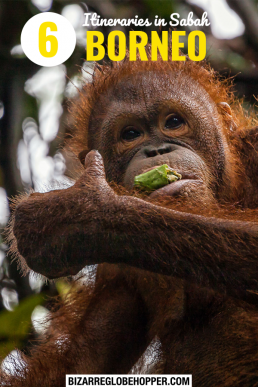
The Ultimate Guide to Mostar’s Old Bridge: Bridge Jumping, Legends, and Ghosts of War
The white-marbled Mostar’s Old Bridge arches upon rapidly flowing Neretva River, as a symbol of peace and hope. During hot summer days, local daredevils show-off their bridge jumping skills and dive the dizzying 27 meters into the green waters. Just before sunset, the cream-colored stone surface of Stari Most turns golden, shimmering upon the beautifully renovated old town of Mostar. In the evening haze, legends and ghost stories come alive.
Mostar Old Bridge: The Soul of Mostar
The Old Bridge, Stari Most, is the heart and soul of Mostar: it’s the playground for local kids, lovers gazing at sun dipping below the banks of Neretva, bridge jumping adrenaline junkies, and souvenir shopping tourists. Even the best ice cream in town is served right beside Stari Most – and best enjoyed on the bridge.
The Old Bridge of Mostar has been an essential part of Mostar’s history right from the beginning. Mostar was even named after the bridge keepers (mostari). For hundreds of years, the Mostar bridge has stood as an icon of multicultural coexistence, connecting the east bank’s Muslim and west bank’s Catholic communities. Ironically, it was a war that finally destroyed this symbol of peace. But let’s dig deeper into the history and tragic legends of Stari Most!
The Birth of Mostar Old Bridge (Not Without Grave Digging)
The city of Mostar was built on the lap of green Neretva River and flourished as an Ottoman frontier town in 15th and 16th centuries. Mostar was developed further during the Austro-Hungarian period in the 19th and 20th centuries.
The first bridge in Mostar was built by the Turks, under the command of Suleyman the Magnificent, already in the 16th century. After nine years of labor, the Old Bridge of Mostar was finally completed in 1566. The bridge was drawn by a famous architect, Mimar Sinan, and constructed by his student Mimar Hajruddin. Sinan was the chief Ottoman architect of Suleyman the Magnificent. His students later designed the Blue Mosque in Istanbul and helped to create Taj Mahal.
Legends tell that the architect, Mimar Hajruddin, had to make it or break it. The Ottoman sultan was so tired of unsuccessful bridge building attempts that he threatened to execute every failing architect. Before the wooden supports of Old Bridge were removed, Mimar Hajruddin had already started digging his own grave. Luckily, his work was celebrated as the widest man-made arch in the world!
Destruction and Resurrection of Stari Most – From War Relict to UNESCO World Heritage Site
The original Stari Most managed to stand for staggering 427 years, through two world wars. As a part of 1990 Croat-Bosniak conflict, the Old Bridge of Mostar was bombed down by the Croat troops in 1993.
With the help of UNESCO, Mostar Bridge was rebuilt in 2004, stone by stone and according to the original architecture. Even the initial flaws were honored. Some of the original limestones were rescued from the bottom of the Neretva River to celebrate the resurrection of Stari Most. So technically, the current bridge is not “old”, but it’s still a replica of the old bridge. Still, it’s a stunning landmark and icon of peace known all over the world.
Old Bridge Area of the Old City of Mostar was declared as Unesco World Heritage Site in 2005. The Old Bridge of Mostar is among the most important Islamic architectural structures in the Balkans. The surrounding Stari Grad, the Old City of Mostar, is a perfect example of a historically important multicultural town with pre-Ottoman, eastern Ottoman, and Mediterranean architecture.
Mostar Bridge Jumping Ritual: It’s How Bosnian Boys Become Men!
According to history books, the first person jumped off Mostar bridge already in 1664.
Yes, it’s a Bosnian legend: jumping off Mostar Bridge is how a boy becomes a man in Mostar! Crazy locals claim that boy is not worth of girlfriend or job without having the balls to jump off Stari Most. After all, jumping of Mostar Bridge is a 450-year old tradition.
Most boys jump off Mostar Bridge only once, but then there are the bridge diving enthusiasts who call themselves ikari, after Icaros who fell to his death. Even the local diving club is named Mostarski Ikari. Evidently, they acknowledge the risks of bridge jumping and take great pride in their courage.
Mostarski Ikari Diving Club has been officially operating since the end of the war in 1995. Back then the iconic stone bridge was collapsed, but it didn’t hold them back. The diving club installed a platform beside the temporary suspension bridge and carried on with their annual bridge diving competition. July 2018 marked 452nd annual Mostar bridge diving competition.
During the summertime, the diving club members take turns in jumping off the bridge for money. It’s a fair deal, as eager tourists are willing to pay for the show and pictures, and the diver still risks his life for the thrill. They know how to tease the crowds to gather the next 25€ to qualify a jump. The art of bridge diving is entertaining to watch, so why not to support a diver and the club.
How to Organize Mostar Bridge Jump
While bridge jumping from Stari Most has become increasingly popular among adrenaline-thirsty tourists, I wouldn’t do it or even recommend it. Local ikari know the art of bridge jumping – and the risks. Of course, tourists are briefed for jumping off safely and accustoming their bodies to the cold.
Still up to it and ready to leap? You might want to read the next chapter about the hazards of jumping off Mostar Bridge – or any bridge – before making the decision. Many tourists have also had a change of hearts before seeing the bridge and standing up there looking down: 24-28 meters doesn’t sound like much, but it looks daunting for sure.
If you’re still willing, organizing Mostar Bridge jumping is easy. Mostarski Ikari Diving Club organizes all bridge jumps for adrenaline rush seeking tourists. There are always a couple of guys from the dive club hanging around the bridge – and they’re usually wearing swimming suits.
How’s the jump, then? Well, you will splash against the green Neretva River in 3 seconds after jumping off Stari Most. Your short flight has a speed nearing 80 km/h. Water temperature hardly ever reaches 10 degrees, so it will be a cold dip for sure.
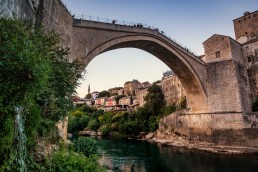
Step-By-Step Mostar Bridge Jumping Guide for Tourists
- After settling a deal with Mostar diving club, the bridge jumping candidate is given a short briefing and a wetsuit to fight the coldness of Neretva.
- Then, each candidate must practice safe jumping at a 10-meter high training platform downstream from Stari Most. Proper bridge jumping technique needs get approved: at first, you’ll get a couple of jumps to prove that you can do it. More is required if the diving club instructor isn’t convinced.
- After getting approved to jump, the diving instructor takes you back to the Old Bridge and confirms that you’re 100% up to the challenge.
- Then, the instructor helps you through the crowds to the middle of the bridge and helps you climb over the railing.
- Before jumping off, listen to your diving instructor’s final orders and take deep breaths.
- When you jump, widen your arms like wings and hold your core tight, keeping legs together.
- Before hitting the water, bring arms tightly towards your body (and protect your precious body parts). Keep your form: be careful not to lean backward or forward.
- When you hit the water, remain calm and try to regulate your heart rate and blood pressure. Swim to the shore, where diving club members are already waiting for you, ready to help you out of the cold water.
The jump costs 35€ (10€ for the training and 25€ for the Old Bridge jump). You’ll be credited with a certificate and your name is written the Diving Club record book.
You’ll also be a lifetime member of Mostar Diving Club – meaning that you can jump off Stari Most as many times as you wish!
The Risks of Bridge Jumping: Deadly Accidents in Mostar
Many locals can tell you openly that it’s definitely not safe to jump off Mostar Bridge. When calculating risks, I usually ask how many people have died doing so (that was my main concern with Victoria Falls Bungee, as well, though I ended up doing it anyway).
Yes, people have died jumping off Mostar Bridge. At least four deadly accidents are reported since 2012, along with countless serious injuries.
Most Common Injuries of Bridge Jumping in Mostar
Risk of injuries is high, and even higher when the water level of Neretva River is at its lowest during the summer. There are rocks and branches beneath the bridge and currents can be strong. When the river is low, the height of the bridge can be up to 28 meters, while during spring the height can be “only” 24 meters.
Severe bruising is the most common injury, but too many people also tell about broken bones, dislocated limbs, and even spine injuries. While many blogs claim Mostar bridge jumping safe, YouTube is full of videos of jumps gone bad by unlucky tourists.
How To Prevent Bridge Jumping Injuries in Stari Most
Be careful at the bridge and only jump when you’re ready to do it in a good form. Slipping is dangerous because then you cannot prepare your body for hitting the water. 27-meter jump is not a joke. You must hit water properly to avoid injuries: that’s what the training is all about. The injuries, such as broken bones, could get you into serious trouble in the water.
Most tourists prefer to jump feet first, which is safer if you’re not super confident in diving head first. There’s only one really big but: locals told us that jumping feet first might cause hitting legs at the bottom. Please make sure that the water level is high enough before planning your bridge jump.
Be prepared to the cold river and wear a wetsuit if it’s provided – or just bathe in cold water. Neretva is among the coldest rivers in the world. At least one of the Mostar bridge jumping deaths was caused by heart attack: the contrast between a hot summer day and nearly freezing water can take its toll even for a healthy person.
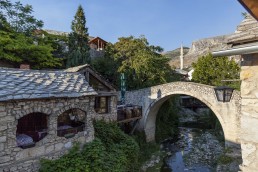
Is Mostar Haunted by Ghosts of War and Tragic Incidents?
Some locals call Mostar “the ghost town, haunted by itself”. The Old Bridge is certainly a haunting sight after dark when day-tripping tourists are swept away, and only occasional locals traverse the stone arch. While walking on Mostar Bridge at night, a cold gust of wind made me feel chilly from inside, as I pictured the horrendous incidents this old bridge had witnessed through its 450-year history.
During the Bosnian conflict, 100 000-200 000 people were slaughtered, mainly on the streets of Sarajevo, Mostar, Srebrenica, and Banja Luka. It was ethnically rooted civil war, were neighbors and loved ones were set against each other.
In Mostar, the Old Bridge marked both the divide and the connection between the Bosniaks, Croats, Serbs, and Yugoslavs. The first Siege of Mostar was fought in 1992; the second Siege of Mostar lasted from 1993 to 1994. In June 1992, the Serbs destroyed all other bridges in Mostar but Stari Most, leaving it as the only gateway across Neretva. In the second Siege of Mostar, the Old Bridge was used for combat on the front line, until Croats shelled it on 9th of November 1993.
In the aftermaths of war, Mostar was credited as “the most heavily destroyed city in Bosnia and Herzegovina”. In the Bosnian parts of Mostar, around 60-70% of houses were totally destroyed or badly damaged. The scars of war run still deep and bullet-ridden facades can be seen around Mostar, especially in the eastern part.
I bet hundreds of agonized souls have jumped off the bridge to their death and even greater number of civilians are raped and murdered during the wars. I wonder how many mostaris, guardians of the bridge, also roam in the grounds with other restless souls. While many locals say that the Old Bridge is haunted, to our misfortune we didn’t catch any ghost stories. If you’ve heard about the ghosts of Mostar, please share the stories in the comments below!
Best Things To Do in Mostar (Around Mostar’s Old Bridge)
You don’t need a plan to visit Mostar Bridge: just go there and everything will get to you.
- Admire local handicrafts and shop jewelry: both sides of the bridge are covered with souvenir stands.
- Pick the best Italian gelato in Bosnia from a stand stating so. Take pictures and indulge in the spirit of Mostar.
- A little café occupies the tower at the west bank of the bridge: it’s the best place to observe the buzz upon the bridge and see bridge divers fly. The western tower is called Halebija: along with the café, it hosts also the Mostar Diving Club and city art gallery.
- There’s another tower at the eastern end of Stari Most called Tara, where’s the Museum of the Old Bridge.
- The two observation decks below the bridge are the best spot for photographing and admiring the bridge jumps. Find your way down to the riverfront through the café and restaurants at the western end of Stari Most, immediately on your right before stepping at the bridge.
- Explore Stari Grad, the old town of Mostar at the east bank of Neretva. Though beautiful old buildings are scarred by war and most of them host restaurants and souvenir stands for tourists, the charming Ottoman atmosphere remains. The old town is still populated by Bosnians, while there are lots of Croats living in the western Mostar.
Alternative to the Old Bridge: Crooked Bridge of Mostar
A smaller Ottoman-era stone-arch bridge named Kriva cuprija, the Crooked Bridge, crosses one of the tributaries of Neretva just a stone throw away from the Old Bridge. The Crooked Bridge looks like a miniature of the Old Bridge.
Just like its big brother, also this ancient bridge was also destroyed. Floods swiped away much of its footpath in December 2000, but once again UNESCO came to help and restored the Crooked Bridge to its former glory.
Crooked Bridge is just a 5-minute stroll away from the Old Bridge and surrounded by restaurants. One of the terraces makes a perfect dinner spot. Pop in the pub at the eastern end the Crooked Bridge for craft beer at the terrace overlooking the bridge.
How to Get to Mostar From Sarajevo or Dubrovnik (By Train, Bus, and Car)
Mostar is 140 kilometers (87 miles) south of Sarajevo, the capital of Bosnia. Dubrovnik is 81 kilometers (51 miles) away. Driving from Dubrovnik takes around 2,5 hours, while the bus takes around 3,5 hours. Driving from Sarajevo to Mostar takes around 1,5-2 hours, while the buses take around 2,5 hours.
I strongly recommend taking a train from Sarajevo to Mostar, as it’s among the most scenic train travels in the world. The rails were reopened in 2017. New Talgo trains are comfortable and have even free wifi! Check out our article on this gorgeous trip by train from Sarajevo to Mostar! The trains run all the way to Capljina near the Croatian coast, from where you can take a bus to Dubrovnik, Split, or Makarska.
Where to Eat in Mostar
To be frank, all traditional Bosnian restaurants in Mostar were rather weak in our opinion. If you love meat, you might disagree, though. The national plates, which consist of sausages and grilled meat, come at around 15-20 KM (7,50-10 €) and easily quench the hunger of two. Many restaurants offer million-dollar views to the Old Bridge of Mostar, which alone qualifies for a romantic dinner.
The best traditional restaurant in Mostar according to our inspection is FoodHouse on the western bank of Neretva, appr. 100 meters from Stari Most. We had awful experience in Sadrvan, which is usually listed among the best restaurants in Mostar (it’s a tourist trap serving bland and overcooked food).
Pekaras (bakeries) offer the traditional Bosnian pies and pastries filled with either meat, cheese or spinach, so if you haven’t tasted them, do it in Mostar!
If you have you been in Mostar, please share with us your best tips for exploring and photographing the Old Bridge and surrounding Old Town of Mostar!
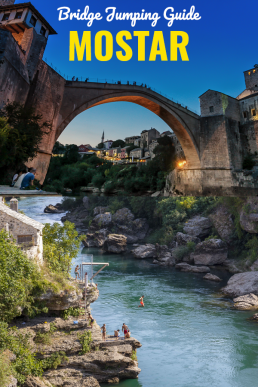
Where To See Orangutans in Borneo: The Best Places For Wild Orangutans And Sanctuary Visits
It’s easy to see orangutans in sanctuaries around Borneo, but you need a little more planning and luck to find wild orangutans. Check our list of the best places to see orangutans in Malaysian Borneo! Each of these orangutan destinations has its pros and cons regarding logistics, lodging and, of course, the scale of wilderness and ease of spotting the wildlife.
Summary: The Best Places to Stay to See Bornean Orangutans
Best Places to See Orangutans in the Wild
- Kinabatangan River: Sukau Area, Sabah, Malaysian Borneo
- Danum Valley Conservation Area: Borneo Rainforest Lodge, Sabah, Malaysian Borneo
- Tabin Wildlife Reserve, Sabah, Malaysian Borneo
- Batang Ai National Park, Sarawak, Malaysian Borneo
- Tanjung Puting, Kalimantan, Indonesian Borneo
Best Places to Visit Orangutan Sanctuaries
- Sepilok, Sabah, Malaysian Borneo
- Kuching, Sarawak, Malaysian Borneo
1. Kinabatangan River, Sabah
The Best Orangutans Sightings in Borneo
Sungai Kinabatangan aka Kinabatangan River offers the easiest and most frequent sightings of wild orangutans. Kinabatangan is the second longest river in Malaysia, expanding 560 kilometers from the mountains of Sabah to the Sulu Sea. Kinabatangan’s northern banks have some of the highest concentrations of wildlife in Southeast Asia.
Our Orangutan Experience in Kinabatangan River
During just one day, we spotted six wild orangutans in Kinabatangan. For us, the up-and-close orangutan sightings on Kinabatangan were the best we had in Borneo.
But orangutans are just a part of the spell here. Mornings start with a cruise when mist wraps the jungle in the fairytale-like gown and the sounds of jungle promise exciting discoveries. We loved observing packs of wild proboscis monkeys, built a love-hate relationship with the mischievous macaques, laughed at the wild pigs who charged us during our jungle hike, and visited the seventh heaven for spotting the rare pygmy elephants on the water’s edge amidst thick vegetation.
Check out these amazing itineraries in Sabah and start planning your trip!
Getting to Kinabatangan River
Fly, drive, or take a bus to the city of Sandakan. All Kinabatangan tours start from there and include return transport. Booking a guided tour to Kinabatangan is your best bet, as most lodges are owned by tour companies. It’s possible to drive to Sukau independently, but we would rather recommend boat travel from Sandakan to Sukau, as that way you’ll see more – and have a chance to see orangutans also during the transfer!
Pros and Cons of Kinabatangan River as Orangutan Destination
-
- Orangutan sightings are frequent: the best place in Borneo to photograph wild orangutans!
- Narrow wildlife corridor makes it easy to spot wildlife, but the core message is sad: animals are forged too close to villages and cannot really avoid confronting civilization.
- Sukau area feels crowded with tens of lodges and loads of boats cruising the river in the hunt of the orangutan sightings, so prepare to share some of the sightings with other boats. Abai area has fewer tourists, but more local houses and fewer wildlife encounters.
- Extensive logging has disrupted much of the ecology. Palm oil industry lurks right behind the corner if you leave Sukau by road.
- Added bonus: Sukau area boasts good chances to spot the Bornean pygmy elephants!
- Budget accommodation is widely available and independent travel is possible, unlike in all the other wilderness destinations listed below.
2. Danum Valley, Sabah
Best Place to See Wild Orangutans in Borneo
Danum Valley is the wildest place on earth where you can spot Bornean orangutans. By wildest I mean the real, virtually untouched wilderness. Danum Valley Conservation Area is the last stronghold of primary rainforest in Borneo and the largest area of undisturbed lowland dipterocarp forest in Sabah. Here the trees are 70 meters tall and wildlife you encounter spend the majority of their time further in the heart of the protected primary forest, where no modern man has stepped.
Seeing wild orangutans in Danum Valley is an exclusive, once-in-a-lifetime experience. There’s only one hotel, the award-winning Borneo Rainforest Lodge with just 30 luxurious chalets. It’s a paradise for naturalists, birders, and nature photographers. You will live inside the vast home of orangutans and other wildlife: Borneo Rainforest Lodge is Borneo’s only hotel, which lies inside the primary forest. Orangutans had slept right upon our chalet the night before we arrived!
How to Get to Danum Valley
Fly in Lahad Datu from Kota Kinabalu (one hour). The adventure begins with a complimentary 2-hour jeep transfer inside Danum Valley Conservation Area: we managed to see a herd of the rare Bornean pygmy elephants during both drives!
Pros and Cons of Danum Valley as Orangutan Destination
- The price of the Danum Valley orangutan experience is rather steep – but well worth the splurge! Orangutans are truly wild and thus not used to people: don’t expect close encounters
- Night drives and walks available
- A vast network of hiking trails inside the primary rainforest for hiking and spotting wild orangutans
- Exclusive canopy walkway
- Borneo Rainforest Lodge really delivers – it’s hands down our favorite hotel in Borneo
Tabin Wildlife Reserve, Sabah
Semi-Wild Rehabilitated Orangutans in Natural Habitat
Much like Danum Valley, Tabin Wildlife Reserve offers exclusive encounters with wildlife in their natural habitat. In the lowland dipterocarp forest and mangroves of Tabin hide seven of Sabah’s eight primal species, among them orangutans in relatively low numbers. However, Sepilok Rehabilitation Center translocates rescued orangutans in Tabin, which makes orangutan spotting a lot easier.
How to Get to Tabin Wildlife Reserve
Fly in Lahad Datu from Kota Kinabalu (one hour). 1-hour road transfer from Lahad Datu to Tabin is included in the accommodation prices. You can also opt to drive (4×4 required) from Kota Kinabalu (8 hours), Sandakan (5 hours) or Tawau (5 hours).
Pros and Cons of Tabin Wildlife Reserve As Orangutan Destination
- Most orangutans of Tabin are released from Sepilok Orangutan Rehabilitation Center: so technically they are not wild
- Night drives and walks available
- Short hiking trails
- Added bonus: bathing in volcanic mud, which is said to soften the skin
- Accommodation limited to one lodge: Tabin Wildlife Resort
- Danum Valley offers more pristine rainforest experience, as Tabin is mainly secondary forest and sits near palm oil plantations
Batang Ai National Park, Sarawak
Sarawak’s Best Orangutan Destination
The biggest state of Malaysian Borneo, Sarawak, has lesser reputation in wild orangutan spotting than Sabah. The good news is that Sarawak has also less visitors than its sister state, making wild orangutan spotting a real adventure.
Batang Ai National Park is the best place in Sarawak to spot wild orangutans – it’s also practically the only place. Batang Ai belongs to the Borneo’s largest – and first – tropical forest transboundary biodiversity conservation area. It’s claimed as the most important orangutan sanctuary in Borneo: up to 10% of Borneo’s wild orangutan population calls these staggering 1.1 million hectares of land their home.
How to Get to Batang Ai National Park
Most tourists book their visit through a tour company when transfers are included in the package. Batang Ai is around 275 km and a 5-hour drive from Kuching. The park is centered around Sarawak’s largest man-made lake and entrance requires taking a motored longboat from either Aiman Batang Ai hotel’s jetty or the public jetty (no public boats available, so prebook the transfer). The boat trip takes around 2 hours.
Pros and Cons of Batang Ai For Orangutan Holiday
- Off-the-beaten-path national park, which is managed with the help of local communities
- Seeing orangutans depends heavily on luck, but that’s true to Danum Valley and Tabin, though we saw several orangutans in Danum Valley.
- Five walking trails, which can be only explored with a ranger or guide
- Rich cultural experiences at your fingertips: Batang Ai is also the best place to visit old-time longhouses and get to know Iban people, Sarawak’s largest ethnic group.
- Independent travel is difficult: pre-book through a tour operator or find a guide in Kuching
- No accommodation inside the park. Nearby options are limited to traditional longhouses and Aiman Batang Ai Resort & Retreat (previously Hilton).
- Professional photography requires a permit.
Best Places to See Semi-Wild Orangutans in Indonesian Borneo
The southern part of Borneo, called Kalimantan, belongs to Indonesia. Tanjung Puting National Park in the Central Kalimantan is the best destination in Indonesia to meet rehabilitated orangutans in the wild. The national park is explored traditional, two-story klotok boats, which stop at orangutan feeding stations.
Getting to Tanjung Puting is a bit trickier compared to above-listed orangutan destinations in Malaysian Borneo. Fly from Jakarta to Palangkun and book a tour including riverboat transfers: a boat is the only way to access Tanjung Puting.
Best Orangutan Sanctuaries in Borneo
You can also visit word-famous orangutan sanctuaries in Sabah and Sarawak to meet semi-wild and rescued orangutans. We visited – and loved – both Sepilok’s Orangutan Rehabilitation Centre and Semenggoh Nature Reserve in Sarawak. Both facilities offer almost guaranteed chance to see orangutans during their feeding times.
I highly recommend adding at least one orangutan sanctuary into your Bornean itinerary, as it doubles your chances to see the great apes and gives back to orangutan conservation. Although the orangutans are not exactly wild, it’s still an impressive sight to witness them swinging along rainforest canopy towards the feeding platforms.
Get inspired by our 2-week route in Borneo, which can be easily be adjusted into 1-week or 3-4 weeks itinerary. Our route covers Kinabatangan River, Danum Valley, and the orangutan sanctuaries of Sepilok and Semenggoh – with some other exciting attractions. Check it here and start planning your orangutan holiday in Borneo!
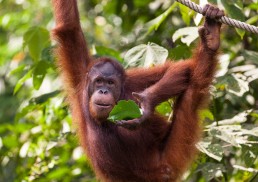
Best Time to Visit Borneo’s Orangutan Destinations & Sanctuaries
Feel free to visit Borneo’s orangutan sanctuaries around the year, as orangutans are likely to pop at the feeding platforms unless torrential rain keeps them in the forest canopy. The dry season runs from March to October, which is considered the best time to visit Borneo; it’s also the best time to see orangutans in the wild. Still, please note that it might rain anytime, as you’re in a tropical rainforest. Orangutan sanctuaries get crowded during school holidays, so it would be best to avoid those timings if you can.
Choose an Ethical Way to See Orangutans
Obviously, all orangutan destinations listed here offer ethical encounters with orangutans. Sepilok Rehabilitation Center and Semenggoh Wildlife Center both respectively take care of orphaned and illegally caught pet orangutans and injured adult orangutans. Entrance fees support their conservation work.
Please, never ever support “a self-claimed orangutan sanctuary” where orangutans are kept in small cages or leashes, required to do tricks, or where these great apes look stressed, mistreated or unhappy! Also, never touch, feed, or play with an orangutan (unless you’re volunteering and liable to do so).
How to Behave Near Wild Orangutans
Orangutan observation has its own guidelines, but using common sense brings you far. We listed below the common rules of visiting orangutans, but please listen to your guide’s instructions in all situations.
- You must stay on marked trails and obey all the other rules that the sanctuary or national park has.
- Do not approach, feed or try to touch orangutans.
- If orangutan approaches you, move away slowly if you can and listen to your guide’s instructions.
- Don’t use flash while taking pics.
- Don’t shout or make sudden movements or otherwise agitate orangutans.
- Don’t stare orangutans into the eyes: they might feel charged or disturbed.
- Never go between two orangutans – especially a mother and her baby.
- If you hear kiss-squeak sounds or if orangutan drops vegetation or food upon you, it’s stressed or angry. Back off.
- Cancel your orangutan observing activity if you’re ill, because of the risk of spreading diseases to orangutans. If you need to cough or sneeze, turn your head away from the animals and cover your mouth and nose. Simple flu to humans might be fatal to orangutans!
- Eating and drinking near orangutans are generally not allowed.
- Smoking is prohibited, as it disturbs animals and cigarettes might transmit diseases.
Why Borneo’s Orangutan Population Has Dropped 50%
A recent study recorded a saddening 50% decline in Borneo’s orangutan population. During just 16 years between 1999 and 2015, we’ve lost roughly 150 000 individuals. The greatest surprise for us was that up to 70% of the loss might be caused by hunting and other killings by farmers. Habitation loss by palm, paper, logging, and mining industries is only a part of this tremendous tragedy, though the most severe losses were recorded in the areas where habitat was destructed.
We as consumers can help to save their habitat by choosing products, which don’t use palm oil. If you’d like to donate to orangutan rehabilitation and conservation, The Orangutan Project (EU/AUS) and Orangutan Appeal (UK) are both solid options; the latter funds projects at Sepilok’s Orangutan Rehabilitation Centre.
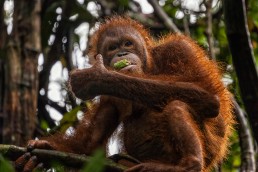
Facts About Orangutans in Borneo
- Wild orangutans live only in the islands of Borneo and Sumatra.
- Orangutans are divided into three species, Borneo Orangutan (Pongo pygmaeus), Sumatran orangutan (Pongo abelii) and the recently discovered Tapanuli orangutan; all species are critically endangered.
- The Borneo Orangutan has three sub species: P. p. morio living in Sabah and East Kalimantan, P. p. pygmaeus living in Sarawak and West Kalimantan, and P. p. wurmpii roaming West and Central Kalimantan. Thus, the orangutans that in Kuching’s Semenggoh Sanctuary or Batang Ai are different species than those you’ll see in Sabah, either in Danum Valley, Tabin, or Sepilok Orangutan Rehabilitation Center!
- “Orang utan” means “man of forest” in Malay and Indonesian.
- We share 97% of DNA with orangutans. Like us, also orangutans have opposable thumbs and big toes.
- Bizarre fact: a third of orangutans don’t have nails on their big toes!
- Orangutans are adapted to eat, sleep and move in the trees – they spend more than 95% of their lives in the forest canopy. To facilitate smooth swinging and hanging, their arms are longer than the rest of their bodies.
- Male orangutans weight 50-100 kilos and females 30-50 kilos, making them the largest arboreal mammals on earth.
- Current researches estimate that there are only 55 000–100 000 wild orangutans living in the rainforests of Borneo.
If you have you seen wild orangutans in Borneo, please share your experiences in the comments below!
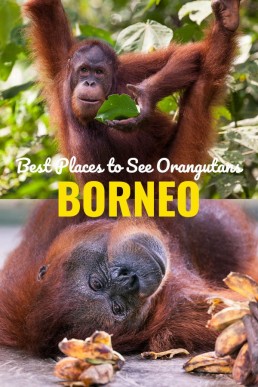
Experience the Wilderness of Danum Valley in Gorgeous Borneo Rainforest Lodge
Danum Valley offers the most authentic wildlife encounters in Borneo: it’s the best place to see truly wild orangutans and the rare Bornean pygmy elephants. There’s only one lodge inside the vast wilderness of Danum Valley Conservation Area, the luxurious Borneo Rainforest Lodge. Danum Valley’s world-famous canopy walkway, open exclusively to the guests of Borneo Rainforest Lodge, gives a bird-eye view to the most complex ecosystem in the world.
The Last Stronghold of Bornean Primary Rainforest
Danum Valley is the Borneo that I had been dreaming about: a misty rainforest canopy stretching out further than eyes can reach, inhabited by shy orangutans and gibbons, elusive pygmy elephants, tarsiers, and even the rarely seen clouded leopards. More than 300 bird species, some of them endemic, make Danum Valley also a birder’s paradise.
Whereas over 80% of Borneo’s rainforests are sadly logged, Danum Valley Conservation Area’s 438 square kilometers of lowland tropical rainforest gives Borneo’s wildlife a well-needed shelter.
The Exclusive Borneo Rainforest Lodge Experience
For modern-day Indiana Joneses, it’s the luxurious Borneo Rainforest Lodge, which makes Danum Valley a paradise. You’ll be surrounded by the extraordinary biodiversity, sounds, and smells of rainforest, but living inside a sweet bubble of 5-star luxury: from decadent meals to the lavish comforts of your private villa.
Ultimately, the terrace of Borneo Rainforest Lodge is among my favorite places to unwind, with a drink in my hand, staring into the ancient rainforest canopy where no modern man has stepped – the kingdom of wild orangutans.
Talking about exclusiveness: the award-winning Borneo Rainforest Lodge has only 30 luxurious chalets and even more exclusive presidential suites, which have hosted, for example, Prince of Wales and other royalty along with celebrities.
Whereas deluxe chalets have privates jacuzzis and views to the Danum River, the standard chalets face the jungle with the best wildlife watching opportunities. And I mean that literally: an orangutan had slept right above our chalet the night before we arrived!
The Best Place in Borneo for Authentic Wildlife Sightings
Borneo Rainforest Lodge is the only lodge in Borneo, which is located inside the primary forest. Naturally, it’s the best spot in Borneo to explore the virgin primary forest.
After experiencing the different faces of Borneo, it was clear to us that Danum Valley offers the most authentic wildlife watching in Malaysian Borneo. Here, the wildlife sightings are private, whereas in Kinabatangan River you’ll usually share orangutan encounters with other groups. Animals aren’t so used to humans, so they are harder to spot, but that makes the encounters even more magical. To sum up our experience: we saw 6 orangutans and the herd of rare pygmy elephants – twice!
Hiking Inside Danum Valley to Waterfalls and Burial Sites
In Borneo Rainforest Lodge, you can freely pick your daily activities among morning and evening walks with a naturalist guide, night safaris with a jeep, tubing in Danum River, and canopy trekking.
Hiking inside the primary forest is allowed on private trails, which can take you to mesmerizing waterfalls, natural jacuzzi pools, and an ancient burial site. It’s possible to trek for a whole day chasing wildlife in their natural habitat. We loved our early morning walks (up to 4 hours) and were lucky to spot several orangutans.
Swimming and Tubing in Danum River – And Overcoming the Fear of Leeches
Hiking the trails of Danum Valley for hours ripened us for the adventurous yet relaxing tubing experience. Initially, my only fear was the unavoidable encounters with leeches, which are plentiful in the lush rainforest. Before our daily hikes, we used to cover up carefully with insect repellent, long sleeves, and pants, and finished the awesome outfit with special leech socks.
Here’s the trick for overcoming the fear of leeches: for tubing, you have to hike for half an hour through the rainforest, in flip-flops and swimming suit! As intimidating as it felt, we survived – and learned to swipe off the leeches with our fingernails. It became our initiation rite: afterward, we could enter the mighty jungle in t-shirts! The tubing itself was so awesome that we’ll draft a separate article about it. You can take a refreshing dip in Danum River whenever you please: on arrival, your guide shows the best swimming spots nearby the lodge.
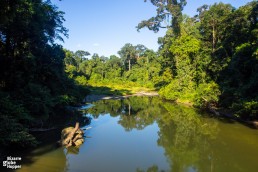
Exciting Night Safaris in Danum Valley Reveal Nocturnal Creatures
After the delicious dinner in Borneo Rainforest Lodge (among the best we had in Borneo!), you have the luxury to choose between a night walk with a naturalist guide or night drive with a guide and a spotter. We loved them both but opted to take twice the adventurous drive, which allowed us to tick off some pretty special sightings, such as a civet with babies!
Jeep safaris of Borneo Rainforest Lodge reminded us night game drives in Africa. The experience is as polished and adventurous as in the 5-star lodges in Africa’s prime safari destinations. But it shouldn’t be surprising at all, as Borneo Rainforest Lodge is regarded as the best wildlife lodge in Asia.
Danum Valley’s World-Famous Canopy Walkway
Danum Valley’s gorgeous canopy walkway deserves at least one day hike of its own. Dipterocarp and mengaris trees hold up bridges and viewing platforms, from where you can observe the ancient rainforest canopy in the privacy of your own hiking group. The famous, 300-meter long canopy walkway is exclusively for the guests of Borneo Rainforest Lodge. You can also swim in the clear waters of Danum River whenever you’d fancy a plunge: your guide will show you the best swimming spots during the first introduction hike.
Planning a Trip to Borneo? Check This First!
We make it easier to find the best locations in Borneo: check our ultimate itinerary in Malaysian Borneo for inspiration! Our route covers Danum Valley, Kinabatangan River, Sepilok and Sandakan area, Lankayan Island for the best snorkeling in Borneo, Kuching and Bako National Park, and the capital of Malaysian Borneo, Kota Kinabalu. We squeezed every one of those locations, together with two orangutan sanctuaries and sun bear center, into 2 adventurous weeks. Check the itinerary for further info on transfers and cheap internal flights. It’s a great base for any itinerary between 3 days and one month, as we list further suggestions.
So here we go: The Ultimate 2-Week Itinerary in Malaysian Borneo
Danum Valley’s Common and Endemic Plants and Species
Danum Valley is considered as one of the world’s most complex ecosystems. The sheer volume of exotic species leaves you speechless. Still remember those 300 birds? Add also 124 species of mammals and 72 species of reptiles – and 300 species of trees and 200 species of plants per one hectare!
I resist the temptation to list all the weird and awesome fauna and flora here but throw a couple of lines about our wildlife encounters to inspire you to visit Danum Valley someday! Danum Valley’s ecosystem is so unique that it might get UNESCO World Heritage status (there have been many proposals for the nomination).
Our Orangutan Encounters in Danum Valley: Spiced Up With Monkeys!
Let’s start with the great apes: while we met around six orangutans, Bornean gibbons hid from our eyes, though we heard their calls echoing through the jungle.
Once our guide thought he’d seen one, but it appeared to be a herd of grey leaf monkeys, which are easy to spot, as are their red leaf cousins. One thing is certain with the monkeys: you’ll get annoyed by the opportunistic long tail macaques, in Danum Valley and the rest of Borneo.
Check out the complete guide on where to see wild orangutans in Borneo: of course, also Danum Valley is listed!
Our Wildlife Wishlist and Rare Encounters in Danum Valley
Our wishlist included slow loris and western tarsiers, which we still yearn to spot in the wilderness, along with the rare clouded leopards and leopard cats. In Danum Valley, it’s possible to see leopard cats in the daylight, as they feed on monkeys who are active during the day.
We were extremely fortunate to observe a family of civets during a night safari – even our guide hadn’t seen a civet with babies in ten years! Against common beliefs, civet is not a cat, but a mammal and it feeds on insects and fruits.
We saw many tarantulas and some snakes. Luckily for me, no king cobras, Sumatran black vipers, or flying snakes, though they are present in Danum Valley. Our guide heard the calls of a couple of endemic birds, including Bornean wrissel head, the number one for avid birders, which we tried to follow the bushes in vain.
During night walks, fancily colored – and poisonous – frogs were easy to spot, as were the mouse deers. During night drives, we enjoyed several giant flying squirrels, both red and gray, showed off with long flights – or glides would be a more proper term, as technically they just jump and glide.
The last stars of the jungle are the rare pygmy elephants and sun bears. The latter are rarely seen in the wild, though our guide had seen many, but usually after dark.
The Pygmy Elephants of Danum Valley
The cute pygmy elephants roam Danum Valley in numbers but tend to live in the secondary forest, just outside the borders of the primary forest. While driving in and out to Borneo Rainforest Lodge, it’s possible to find their droppings by the road. According to WWF Malaysia, there are less 1500 Bornean pygmy elephants left on the island, most of them in Sabah. Both Danum Valley and Kinabatangan River have decent populations.
We were extremely lucky to bump into a herd of Bornean pygmy elephants twice during our transfers! As we bumped into the elephants on our transfers, in the middle of the road, we didn’t have our cameras ready and have only mobile photos. Check out our complete article on Kinabatangan River Cruise, where we met a herd of pygmy elephants on the river banks – with better photos!
Danum Valley’s Accommodation Options: Borneo Rainforest Lodge vs. Danum Valley Field Center
To sum it up: there’s only one hotel inside the enormous Danum Valley conservation area: the luxurious Borneo Rainforest Lodge. I’d highly recommend the splurge, even if you don’t usually stay in 5-star hotels.
Borneo Rainforest Lodge gives you a unique access to the last primary rainforest in Borneo, with all the comforts that you could wish for. If you’re not staying in Borneo Rainforest Lodge, you’ll miss the highlights of Danum Valley, such as the night safaris, hikes with your own naturalist guide, tubing, and access to the famous canopy walkway. All activities described above are included in your stay in Borneo Rainforest Lodge.
However, if the 5-star prices of Borneo Rainforest Lodge are totally unreachable for your budget, you can try to arrange a stay in Danum Valley Field Center, located just outside the border of Danum Valley Conservation Area. Accommodation is simple with cold showers. Instead of official and trained naturalist guides, the hikes are led by park rangers who just show the trails. Still, the famous canopy walk remains solely for the guests of Borneo Rainforest Lodge, as well as some of the other activities described here.
At the award-winning Borneo Rainforest Lodge, the rainforest experience is as civilized – in the most positive sense – as it can be. Just remember that you’ll still be in the middle of the virgin rainforest – surrounded by the vegetation and all the creatures of the jungle, including bugs and leeches.
We utterly adored our time in Danum Valley Borneo Rainforest Lodge – and all the other guests seemingly shared the bliss. The buffet meals were among the best we had in Borneo. All the exciting activities, like tubing and waterfall hikes, were among our favorite things to do in Danum Valley. Still, we probably enjoyed most the serene moments at the terrace, admiring the bewitching views towards the home of truly wild orangutans, while indulging in the sounds and smells of the rainforest.
How to Book Danum Valley Tour Package
You can book your Danum Valley package directly through Borneo Nature Tours, the tour company running Borneo Rainforest Lodge. Also, any other Bornean tour operator can add Danum Valley tour to your itinerary. Check out Borneo Rainforest Lodge’s website for current Danum Valley packages and accommodation prices. The minimum stay is two nights, but we highly recommend staying at least three nights to experience the spell of Danum Valley – and enjoy the lavish Borneo Rainforest Lodge at the fullest.
Are you looking for similar lodges in other parts of Borneo? Check our favorite lodges in Borneo!
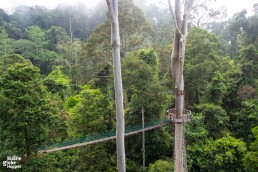
How to Get to Danum Valley From Lahad Datu, Kinabatangan, and Kota Kinabalu
Borneo Rainforest Lodge provides free, private transfers from Lahad Datu in air-con 4×4 jeeps. The Field Center organizes a shared van from and to Lahad Datu three times a week, at a separate charge.
Lahad Datu is the nearest town and airport, 82 km away from Borneo Rainforest Lodge. You can either fly or drive there. We took a private road transfer from Kinabatangan River (Borneo Rainforest Lodge or your lodge in Kinabatangan can arrange it), and flight to Kota Kinabalu. Driving from Kinabatangan/Sukau to Lahad Datu takes around 1-1,5 hours. MasWings has daily flights between Lahad Datu and Kota Kinabalu. We flew to Kuching on the same day with an appr. one-hour transfer.
Would you love to splurge by staying at the exclusive Borneo Rainforest Lodge, while exploring the virtually untouched rainforest of Danum Valley?
Borneo Rainforest Lodge, the only lodge in Danum Valley, hosted our stay. Like always, all opinions remain ours – and we whole-heartedly recommend adding Danum Valley to your route in Borneo.
Pin this!
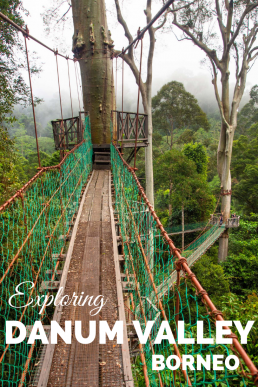
Sarajevo to Mostar by Train: Iconic Train Journey is Back 2019
Take the train from Sarajevo to Mostar to tick off one off the most iconic train journeys in the world. After being suspended for years, the train traffic between Sarajevo and Mostar is now running with new, comfortable Talgo trains. The train journey expands all the way to Capljina near the Adriatic coast, offering an easy and scenic way to travel from Dubrovnik to Mostar. Expect craggy peaks, turquoise rivers, dark tunnels and ancient viaducts – welcome aboard!
How We Ended Up Taking the Train from Sarajevo to Mostar
I had dreamed for ten years of taking the train through the picturesque Bosnian countryside to see the bridge of Mostar. When I first visited Croatia years ago, the train was not operating. When we were planning a one month trip in Montenegro and Bosnia-Herzegovina, the train journey to Mostar was on top of my bucket list. Luckily, the trains are running again, so don’t miss this train journey if you’re visiting Sarajevo, Dubrovnik, Makarska, or other destinations on the Croatian Coast!
The Scenic Sarajevo-Mostar Train Journey
The train journey from Sarajevo to Mostar takes around 2 hours. The train meanders between mountains, popping in tunnels, traversing viaducts, and passing a series of small towns, farmhouses, and crops. The best countryside idylls and mountain sceneries fall between Sarajevo and Konjic, a small town on the banks of Neretva River.
The most beautiful views from the train window, to my likings, are between Konjic and Mostar. About 10 minutes after departing Konjic, we were blessed with a turquoise river on our left side, with craggy peaks looming upon it. The rails traverse the mouth of the beautiful Jablanica Lake (Jablanicko jezero) and follow the lake for its whole length until it narrows again into Neretva River, which will entertain your eyes on the left side of the rails all the way to Mostar.
Getting from Mostar to Caplina by train takes only 30 minutes, and the views don’t rival with the rest of the journey. So if you’re coming from Dubrovnik/the Croatian coast, plan on visiting Sarajevo, as well!
The Spell of Mostar
But why was I longing to see Mostar? I could probably continue pouring praise song for days, but in short, it was the famous bridge that has been captivating me since I saw the first pictures of it more than 10 years ago.
The old, Ottoman-infused stone bridge of Mostar was built by Suleyman the Magnificent in the 16th century but demolished in 1993 during the war. The bridge was finally reconstructed in 2004, stone by stone and according to the original architecture, even honoring the original flaws.
Nowadays it stands as a symbol of peace and hope – and holds Unesco World Heritage status. During summertime, it’s the spot of the daily show as local daredevils jump from the bridge towards the turquoise Neretva river below.
Everything You Need to Know About Visiting Mostar
Check our complete guide on visiting Mostar and the epic old bridge of Mostar!
Whether to Travel to Mostar by Train or Bus
My answer is clear: pick the train firstly for the better sceneries and secondly for both faster and more comfortable journey. Before 2017, many people recommended bus because the trains were slow, worn, and cramped with chain-smoking locals.
Comfortable and Easy Way to Travel Between Mostar, Sarajevo, And Croatia
The Sarajevo-Mostar train route was relaunched with the new, fast Talgo trains in summer 2017 – with an additional leg to Capljina and bus shuttle to Croatia. The trains are similar as in Central Europe; they have restaurant cars, spotless toilets and strict no smoking policy in passenger carriages. There’s even free wifi, which worked perfectly for us. Another praising review from us with problematic backs: the seats were more comfortable than in most international trains in Europe. Train journeys hardly ever get better than this: enjoy the stunning views while sipping cold or hot drinks and clogging your friends’ Facebook feed with mountain sceneries!
Whereas the Talgo trains are called fast, and I believe the trains could be fast, the rails are not up to par. That leads to 2,5-hour travel time between Sarajevo and Capljina and around 2 hours between Sarajevo and Mostar. Still, it’s much quicker than with the fastest bus!
Seasonal Trains Between Sarajevo, Mostar and Croatian Coast
In addition to the year-round daily train (check out the next chapter), during the peak summer season, there’s one extra connection between Sarajevo and Capljina. Specially crafted for the needs of tourists, it comes with a handy perk: the Bosnian train company offers shuttle transfer from Capljina to the Bosnian and Croatian coast! The shuttles are conveniently waiting at Capljina train station so that you can minimize your travel times.
How to Travel From Sarajevo/Mostar to Makarska and Split by Train and Bus
The shuttle buses run to Neum on the Bosnian side and Makarska on the Croatian side. So if you’re heading to Split or northern Croatia, book your ticket all the way to Makarska – and of course, Makarska itself is a pleasant option for relaxing beach time or island hopping.
How to Travel From Sarajevo/Mostar to Dubrovnik by Train and Bus
If you’re heading to Dubrovnik, book your ticket to Neum and continue your journey from there with one of the hourly passing buses. For Dubrovnik, you can also take a bus from Capljina, but it will still run through Neum. I wouldn’t spend my precious holiday time on Neum, the only coastal town in Bosnia-Herzegovina: it’s overflowing with Bosnian tourists and not as pleasant as the surrounding Croatian towns.
Please note that the shuttle service is only offered from Capljina to the Croatian coast. If you’re traveling from Croatia to Mostar/Sarajevo, you have to organize the road transfer by yourself.
The seasonal train runs during the summer season. In 2018, the summer train operated from 15th of June until 31st of August. We happened to take the last seasonal train last year – and were grateful that it was still running, as we had already crafted our schedule around it.
The additional summer train departs Sarajevo at 7.01 AM and arrives in Capljina at 09.35 AM; from Capljina it leaves at 7.25 PM arriving at Sarajevo at 9.59 PM.
Year-Round Daily Sarajevo-Mostar Trains (Going to Capljina and Konjic, as well)
Good news for off-season travelers: from now on the fast trains between Sarajevo and Mostar are running daily around the year! In addition to the daily Sarajevo-Capljina-Sarajevo connection, from last summer onwards there has also been a local passenger train operating between Sarajevo and Konjic (working days only).
For your convenience, we’d recommend taking the faster daily Talgo train, which leaves Sarajevo 4.50 PM and arrives in Mostar at 6.45PM (and in Capljina respectively at 7.15PM). The same train departs Capljina at 6.16 AM and reaches Mostar at 6.43AM – and Sarajevo at 8.41 AM.
Still, many locals were hesitant in September 2018 that all train traffic between Sarajevo and Mostar/Capljina would be suspended for the off-season. So please double-check from the railway company or your accommodation before planning around it. Luckily, buses run between Sarajevo-Konjic-Mostar-Capljina-Neum/Dubrovnik year-round.
Our Experience With the Bosnian Railways
The early morning departure from Capljina to Mostar – together with harder to hassle transfers on the side – made us twist our itinerary so that we could travel from Sarajevo towards the coast. We took the daily evening train from Sarajevo to Mostar: it left on time but arrived in Mostar a bit late. From Mostar, we took the seasonal connection to Capljina. The trains were the same, comfortable Talgo trains on both legs. The Neum–Capljina bus connection left about 20 minutes after the train had arrived. In Neum, the bus drops you next to the bus stop, where you can wave down any bus heading to Dubrovnik or north towards Makarska or Split. Croatian buses pass Neum every hour.
How to Book Tickets to Sarajevo-Mostar-Capljina Train
At the time of our visit to Bosnia and Herzegovina, not even our hosts knew how to book the tickets. We ended up taking a taxi to the Sarajevo Railway Station the day before only to hear that it’s only possible to book tickets on the same day. Nevermind the fact that their own website tells that train tickets can be bought 30 days in advance. The officers assured that there’s no need to worry though since there will always be seats left. We paid around 10 KM (5 €) for one-way tickets from Sarajevo to Mostar. If you hop off in Konjic, like we were initially supposed to do, the price will be around 3 KM less. Return tickets come 20% cheaper.
Please double-check all train schedules and prices from www.zfbh.ba (the official website of The Railways of the Federation of Bosnia and Herzegovina, ŽFBH).
We are also happy to update the article: please help fellow travelers and let us know if something has changed.
How to Survive Sarajevo Railway Station
Firstly, you need a taxi, and most taxi drivers don’t speak English. Unless your hotel calls a taxi and gives directions, please show your driver the railway station from Google Maps, Maps.me or whatever map you happen to use, with the text “zeleznicka stanica” (meaning railway station, comes handily with Maps.me) and you’ll get there. There’s only one railway station in Sarajevo: next to the central bus station, about 5 km from stari grad (old town).
The railway station looks pretty abandoned, as there are currently only a couple of trains running. The huge building has certainly seen better days, nowadays it’s almost in ruins, and empty platforms feel surreal. All in all, it isn’t a pleasant place to wait for your connection. There are two cafeterias selling drinks if you’d need to stock up for the journey.
Train Travel in Bosnia-Herzegovina is Improving in 2018-2019
After years of suspending all international and domestic train traffic, the train connections in Bosnia are slowly improving. Initially, ŽFBH informed that Sarajevo-Zagreb trains would start running in December 2017, but at the time of writing, there’s still no direct connection between the two cities. There have also been plans for extending the current Sarajevo-Doboj route all the way to Banja Luka. Until further notice, all international train traffic from Bosnia (instead of Sarajevo-Capljina route with shuttles to Croatia) remains suspended.
Have you crossed the countryside of Bosnia with a train – or would you like to take the legendary train journey from Sarajevo or Croatian coast to Mostar?
Pin This Story!
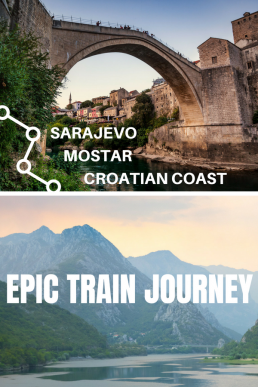
The Best Cafes and Specialty Coffee Shops in Riga, Latvia
Find the best coffee shops in Riga, sample locally roasted specialty coffee beans in public cuppings, and hunt down the most atmospheric cafes inside the old town of Riga. Further tips for the best cakes, strong wifi, and craft beer detours – read on!
Riga’s specialty coffee scene took off as late as 2015, but new third-wave coffee shops have been popping up ever since. Nowadays there are several lovely cafes to choose from in the center (Centrs) – and it’s possible (though harder) to find some prime beans also in the old town. Our specialty coffee guide brings you the best brews in Riga!
BEST SPECIALTY COFFEE SHOPS IN RIGA
Rocket Bean Roastery: Roastery & Coffee House
29/31 Miera iela & Dzirnavu iela 39 (Centrs)
Rocket Bean Roastery deserves to come first, as it’s the trailblazer of Riga’s specialty coffee. Their atmospheric roastery cafe lies in the old sock factory, slightly of the center and the old town. The same street, called Miera, also hosts lovely spots for craft beer, snacks (also vegan!), and tea, together with Laima Chocolate factory. So it’s well worth the hike (or a short tram trip): spend a coffee-infused, craft beer crowned afternoon in Miera neighborhood!
This first real specialty coffee house in Riga was opened in 2015. If you visit only one specialty coffee shop in Riga, let it be Rocket Bean Roastery for the history, worldly roastery atmosphere, and of course the coffee itself!
Rocket Bean Coffee House is a roastery side-kick in the center, a perfect spot for a slow lunch or long break from a hectic day.
The food, including cakes, is really delicious in both branches; the chef Artūrs Taškāns has Michelin experience. Rocket Bean Roastery hosts weekly public cupping sessions.
Side notes to Specialty Coffee Geeks
Rocket Bean Roastery has the epic machinery: Loring Smart Roast Kestrel35 and LaMarzocco Strada, the only one in Latvia.
Don’t forget to stock on the beans! I fell in love with them online: you can spot Rocket Bean Roastery occasionally on specialty coffee delivery services. At the time of our visit, they had some prime beans from Ethiopia, Kenya, Honduras, and El Salvador.
Magic Pussy is their seasonal flagship espresso from Yirgacheffe, Ethiopia. We bought Burtukaana Lot 11. It’s full of sweet tones of chocolate and apricots, with notes of bergamot and grapefruit. As you can see from the pics, the baristas wear Magic Pussy shirts!
Check out Rocket Bean Roastery’s website and Facebook page for upcoming cupping sessions, opening hours, and further information.
Zvaigzne Café: Specialty Coffee & Books
Krišjāņa Valdemāra iela 6, 1010 Riga (Centrs)
Zvaigzne Café is my other favorite in Riga. This bookshop cafe is located near the old town, making it the best option for specialty coffee thirsty tourists. Just cross the northern bridge over the city canal (Krišjāņa Barona Street) and walk straight for a couple of hundred meters to reach Zvaigzne Café on your right.
Zvaigzne spoils you with high-quality beans from Atkinsons Coffee Roasters (also retail packs available). The son of famous Zvaigzne ABC book publisher, Kristaps, lived nearby Atkinson’s roastery café while he was studying in Lancaster University (UK), and decided to open his own cafe in Riga serving his favorite coffee.
Check out Zvaigzne Café’s Facebook Page for their opening hours and further information.
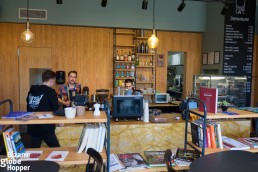
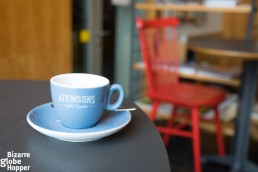
MiiT Coffee: Specialty Coffee & Vegetarian Treats
Lacplesa iela 10, 1010 Riga (Centrs)
MiiT Coffee blends our love for the small roasteries and vegetarian food. Third-wave coffee beans are available both from locals and my European favorites: Five Elephants (Berlin) and DaMatteo (Gothenburg). MiiT likes their coffee poured and hand-pressed: your brewing preferences for AeroPress, V60, Chemex and French Press are skillfully catered.
Vegetarians and vegans are spoiled here with cakes, together with healthy choices for breakfast, lunch, and dinner. They even have homemade almond milk to go with your coffee. Try the popular pancake brunch on Saturdays and Sundays!
MiiT Coffee arranges regular public cuppings, so check their website and Facebook page for further details.
MORE SPECIALTY COFFEE SHOPS IN RIGA
Miera
Miera Iela 9 & Meza iela 4a, 1001 Riga (Miera/Centrs)
The name tells it all: this small cafe is located on Miera street. The word miera means peace, and the atmosphere lives up to it. Coffee beans come from the nearby Rocket Bean Roastery, and brewing options include La Marzocco GB5, V60, and Chemex.
Mute
Tērbatas iela 63, 1001 Riga (Centrs)
Yet another peaceful cafe in the center, Mute offers beans from both Rocket Bean and international roasteries. Mute means mouth in Latvia: together with the adjacent restaurant and cocktail bar Mute offers a mouthful of flavors. Brewing methods include La Marzocco GB5, V60, French Press, and Chemex.
Kuuka Café
Grēcinieku iela 5, 0150 Riga (Old Town)
Whereas all specialty coffee shops listed above are located in “the new city”, Kuuka Café is your best bet inside the old town. This tiny spot is perfect for an afternoon cake, which comes with strong wifi. The best news: Kuuka serves its own special blend from Rocket Bean Roastery!
Are you always searching for the best coffee in town, just like us? If so, we did the legwork for you in these cities and countries:
Best Cafes in Cartagena, Colombia
Best Cafes in Bogota, Colombia
Hunting the Best Coffee Beans in Rwanda
Other Cafés in Riga for Atmospheric Coffee & Cake Breaks
Parunasim
Mazā Pils iela 4, 0150 Riga (Old town)
Self-claimed as the most romantic café in Riga, Parunasim feels like a hidden gem in the midst of old town. Signs on the street ask if you can find it: venture in the quiet inner yard and look for the bicycle on the wall.
Fat Cat
Jauniela iela, 0150 Riga (Old town)
Fat Cat has a perfect name and location just off the House of the Blackheads, at the beginning Jauniela, one of the old town’s prettiest streets. Relax awhile munching their famous eclairs and cupcakes before returning to the picture-perfect cobblestoned streets Riga’s Old Town.
Pasedet
Stabu Iela 10, 1010 Riga (Centrs)
Pasedet is yet another cozy coffee house in the center to idle for hours. The name means ”to sit down” and implies for hanging out with friends. Food is especially deliciously plated here for a cafe. Try their famous Napoleon cake!
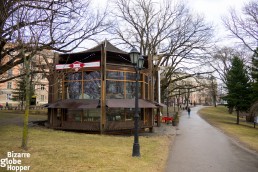
Bubbling Under: Apsara Tea House, Just off Riga Old Town
Tired of all that mocha? Riga also has a couple of lovely teahouses. Apsara Teahouse charms with its unique tea house atmosphere and canal views. A perfect location just off the old town (Krišjāņa Barona iela 2A), inside the park surrounding the city canal (Pilsetas Kanals). Look for a charming Chinese style pagoda hut just off the bridge crossing the canal (in Krišjāņa Barona Street). Check out Apsara’s website for more inspiration and information.
Now it’s your turn! Are you planning to do an independent coffee shop tour in Riga? Go for it – I’d say “the coffee walk” is among the best things to do in Riga, at least when you combine it to other sights. If you have you already hunted down the best coffee in Riga, please share your thoughts in the comments below – and don’t forget to tell us your favorite coffee shop in Riga!
Pin This Story!
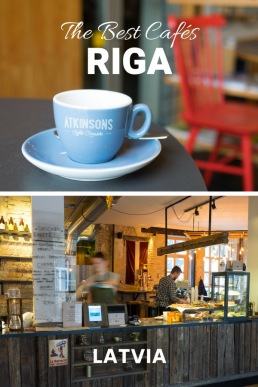
Searching the Best Snorkeling Spot in Borneo? Go to Lankayan Island!
Are you looking for a tropical paradise island in Malaysian Borneo, with world-class snorkeling right from the shore but without the crowds? Search no more: the remote Lankayan Island offers the best snorkeling in Borneo! Imagine total seclusion with just one dive resort and blissfully empty stretches of powdery sand. Water is so clear that you can spot turtles, rays, and other creatures already from the beach.
The Best Snorkeling in Sabah is Serene – Forget Crowded Sipadan Island!
Whereas tourists flock the snorkeling and diving sites nearby the world-famous Sipadan Island, the jewel-shaped Lankayan remains a remote tropical paradise off-the-beaten-track.
Comparing Snorkeling Experiences in Sipadan and Lankayan Island
Many people say that Sipadan has the best diving and snorkeling in Borneo, but we disagree. The crowds at Sipadan make the experience rather stressful – and it’s even more stressful to get the permit. Yes, in Sipadan you can see large shoals of fish, but you won’t be the only one snorkeling in those tourist-infested waters. You can expect to see shoals of tourists, as well.
In Lankayan, you can snorkel or dive with turtles and shoals of jazzy fish upon bright and healthy coral reefs, spotting intriguing – and rare – species such as jawfish and nudibranchs! For us, that’s the best snorkeling in Borneo.
The best news for snorkelers: just plunge into the turquoise Sulu Sea in the front of your chalet or from the stairs of the Lankayan Island dive shop. Snorkeling is fantastic right at the Lankayan jetty, where you can spot turtles and sharks, together with clownfish, pufferfish, lionfish, and herds of huge fellows like grouper and tuna.
We loved the convenience of snorkeling at the jetty and the variety of species, so for two days, we didn’t even feel the need to take a boat to the nearby reefs – which are, by the way, even more stunning!
Snorkeling in Lankayan Island: What Can You See?
But what did we see, then? The list is endless, and the species evade my memory. But I could start with a dazzling lionfish, which we saw already from the pier, before plunging in. Maybe luckily so, as I suddenly remembered how venomous those beauties are. Various butterfly fish, parrot fish, gobies, and angelfish were our loyal companions; they were everywhere. “Nemos” a.k.a. clownfish (or anemones) were also easy to find at the jetty.
I remember a couple of close encounters with the blazingly yellow blue-spotted common rays when we got spooked by those sneaky creatures, quietly slipping from the sand and gliding just beside us. We also spotted a couple of scorpionfish, pufferfish, and stonefish right at the shore; the latter is so common here that you should use water shoes – or fins – when plowing through the shallow water. Crocodile needlefish were plenty below the pier – I wasn’t so happy to hear that they could spear people! Sea cucumbers are easy to spot on the sand, between the jetty and the shoreline. We also loved to observe several giant clams, which are listed as threatened due to climate change and fishing.
We couldn’t get enough of the stunning blue sea stars, which for our luck were omnipresent. We also saw some “cut” versions and learned that these starfish can do self-amputation to escape from predators. Crown-of-thorn starfish are also so common that their population needs to monitored, as they feed on coral.
Then there were groupers, jacks, and tunas together with several other big fish beyond our recognition, mostly hiding below the dive center or swimming under the pier. We also managed to see a couple of (harmless!) black-tip reef sharks in the shallow waters, both near the pier and further away, where the reef slopes down. The edge of the reef was also the best spot to swim with the turtles, though we saw several green turtles even just beside the pier. Mornings were the best time to spot sharks and turtles in the shallow waters.
We also had several other memorable moments right at Lankayan jetty, floating upon vast stretches of various corals, watching fish getting together and whirl up dust, as they were ferociously eating their way through the corals. Vast, unspoiled stretches of staghorn and lettuce corals hide shy residents, and delicate feather stars, sea fans, and whips entertained our eyes. I just couldn’t get enough of it – Piritta had to drag me out for lunch and dinner.
Micro and Macro Diving Sites in Lankayan Island and the Sulu Sea
Lankayan is famed as a macro diving destination: many divers come here for nudibranchs and small creatures that we haven’t even heard of before. But it’s not the whole story, as you can guess from my snorkeling hype.
Divers praise the pristine reefs of Lankayan and the combination of macro and micro diving. More than 30 dive sites surround Lankayan, and there are some fascinating wrecks nearby – the first being right at the jetty with some resident frogfish.
The rare species abound, also jawfish can be spotted already at the jetty (also while snorkeling, though we missed it!). The macro treats include, for example, ghost pipefishes. Leopard sharks are rare, but possible to spot here.
Although the internet pours stories about annual whale shark migration, the last sightings are from 2004. But there are so many wonders to unfold that you probably won’t even remember hearing about the whale sharks!
Swim and Snorkel with the Turtles in Lankayan Island – And Support Turtle Conservation!
Floating silently upon the sea turtles was utterly the highlight of snorkeling for us. Our respect for those graceful creatures is immense, so observing them in their natural habitat feels magical. We even lost the count during our underwater explorations at the Lankayan jetty, but I’d bet we saw turtles more than 20 times during the two days. Of course, we must have seen the same turtles many times. I cherish the moments, when we followed a turtle for several minutes – it felt eternal. The turtles didn’t mind our presence as long as we didn’t splash, but just silently swam beside them.
Witness Turtle Nesting and Hatching in Lankayan Island
Lankayan Island is a nesting site for hawksbill and green turtles. The island has its own conservation center, which monitors the health of coral reefs, protects nesting and breeding of sea turtles, and fights against illegal activities. You can visit Reef Guardian’s House to learn more about marine conservation – and if you’re lucky, you can even witness turtle nesting and hatching! By visiting Lankayan, you will support the conservation of these beautiful creatures.
Why Snorkelers Should Head to Lankayan Island Instead of Sipadan
The world-famous diving destination Sipadan has gained some reputation among snorkelers, as well. The tiny island of Sipadan lies in the north-eastern corner of Borneo, on Malaysian side. It’s ringed with a reef, which suddenly slopes down steeply more than 500 meters, creating a channel for thousands of big fishes. Picture, for example, tornado-like shoals of barracudas and everything from hammerhead sharks to turtles, tunas, manta and eagle rays – mostly huge, pelagic fish.
Sipadan is ranked among the top 5 diving destinations in the world. To make this even more clear, Sipadan is a scuba dive destination, and thus the operators here cater divers, not snorkelers. Entering the overly popular marine reserve is restricted by daily permits, which are nowadays hard to gain. The daily 120 permits are divided between 12 nearby dive resorts. During the high season, all resorts are full, accommodating altogether 600 guests, all avid to dive at Sipadan. Naturally, the resorts favor divers staying multiple nights (at diver’s packages) while allocating those permits among their guests.
Another nuisance is getting to Sipadan. Firstly, you need to fly to Tawau (from Kota Kinabalu) and then proceed to the village of Semporna (1,5 hours by a taxi or minivan). Semporna itself is recommended only for budget travelers: another leg in a speedboat whisks you to nearby islands of Kapalai or Mabul, which offer more pristine surroundings and a shorter boat trip to Sipadan. Sipadan used to have one, exclusive dive resort (owned by the same company, which owns Lankayan Island Dive Resort), but it was closed to minimize the footprint of tourism in 2005 – daily permits were introduced at the same time.
Still Anxious to Snorkel in Sipadan?
Our tips: avoid high season (diving in Sipadan is excellent all year round, as there’s no monsoon), book early, stay long enough, and try to secure your permit at the time of booking to avoid disappointment. If you’re “only” snorkeling, I’d still recommend avoiding the hassle and choosing Lankayan.
If the spell of Sipadan remains irresistible, choose nearby Kapalai Island, which is known for its turtles and has superb reefs for snorkeling. Kapalai Island Resort holds 14 daily permits for Sipadan (which is the maximum for one resort) – I wish you the best of luck!
LANKAYAN ISLAND FAQ
Where to Stay in Lankayan Island?
The first question is easy to answer: there’s just one lodge in Lankayan Island, so you don’t have any options. Worry no more, Lankayan Island Dive Resort is a perfect place to stay in Lankayan!
Lankayan Island Dive Resort has wooden cabins right by the shore, some of them on stilts upon the turquoise ocean. All cabins have unobstructed ocean views. You can swim and snorkel right off your own beach, or at the Lankayan Jetty (in front of the main building and restaurant).
All-inclusive rates include all meals and boat transfers from Sandakan. Buffet dinners at Lankayan Island Dive Resort are flavorful affairs with some of the best seafood that we had in Borneo.
Check the best rates for Lankayan Island Dive Resort from here – and book well in advance to secure a room in this paradise!
Is it Safe to Visit Lankayan Island in 2019?
Currently, many countries have travel warnings advising against traveling to the Eastern Sabah and Lankayan Island. All these travel warnings are based on old kidnappings in Sandakan area in 2015. After that, there haven’t been any incidents.
Please see the current travel advice from the US government here. You can find travel advice from the UK government here.
When we visited Lankayan Island, the governments had similar travel warnings against all but essential travel in the Eastern Sabah area and especially the islands of the Sulu Sea (including Lankayan). We decided to go anyway, and felt totally safe in Sandakan area and Lankayan Island.
Lankayan Island has a military base, which made us feel even more secure. I’d say that visiting Lankayan Island felt safer than visiting the other islands in the Eastern Sabah area due to the military base.
Behind all those warnings are the kidnappings five years ago. Five years is a long time. I don’t quite understand why the governments are not updating their travel warnings based on the curret security situation. There haven’t been any tourist kidnappings in the Eastern Sabah for many years.
How Long to Stay in Lankayan Island
We recommend staying at least three nights in Lankayan Island. Traveling to Lankayan takes time (check out the next chapter) and boat transfers might feel too rough, if you’re planning to stay just 1-2 nights. It’s a vacation, after all, so we recommend slow pace. I’d say that two nights in Lankayan Island is the absolute minimum for a stress-free beach holiday.
How to Get To Lankayan Island in Sabah, Borneo
Fly, drive or take a bus to Sandakan, a coastal town in Sabah area of Malaysian Borneo.
If Sepilok and its world-famous orangutan and sun bear sanctuaries are in your Bornean itinerary, worry no more, as Sandakan is just 30 minutes away. Check out our separate articles on what to do in Sepilok and its sun bear sanctuary. Get even more inspiration for your adventures from our 2-week itinerary around Malaysian Borneo.
Lankayan Island Dive Resort will pick you up from airport or hotel inside the boundaries of Sandakan. Pick-up and speedboat transfers are included in the prices. T
he speedboat to Lankayan leaves from Sandakan at 10 AM (and departs from Lankayan at 7 AM). The trip takes typically 1,5–2 hours depending on sea conditions (and it might be a rough ride). If you arrive at Sandakan airport after 9 AM, you have to stay the first night in town.
Would you pick Lankayan Island for your snorkeling adventures in the turquoise waters of the Sulu Sea?
Pin This Story!
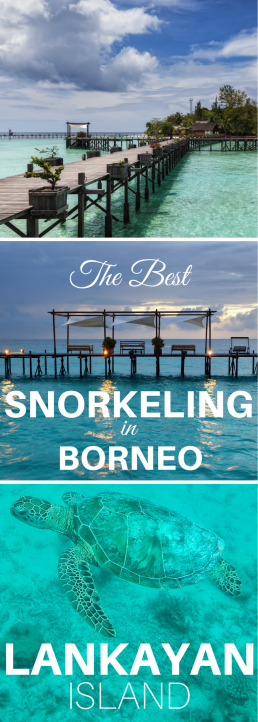
Mount Nyiragongo Lava Lake, DRC: How to Visit the Mouth of Hell Safely
Molten lava bubbles and flows continuously creating captivating patterns into the surface of Mount Nyiragongo Lava Lake. Viciously glowing lava lake astonishes the rare visitors, who dare climb on top of the Nyiragongo stratovolcano in the Democratic Republic of the Congo. Spending a night at Nyiragongo crater edge is an adventure of a lifetime and a photographer’s dream come true.
This article has been thoroughly updated in March 2019. On February 15th, 2019, Virunga National Park was re-opened for tourists and Nyiragongo treks are running again.
World’s Largest Lava Lake Is Still Active
There are only seven lava lakes in the world, which are ranked as “persistent” or “nearly persistent” during the last decades. Currently, only four of the lava lakes are ranked as persistent and active: Mount Nyiragongo in the DRC, Erta Ale in Ethiopia, Kilauea in Hawaii, and Mount Erebus in Antarctica. To last, a lava lake needs a frequent heat source: the eruptions.
Mount Nyiragongo Lava Lake is the largest lava lake in the world on with a maximum diameter of 700 meters. The size and depth of the lava lake vary because every eruption changes the surroundings. As the level of Nyiragongo Lava Lake is tied into the pressure inside the magmatic system under the volcano, it gives researchers valuable information about the magmatic activity. In simplified language: Nyiragongo Lava Lake helps researches forecast Nyiragongo’s future eruptions.
In 1977, the lava lake drained catastrophically in less than one hour, flowing down and choking villages. Technically, the current Mount Nyiragongo Lava Lake activity is still part of the eruption, which started in 2002. Lava terraces on the crater walls mark the levels of previous lava lakes.
Otherworldly Nyiragongo Lava Show After Dark
At the Nyiragongo volcano rim, you can observe the churning lava lake at the bottom of the collapsed crater. To me, the lava lake resembled an interactive world map, where the borders were constantly changing and blending into each other. You can see – and hear – how the lava lake boils and spits fire as the hot gases explode. It’s the most beautiful sight I’ve ever seen and well worth the grueling hike to the Mount Nyiragongo summit!
How to Get to Mount Nyiragongo Lava Lake and Goma, the DRC
- Nyiragongo volcano lies inside the oldest national park in Africa, Virunga, in the Democratic Republic of the Congo. The nearest town Goma is a 20-km drive away. Goma is Congolese border town by the banks of explosive Lake Kivu, which DRC shares with Rwanda.
- Goma can be reached by road from the Rwandan border town of Gisenyi. When Mt Nyiragongo erupted in 2002, a lava stream covered the runways of the international airport of Goma. As of today, commercial flights are still out of operation.
- Mount Nyiragongo summit is reachable by a 4- to 6-hour guided hike, which starts at Kibati ranger station inside Virunga National Park. Only one hiking group is allowed to visit Nyiragongo summit a day. All groups are accompanied by armed rangers.
How To Trek Nyiragongo, One of the Most Dangerous Volcanoes in the World
Mount Nyiragongo volcano trek starts at the altitude of 1989 meters (Kibati ranger post). Since the trekkers ascend to the summit (elevation of 3470 meters) in just 4-6 hours, there’s a threat of acute mountain sickness (AMS).
Temperatures frequently drop below freezing, so remember to pack warm layers. You can read our complete guide on Nyiragongo volcano trek – with packing tips and of course some amazing images throughout the hike!
The lava lake lies deep in the Mount Nyiragongo volcano summit crater. During the night, the visibility is usually good. Scientists have descended from the summit to the bottom of the caldera, but that’s, of course, out of reach for ordinary travelers.
Beware Landslides at the Nyiragongo Crater Edge
Please be careful at the volcano rim and don’t even plan to descend towards the lava lake. Chinese tourist died from falling to the Nyiragongo volcano in 2007. A wooden cross at the edge of the rim reminds of her tragic faith. Despite warnings of her guides, she had trudged 15 meters down the crater edge before falling down. There were signs of the landslide near the spot where she fell.
ATTENTION: Virunga National Park is Open For Tourists in 2019: Gorilla and Nyiragongo Treks are Running Again!
Virunga National Park authorities closed the park from summer 2018 to mid-February 2019, because of the various tragic incidents that had happened in Virunga in 2017-2018. After eights months of closure Virunga was re-opened for tourists on 15th of February 2019. Mount Nyiragongo treks are operational again.
Is it Safe to Visit Mount Nyiragongo Lava Lake and Virunga National Park in 2019?
As Nyiragongo is among the most dangerous, and active, volcanoes in the world, no-one can guarantee that it would be safe to visit Nyiragongo Lava Lake and the volcano summit.
The security situation in the DRC and especially in the Virunga National Park during the last couple of years hasn’t been stable. However, now that Virunga is re-opened for tourists, the new safety measures will hopefully make visiting Nyiragongo Lava Lake safer again.
Generally, Mount Nyiragongo volcano treks are considered safe for healthy travelers taking part in guided hikes. However, the constant volcanic activity causes health risks for the surrounding communities. Carbon dioxide has caused deaths also recently.
Tragic and Violent Incidents in Virunga National Park in 2018
In May 2018, two British tourists and their Congolese driver were kidnapped by the local militia called Mai Mai. The Virunga National Park ranger who was trying to protect them was murdered. Although the tourists and their driver were eventually released, the chief warden of Virunga decided to close the national park for 3 weeks. In June, the chief warden informed that Virunga would be closed for the rest of 2018. Currently, Virunga is strengthening its security by training and recruiting new security officers.
Before the tragic incident in May 2018, at least 12 other rangers were murdered during the 10-month period, which was among the bloodiest times in Virunga’s history.
Is It Safe to Visit Virunga National Park and Mount Nyiragongo after 2019 Re-Opening?
After Virunga National Park has re-opened in February, many tourists are wondering whether it would be safe to visit Virunga and Mount Nyiragongo. Virunga National Park authorities guarantee that they are “following a rigorous assessment of both the situation on the ground, as well as the Park’s security protocols”. The park authorities have a lot to lose, so they wouldn’t have opened Virunga if it would have been remained dangerous for tourists to enter the area. Our friends from the DRC have reported that the security situation is better now than during 2018.
For now, tourists are allowed to visit only stable areas of Virunga. Only gorilla treks and Mount Nyiragongo treks are available until further notice, as rangers can guarantee the safety of these treks.
Eruptions and Hazards of Nyiragongo Volcano
Due to the low silica content, Mount Nyiragongo’s lava is more fluid than in any of the other lava lakes in the world. Steep stratovolcano cone and the fluid lava pose hazardous eruptions: Nyiragongo’s lava flow is fastest in the world: it can reach speeds up to 100 km per hour!
Last deadly eruption happened in 2002 when more than 15% of the city of Goma was destroyed and 147 people were killed. The debris is still visible everywhere on the streets of Goma: check our photo essay on Goma. Mount Nyiragongo and its (little) sister volcano Nyamuragira make up a staggering 40% of Africa’s volcanic eruptions.
Nyiragongo Facts
- Altitude of the Nyiragongo volcano: 3470 m
- Maximum elevation of the lava lake 3250 m and maximum depth 600 m (prior 1977 eruption)
- Altitude of the cooled lava benches (marking former lava lakes): 3,175 m and 2 975 m
- Erupted at least 34 times since 1882
Final Tip: How to Get a Visa to the DRC and Hiking Permit Mount Nyiragongo Lava Lake
We’d recommend prebooking the Nyiragongo trek through a Congolese travel agent, who can also arrange your Congolese visa, meet you at the border and offer transport to the starting point of the Nyiragongo trek.
Without a travel agent, getting a visa to DRC is nightmarish. We had to bribe border officials to enter the country, although we entered the DRC with our travel agent.
It’s much easier to prebook Mount Nyiragongo trek package through a travel agent than try to book it yourself through the national park. The packages include trekking permits, guide, porter, and meals. The price difference is minimal if you negotiate with your travel agent, and the package deal will make your trip to the DRC much more hassle-free.
Before planning a trip to Nyiragongo Lava Lake and Goma, please check the current security situation in the DRC.
Have you visited Nyiragongo or some of the other lava lake – or would you dare to take this kind of fiery adventure?
Pin This Story!
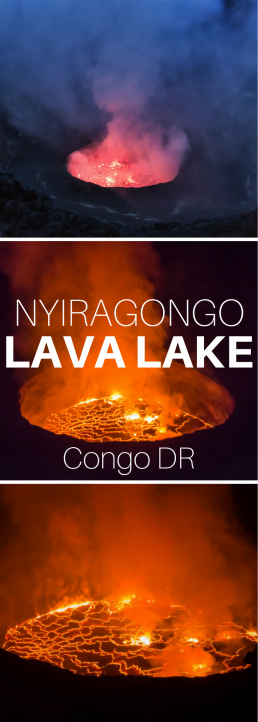
10 Romantic Destinations in East Africa
East Africa will spoil you with exquisite options for romantic getaways – from secluded beaches to private safaris and UNESCO World Heritage Sites. Pamper your sweetheart at the luxurious safari lodges, hold hands while jumping off the epic Victoria Falls Bridge, or share the magic of game drives in Africa’s best national parks. Arouse your wanderlust with our list of 10 romantic destinations in East Africa!
For the Epic Moments Together
Ngorongoro Crater, Tanzania
A morning game drive in the Ngorongoro Crater is straight from the fairytale. Even pronouncing the word Ngorongoro implies the excitement and brings memories from childhood geography books or acclaimed magazines. In Maasai language, ngorongoro means Gift of Life. Celebrate your love in one of the luxurious lodges located right on the edge of the rim, witnessing the unbelievable sunset over the caldera with skillfully prepared sundowners.
The sheer volume of wildlife makes the Ngorongoro Crater feel like a cradle of all species. Ngorongoro Conservation area is also considered as the cradle of humanity: the earliest shreds of evidence of mankind are found from the Olduvai Gorge.
Victoria Falls, Zambia & Zimbabwe
“The Seventh Wonder of the World” melts even the hearts of seasoned travelers. Adventurous couples can share the adrenaline kick of jumping off Victoria Falls Bridge and freefalling 110 meters towards the crocodile-infested Zambezi River. The activity called “Gorge Swing” lets you jump together, holding hands. The falling phase is slower – and more enjoyable – than in bungee since you just take a long step from the platform instead of jumping. After the fall, you will be swinging above the tremendous Zambezi Gorge in a sitting position with plenty of time to cuddle. The bungee and related activities appear to be surprisingly popular among honeymooners – and why not to propose in the air? Check out our separate article on Victoria Falls bungee and gorge swing to get excited!
Naturally, Victoria Falls offers also more serene romantic activities. Simply walking by “The Smoke That Thunders” is fanciful. A sunset cruise on the Zambezi River showcases the Victoria Falls from a different perspective, and as an added bonus you can spot hippos and crocodiles. Also at sunset, a steam train dating back to 1952 takes lovers cross the Victoria Falls Bridge. Then there are helicopter flights and the world-famous “Devil’s Pool”, where you can soak right on the edge of Victoria Falls! If you’d consider canoeing (pretty dangerous on the rapids) or white-water rafting on the Zambezi romantic, they’re on the list, as well.
To crown your romantic holiday in Victoria Falls, stay at the unique Islands of Siankaba. Secluded cabins are scattered among the tree canopy and connected with hanging walkways. The lodge occupies a tiny island in the middle of the Zambezi River, offering prime Zambezi views from each cabin. As Victoria Falls lies on the border of Zambia and Zimbabwe, you can enter the falls from both sides.
Bwindi Impenetrable Forest, Uganda
The third UNESCO World Heritage Site on our list, Bwindi Impenetrable Forest, is a perfect location for the adventurous couples seeking both luxurious retreat and thrilling wildlife encounters.
Bwindi is one of the last places on earth, where you can meet the rare giants of the forest – mountain gorillas. Trust me; Bwindi’s gorilla trekking experience will be among the most memorable moments in your life. If you’re looking for a truly unique proposal, do it after the sweaty hike, in the middle of a gorilla family. But remember to whisper, as you’re not allowed to speak!
Bwindi Impenetrable Forest has a handful of upscale lodges, from which we recommend the lovely Mahogany Springs. Enjoy a spectacular view straight to the hills of Bwindi Impenetrable Forest from your private terrace and cuddle in the warmth of your own fireplace – the nights are chilly in the mountains.
For Beach Lovers
Zanzibar, Tanzania
The remote Bwejuu beach resembles paradise island day-dreams with white, powdery sand and endless shades of turquoise and azure. Bwejuu has been selected among the top 30 beaches in the world by Conde Nast Traveler – we cannot disagree. There’s only a handful of hotels, and a couple of them offer intimate luxury getaways for couples.
Time travel to the era of sultans by staying at the luxurious Baraza Resort & Spa. The palace-like architecture celebrates the magic of Zanzibar and views to the turquoise Indian Ocean are so paradisiac that it’s hard to enjoy your private plunge pool when there’s whole ocean (and reef!) to explore. Check out our complete article on Bwejuu here.
Mafia Island, Tanzania
If you’re looking for a castaway romance, tiny Mafia Island caters those fantasies with crystal-clear waters and secluded beaches. The mass tourism is pleasantly absent, leaving room for rustic and romantic, “barefoot luxury” retreats. World-class snorkeling, whale shark watching and search for authentic paradise island experiences are the main reasons, which whisk couples into this crescent-shaped jewel off the coast of Tanzania.
Mafia Island Marine Park offers the highest diversity and some of the healthiest coral reefs in the Indian Ocean. Shallow reefs of Chole Bay are perfect for snorkeling and provide an exceptional variety of marine life from soft to hard corals and clouds of colorful fish. The best part is the lack of other tourists, which make the experience sublime. Check out our complete article on snorkeling in Chole Bay.
For Wildlife Lovers
Serengeti National Park, Tanzania
Another of Seven Natural Wonders of the World, Serengeti leaves you breathless. Sunsets and sunrises upon the endless plains are to die for – share them with the love of your life. Stay at one of the private tented camps, right in the middle of Serengeti and away from the civilization. Let the sounds of nature lull you to sleep, wake to the roars of lions, and sip your morning coffee watching wildlife passing by on the horizon. The game drives in the Serengeti National Park offer more wildlife sightings than you can imagine. Many people claim that this is the best place in Africa to spot the famous Big 5 – and in record time.
Masai Mara, Kenya
In Masai Mara, we witnessed the epic Masai lions mating at sunset. Can it get any more romantic?
The Serengeti ecosystem expands from Tanzania (Serengeti National Park) to Kenya, where it’s called Masai Mara. Both Tanzanian and Kenyan sides of Serengeti host the world’s biggest wildlife migration – and the most abundant lion population in Africa.
Already excited and ready to take an African safari? Check our tips on how to plan the best safari in Tanzania from here!
Lower Zambezi National Park, Zambia
Lower Zambezi is the dream destination for wildlife enthusiasts, where the abundant wildlife roams through the unfenced, luxurious safari camps. The Lower Zambezi National park is remote and unspoiled, but the lodges and guides here will make their best to spoil their guests for good.
Royal Zambezi Lodge is on our list of the safari best lodges we’ve ever visited and would be our suggestion for the romantic honeymoon splurge. The private, 5-star safari experience is honed to perfection with highly trained naturalist guides and exciting activities, intimate atmosphere and gourmet meals. Choose daily between private game drives, canoe safaris, fishing trips, sundowner cruises, bush walks, or even mountain hikes. Still, the most romantic moments are spent at your private terrace and pool, watching elephant herds slowly passing by the riverfront and plowing through the shallow waters – or taking a swim below the starry sky. Check out also our list of the best safari lodges in Zambia!
Tsavo National Park, Kenya
Split into East and West, the colossal Tsavo National Park is known as one of the largest game reserves and biodiversity strongholds in the world. The vast savannah of Tsavo East unwraps private encounters with elephants, the famous Tsavo lions and other wildlife, as there are rarely other vehicles on sight. Imagine bright red dust roads swirling between green, thorny bushes and swampy marshland, with sudden gray tones of an elephant herd peeking through the thick vegetation. The area is also rich in history, with archaeological sites dating back to Late Stone Age and the ancient Yatta Plateau, the longest lava flow in the world, which has been reshaped by erosion over the millennia.
High on stilts upon these wild plains rises Sarova Salt Lick Game Lodge, one the most photographed lodges in the world. Unique architecture lets you observe wildlife from above, as the lodge stands upon a popular watering hole. An underground passage leading to the camouflaged observation bunker just beside the watering hole put the finalizing strokes to the exceptional experience. Descend through the darkness with your loved one during the dinner time to have it all by yourselves.
Strictly speaking, Salt Lick lies inside the boundaries of Taita Hills Wildlife Sanctuary, bordering Tsavo West National Park. The sanctuary has only two lodges, both operated by Sarova Hotels.
Nairobi, Kenya
The last one took us by surprise, as well. But what would be more romantic than adopting an elephant together? Or staying at the famous Giraffe Manor, where the resident Rothschild giraffes might poke their head at your breakfast table? While Nairobi isn’t a romantic city, it’s probably on your route if you’re doing a safari in Kenya. And who wouldn’t mind a night at a classy hotel, great dinner, and a visit to the adorable elephant or giraffe sanctuary? What a perfect way to end a romantic East African safari!
Pin This Story!
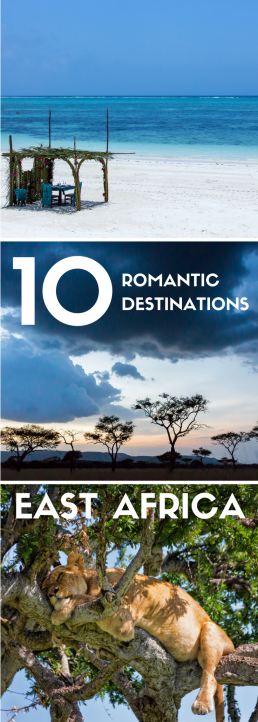
What to Eat and Drink in Kuching - And Where!
The atmospheric city of Kuching is known for its food, so why not to eat and drink your way through Bornean cuisine? Between meals, take a rest by strolling through the well-preserved Chinatown and the historic waterfront with locals – and taste small street food delicacies from the stalls if you still have a stomach left. Here comes our list of where to find best upscale, highland and street food dinners in Kuching.
Upscale Asian Fusion Dinner:
Bla Bla Bla
27 Tabuan Street
Go there for an upscale dinner that won’t break the bank. One of their signature dishes, Pandan Chicken, won our bellies. Also noodle dishes were great. Interior is just as fresh and full of flavors as the dishes: walk upon an enormous koi pond to reach your table.
Highland Jungle Food:
Tribal Stove
No.10, 1st Floor, Block H, Jalan Borneo, Taman Sri Sarawak (directly opposite Hilton)
Tiny Tribal Stove lives up to its name bringing Dayak home cooking and highland’s atmosphere into Kuching. Try traditional indigenous dishes like bamboo chicken or cheviche-like fish (or prawn) umai.
Everyone seemed to order midin, a jungle fern, so we followed the tip, and still continue to praise it. Here, midin is perfectly cooked and spiced – the best we had in Borneo. I also liked strong, spinach-like jungle vegetable called cangkok manis (star gooseberry leaves).
Cheap Local Eats:
Borneo Delight
13 Wayang St
Cheap local eats in a simple restaurant (or outdoor tables) instead of hawker stalls. If you haven’t yet tried the local favorite, Sarawak Laksa, do it now. The laksa here is sumptuous and appropriately spicy, slightly sour and sweet. Yellow noodles with curry is unordinary delicious, as well. We didn’t like ginger chicken, but all other portions tested were solid local fair.
Coffee:
Black Bean Coffee
87 Ewe Hai Street
This is your best bet for traditional Sarawak coffee, freshly roasted. Serves some solid coffee beans also from Java and traditional coffee nations. This is a local café, so don’t expect any third wave coffee snobbery, but enjoy the mellow vibes at small the terrace.
Beer:
Drunk Monkey Old Street Bar
68 Carpenter Street
The winning expat and tourist watering hole lurks inside the colorful Chinatown. Sip Guinness at the terrace under red lanterns while witnessing the night turn as dark as your pint (happy hour prices half/full pint of Guinness 13/19, Tiger comes at 12/18). Beer and whiskey selection is exceptional for Borneo and interior appropriately old school rock bar style.
If you have visited Kuching, what were your favorite restaurants or street food stalls? Share the gems with us in the comments below!
PIn This Story!
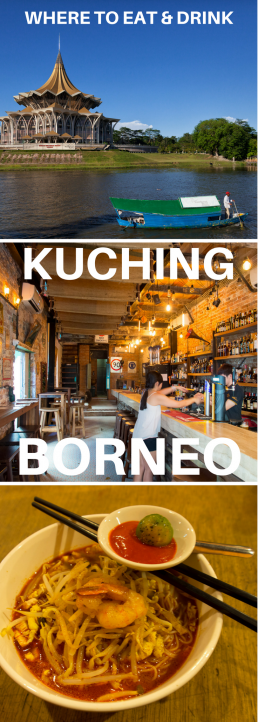
Escalators to Heaven: Visiting Independently Medellin's Comuna 13, the Former Murder Capital of the World
Comuna 13 was formerly known as a notorious slum area with the highest murder rate in Medellin. At the time, the city itself was ranked as the murder capital of the world. Today, Medellin’s Comuna 13 is growing its reputation around the world and its success story is imitated in troubled cities, such as Rio de Janeiro. Recently, a number of Comuna 13 tours have been launched, and curious tourists are trampling the colorful streets in the steps of local guides. We decided to visit Comuna 13 independently to find out what’s it all about.
The Troubled History of Comuna 13: Drugs, Gangs, and Power Struggles
Medellin’s Comuna 13 used to be controlled by gangs, paramilitary groups, and infamous drug lords. Police had no control of the area because every gang had its own lookout so that they could escape well in advance if the cops even dared to enter the neighborhood through the narrow staircases. The main highway of Medellin (San Juan Highway) penetrates the slums, lifting the cartel in charge to control all illegal import and export business of Medellin.
Pablo Escobar controlled the area in the 1980s, and other gangs fought over control after his death in 1993. The murder rates in Comuna 13 tripled during 1997-2002. Police and national security forces tried to intervene violently ten times without success.
The Tragic Legacy of Paramilitary Groups in Comuna 13
In 2002, the Colombian military led a controversial Operation Orion with an ambitious goal to clean the most dangerous neighborhood in Medellin. The result? The left-wing guerrillas – FARC, ELN, and CAP – were removed from Comuna 13. When the army, police special forces, and air forces fought over guerrillas, 100 000 inhabitants of Comuna 13 were left in the middle of the heavy combat and siege. Innocent people, including children, were killed, injured – or officially just disappeared. Only the masters changed: Operation Orion gave control of Comuna 13 to paramilitary groups, which led to paramilitary hegemony over the whole city of Medellin. Later, paramilitary leaders have confessed an ally with the police.
What about the murder rates in Comuna 13, then? Officially, things brightened up after Operation Orion. But we were told that instead of throwing corpses to the streets, they were more discreetly carried to the dump site of La Escombrera hill.
Paint, Escalators, and Communal Spirit: the Revival of Comuna 13
Then suddenly things started to change inside Comuna 13. Local government provided youngsters free paint to strengthen their sense of community and channel frustration into a creative force. Soon schools and shops followed their example. Then an architect suggested a creative public transport option to Comuna 13. The world’s first outdoor escalators were born to connect poor neighborhoods. Medellin’s outdoor escalators have since been copied by the several other cities, like Rio de Janeiro and Ankara.
On our Comuna 13 tour, we saw beautiful murals, tons of flowers, happy faces, and hope. Though we visited Comuna 13 independently, unlike most tourists, we felt safe. But, for sure, things aren’t that black and white. The official stories of the troubled past and current bloom of Comuna 13 seemed to be drastically different from the stories of locals. We recommend that you explore Medellin’s Comuna 13 on your own terms to draw conclusions.
Riding the Famous Outdoor Escalators of Comuna 13, Medellin
Medellin’s Comuna 13 is scattered upon such steep hills that it used to be accessible only by stairs. Climbing atop equals of climbing 28 stores. When the six covered outdoor escalators were assembled in 2011, the sweaty 30-minute climb was reduced to 5-minute escalator ride. What a massive improvement in life quality for more than 100 000 inhabitants – feel free to compare yourself! Our visit to Comuna 13 was blessed with scorching sun, so we opted to take the free ride. Yes, riding the outdoor escalators is totally free!
The starting point of escalators offers a splendid view towards the hills filled with red-bricked houses, speckled with occasional bright walls. Comuna 13 is still one of the most densely populated – and poorest – neighborhoods in Medellin. At the base of the outdoor escalators, you can witness how small cement and brick houses are squeezed tightly together. At the top, the corrugated iron roofs showcase the slum-like architecture. Some call Comuna 13 still a slum, but we saw it as a vibrant, quickly changing and creative neighborhood sparkling with hope and community spirit.
When you hop on the escalators, quickly passing glimpses of homes and backyards melt together into one, colorful canvas. The old cement stairway mirrors the escalators, offering a real-life canvas for both budding and famous street artists – and entertainment for visitors. Bright paint, skillful murals, and omnipresent flower pots make Comuna 13 a cheerful place to visit.
Best Photo Opportunities Near Comuna 13 Escalators
While changing escalators (or tramos aka sections), use the photo opportunities to capture changing views towards the center of Medellín– and upwards towards the hills. The landing areas offer splendid viewpoints of the surrounding street art, as well.
The escalators ascent the slope for 384 meters, so naturally, the most breathtaking views await at the top. Pose with a city view, walk around, taste the local street food, or enjoy ice-cream. Stay awhile to observe the surroundings of Comuna 13 – that’s the reason for your visit, right?
More Tips for Your Colombian Adventures
What else is on your route other than Comuna 13? Check the ultimate one-month itinerary in Colombia for inspiration on where to go after Medellin! Our route is divided into multiple one-week loops, so you can easily craft 1-6-week itineraries adjusted to your schedule and preferences.
Learn how to book cheap internal flights in Colombia and get the bargain prices as a foreigner: check our flight hacks here.
How to Get to Comuna 13 Escalators, Medellin
Good news: getting to Comuna 13 is pretty straightforward with Medellin’s public transport! The first step: take a metro from Medellin’s city center or Poblado to San Javier (metro line B). From there, you can take a bus or taxi to the Escalators of Comuna 13 (Escaleras electricas in Spanish) – or even walk.
Walking to Comuna 13 from San Javier
We chose to walk from San Javier to the escalators, as Google Maps showed the walking route and it was just 20-minute leisure walk (search Escalators Comuna 13 or Escaleras Electricas Comuna 13 in Google Maps (on Carrera 110). The starting point is located at the square/crossroads. If your map shows two destinations for the escalators, the other location marks the ending point. If you need to ask directions, just ask the way to Comuna Trece.
Getting to Comuna 13 by Taxi
A taxi trip from San Javier metro station to the base of Comuna 13’s escalators should cost the minimum (5000 pesos) or a little bit more, depending on your luck. Just wave down a taxi from the metro station.
Getting to Comuna 13 by Bus
The bus stop is in front of San Javier metro station, on the opposite side of the street. The bus line is 255. The buses even have “Escaleras Electricas” signs in their windows, so it’s super easy to just hop in. Just ask locals if you don’t find the bus stop.
Other Sights, Tours, and Adventures Near Comuna 13
The whole area around San Javier’s metro station is called Comuna 13, so feel free to explore deeper if you have time! Parque Biblioteca San Javier, a modern multi-level library and culture center, is well-worth of visiting and stands as a public sign of brighter future for the troubled area.
The best add-on tour to your independent Comuna 13 tour is riding the metrocable of Medellin from San Javier to Aurora. You only need 1-2 hours more for the return trip with the cable car and a leisure walk around Aurora to spot even more street art. Be ready with your camera in the cable car, when you slide upon all the colorful barrios!
Another exciting side adventure from San Javier is a paragliding. You can reach the best paragliding spot in Medellin easily with public transport from San Javier/Aurora. Check here our article for more juicy details on paragliding and stunning vistas of Medellin’s skyline!
Medellin has a plethora of other things to do, as well. For example, you can take guided Pablo Escobar tours, visit museums, spot Botero statues, sip the world-famous Colombian coffee in hip cafes, and hunt down even more street art. We’ll compile our favorite urban adventures in another article very soon, so stay tuned.
Is It Safe to Visit Comuna 13 and the Escalators?
The area immediately around San Javier metro station is considered safe, as are the escalators of Comuna 13. There are several policemen stationed around the escalators. Nowadays, several tour groups visit the area during the daytime. Although our hotel advised against visiting Comuna 13 independently, many locals claim it safe. Still, even locals advise against wandering too far from the escalators, where security guards patrol. Chat with the guards and ask their opinion before exploring the area outside the escalators. Don’t take unnecessary risks.
Though our independent visit to Comuna 13 was safe and sound, I cannot guarantee that yours will be – please ask the current security situation from locals. If you are advised against going to Comuna 13 on your own, please consider taking a guided Comuna 13 tour (there are also private tours available).
Please note that Medellin’s Comuna 13 is still low economic zone. Visit the San Javier area only during daylight hours. Preferably, do not go alone to Comuna 13: take a guided tour if you don’t have company. While homicide rates have sunk, street robberies are more than common. Watch your belongings and don’t carry expensive cameras or other valuables if you decide to wander further from San Javier metro station or the escalators of Comuna 13.
Crime in Medellin 2018: Security Update for Visiting Comuna 13 in 2019
Crime rates in San Javier and Comuna 13 have unfortunately risen during 2018. Already during spring 2018, media reported that criminal groups had become more active in San Javier area and some other comunas of Medellin, like neighboring Robledo. Thus, additional police officers are patrolling the streets of Medellin.
On July 8th, four gang-related homicides were reported in Comuna 13, lifting the yearly murder rate to 44. Currently, more than 30 gangs operate in Comuna 13. Most of the gangs report to Oficina de Envigado, a drug cartel and criminal organization that used to be an enforcement wing of Pablo Escobar’s Medellín Cartel. Once again, community members claim that latest police operations in Comuna 13 haven’t been that legit, and there might, once again, be alliances between police and the gangs.
Despite the nightly clashes and gunfights, Comuna 13 remains as a growing attraction for tourists interested in street art and urban renewal. Visiting Comuna 13 is still relatively safe during the day. Again, please ask locals the current security situation before planning your visit.
Have you visited Medellin’s Comuna 13 and the escalators – or would you dare to explore the area around San Javier on your own?
Pin This Story!
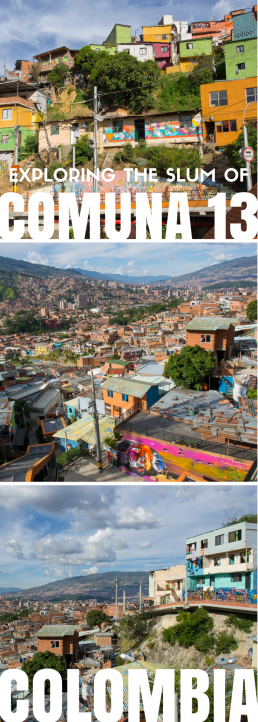
11 Unmissable Things to Do in Sepilok: Perfect Introduction to Borneo!
The tiny town of Sepilok offers an exciting prelude to the orangutans, sun bears, and rainforests of Borneo – in just two days. Get inspiration for your Bornean adventures from our favorite things to do in Sepilok!
Are you planning to stay in Sandakan or Sepilok but wondering what to do there? Worry no more, Sepilok’s world-famous sights and day trips to the surrounding areas could keep you busy for one week! You can go hiking or paddling; visit orangutan, proboscis monkey, and sun bear sanctuaries; take a boat to Kinabatangan River or the paradise islands; or visit the biggest cave system in Sabah – just to mention a few highlights. Read on to create your own 2-5-day itinerary to Sepilok and the surrounding Sabah area!
1. Visit Sepilok Orangutan Rehabilitation Centre
Get Familiar With Orangutans – and Their Babies!
Thanks to Orangutan Rehabilitation Centre, Sepilok is the world-famous place to meet the orange-furred “men of the jungle”. Around 60 to 80 orphaned or injured orangutans live freely inside a slice of protected forest reserve.
The best thing: caretakers will bring the babies and adolescents to the outdoor nursery are just before the feeding times. You can watch mini-orangutans tumble, fight and play behind the glass of the air-conditioned observatory. Cuteness overload!
Adult sightings are not guaranteed, as the semi-wild orangutans move around freely, but here the chances are the best on earth. Daily morning and afternoon feedings in Sepilok’s Orangutan Rehab seemed to draw so many orangutans to the feeding platforms that I could only think that torrential rain might keep them in the shade of the canopy.
Double your chances by visiting both feeding sessions (entrance fee covers the whole day) and arrive well in advance. We stumbled upon orangutans while just walking around on the elevated pathways before the feeding time. Boardwalks link the entrance, feeding platform, and outdoor nursery.
2. Visit Bornean Sun Bear Center
Meet the Smallest Bears on Earth: the Sun Bears
Bornean sun bears are among the cutest animals we’ve ever met. These black-furred, Paddington-sized bears have golden, horseshoe like marks on their chest, which resemble rising sun. The markings are unique, just like human fingerprints.
It’s your lucky day, as Sepilok is again the best place on earth to observe rescued sun bears climbing trees, grubbing ground in search of food, and minding their own business. Check out our separate article about visiting Bornean Sun Bear Center!
3. Hike, Paddle, and Spot Wildlife in Sepilok’s Rainforest Discovery Center
Take a Hike in the Bornean Rainforest
Some lodges in Sepilok have private walkways in the rainforest, but you can also have your introduction to the rainforests of Borneo at Sepilok’s Rainforest Discovery Center. They even have a 350-meters long canopy walkway, from where you can explore what happens in a rainforest at the level of the treetops. There’s also a network of walking trails and paddle boats to rent by the shore.
I’d highly recommend a mini-hike inside Sepilok’s orangutan sanctuary if any of the walking trails happen to be open (all trails were closed at the time of our visit until further notice). The loops vary from 250 meters to 5 kilometers.
4. Enjoy Evening Drinks With Giant Flying Squirrels
Sepilok’s Best Place to Observe Giant Flying Squirrels
We were lucky to see plenty of giant flying squirrels during our Bornean adventure. After a numerous night walks, night drives and cruises at several locations, I confess with laughter that the best spot to watch these giants show off was our lodge’s terrace in Sepilok.
Flying red giant squirrels nest in a massive tree just beside MY Nature Resort. Restaurant’s terrace is aptly called the flying squirrel terrace, as it offers impeccable chances to observe these giants climb the tree and then glide upon you. Waiting for the squirrels to show off is evening entertainment at its best, accompanied by mouth-watering fried bananas.
The creatures are truly giant: from tail to head almost one meter. We got to see a perfect example of their skills, when one squirrel flew over us and the restaurant, arguably almost the 150 feet distance, which they are able to cover on one flight.
5. Spend a Day in Sandakan
Indulge in Urban Treats and Restaurants of Sandakan
After all the praise, the downside of Sepilok is the lack of town. There’s virtually just a highway crossing an area called Sepilok with a handful of lodges scattered around the highway and nearby orangutan and sun bear sanctuaries.
Luckily, a small coastal town of Sandakan lies just 30 minutes away by a taxi or bus. The center of Sandakan has some nice restaurants and cafes – we’ll publish soon a guide on the best restaurants in town! English Teahouse up on the hills is a pleasant spot to idle an afternoon away while gazing to the turquoise ocean.
6. Take a Kinabatangan River Cruise
Spot Wild Orangutans in Kinabatangan River on One-Day or Multi-Day Cruise
Sepilok acts as a gateway to the jungle explorations and cruises on Kinabatangan River. If you’re short on time, take a day cruise. For the best chances to see orangutans and pygmy elephants, we recommend at least 2-night/3-day Kinabatangan cruise. If you’re lucky, it’s still possible to see nosy proboscis monkeys and a couple of orangutans on a day cruise.
Get inspiration for your adventures from our separate article about Kinabatangan river cruise.
7. Visit Labuk Bay Proboscis Monkey Sanctuary
The Best Place in Sepilok to See Proboscis Monkeys
It would be a shame to leave Borneo without seeing the iconic proboscis monkeys (Nasalis larvatus). Guarantee your chances to spot these funny looking, pot-bellied creatures by visiting Labuk Bay Proboscis Monkey Sanctuary during feeding times (9.30AM, 11.30AM, 2.30PM, 4.30PM).
8. Take a Day-Trip to Sandakan Archipelago
Off-the-Beaten-Path Paradise Islands
Arrange a boat at Sandakan wharf and explore Sandakan Archipelago on your own. Selingan, Gulisan, and Bakungan Kecil are part of Turtle Island National Park, where you can witness hawksbill and green turtle hatching. Head to Berhala Island (Pulau Berhala) for sunrise. The stunning sandstone cliffs and boulders of Berhala have also decent rock climbing routes.
9. Marvel Puu Jih Sih Temple – And the Views!
Admire a Sunset Above the Sulu Sea
If you decide to do a day trip to Sandakan, end it in style. Puu Jih Sih Temple is among the finest Chinese temples in Sabah. The best news: it’s whisked on a hill and has a nice panorama over Sandakan’s coastline, which makes it a prime sunset watching spot.
10. Eat Seafood at Sim Sim Water Village
Old-Style Fishing Village upon Wooden Stilts
Sim Sim Water Village is among the best places to eat fresh seafood with locals. The cheerful wooden stilt houses are connected with wooden platforms. Sim Sim Water Village is located 3 km off Sandakan on Jalan Buli Sim Sim: drive through it on your way back to Sepilok.
11. Visit Gomantong Caves
Ancient Caves Filled With Bats, Birds, And Cockroaches
If the subtitle doesn’t spook you off, Gomantong caves make an exciting day trip from Sepilok or Sandakan alike. The magnificent, cathedral-like main chamber is featured in many travel magazines; it’s photogenic indeed. The cave system goes deep inside Gomantong Hill and could be explored for a full day. If you don’t have your own wheels, take a taxi for the day or combine Gomantong caves with your Kinabatangan River adventure.
Where to stay in Sepilok?
We chose MY Nature Resort for three reasons. Shortly: here you’ll experience the best that Sepilok has to offer in a unique way, with some added perks. The lodge is new and has the only pool in Sepilok (for now).
Elevated pathway loops the back of the resort, offering mini jungle excursions into Sepilok Protected Forest Reserve. You’re free to explore the 1500 ft route on your own from 6 AM to 5 PM, and every night there’s an option for a guided night walk. At the time of booking, we didn’t know about the squirrels, but would recommend staying in MY Nature Resort even for the flying red giants!
MY Nature Resort is tucked away from the Sepilok highway, where most of the lodges lie. It’s a short walk from Rainforest Discovery Center, the third draw in Sepilok after the orangutans and sun bears. The accommodation package includes tickets and guided tours of orangutan and sun bear sanctuaries and shuttle transfers from the hotel (twice a day, just 5-minute ride). You’ll also get an own guide who can lead nearby nature walks. Complimentary drinking water and always hot water thanks to the backup generators. Our cottage had a huge, private terrace overlooking the rainforest canopy – ask for a view!
Are you looking for other superb lodges in Borneo? Check our list of the best places to stay in Malaysian Borneo!
How to Get to Sepilok, Borneo
Sepilok is located in North-Eastern Sabah, the state of Malaysian Borneo that occupies the northern tip of Borneo. Sandakan is the nearest bigger city.
Multiple daily flights cut the distance between Kota Kinabalu and Sandakan into 45 scenic minutes. You’ll fly past Mt. Kinabatangan and weather-permitting the peak is fully visible. Be sure to book left side seat from Kota Kinabalu to Sandakan – and vice versa! One-way prices start at 13$ (AirAsia). Taxi drive from Sandakan to Sepilok takes less than 30 minutes.
Also, local buses run frequently the routes Kota Kinabalu–Sepilok and Sandakan–Sepilok. But you have to jump off by the highway at ´Batu 14´, (Sepilok doesn’t have a center, so you’d need a taxi from Batu 14, and it can be expensive).
Sepilok Vs. Sandakan: Why We Recommend Making Sepilok Your Base in Eastern Sabah
We encourage you to make Sepilok your base in the Eastern Sabah instead of the bigger Sandakan. Why? In Sepilok you’re closer to the areas main attractions: it’s just a short walking distance from all lodges to both orangutan and sun bear sanctuaries and Rainforest Discovery center. In Sepilok, you’ll be also closer to the jungle. Some of Sepilok’s lodges are inside the rainforest, with good chances to spot wildlife, whereas in Sandakan you’ll be staying in a soul-less city hotel.
You can do all the exciting day tours to the surrounding area either from Sandakan or Sepilok; the towns are just 30-minute drive from each other. However, if you have already chosen to stay in Sandakan over Sepilok and are wondering about the best things to do in Sandakan: the list is the same as in Sepilok!
Where in Borneo to Continue From Sepilok?
It’s easy to continue your adventure from Sepilok to Kinabatangan River. We also highly recommend a paradisiac stay on the gorgeous Lankayan Island, snorkeling with turtles and exploring the mesmerizing underwater world. Check out our ultimate 2-week itinerary from the beaches to the rainforests of Borneo for inspiration!
Special thanks for S.I. Tours for helping us to arrange our visit to Sepilok, Borneo.
Have you been in Sepilok or would you love to meet the orangutans and the sun bears someday?
Pin This Story!
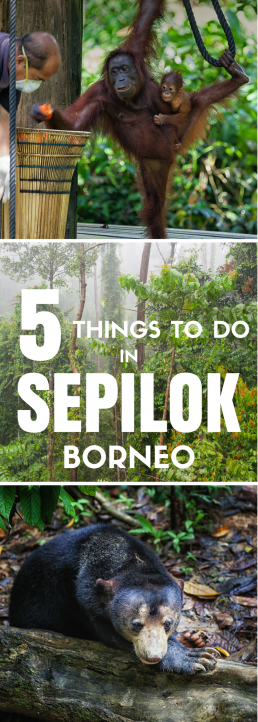
Where to Stay in Borneo: Best Rainforest Lodges, Beach Resorts, and City Hotels in Malaysian Borneo
Are you wondering where to stay in Borneo for the most authentic experiences? We list the best rainforest lodges, quirky boutique hotels, and all-inclusive beach resorts in Borneo. Spot orangutans in misty rainforests, swim with turtles on paradise islands, and enjoy the colonial cities – while staying in carefully vetted hotels that won’t let you down. We have hotel recommendations to all budgets, from mid-range boutique hotels to the most luxurious lodges in Borneo, and amazing budget accommodation options when available.
THE BEST LUXURY RAINFOREST LODGE IN BORNEO
Borneo Rainforest Lodge, Danum Valley (Malaysian Borneo)
The award-winning Borneo Rainforest Lodge is the most luxurious eco-lodge in Borneo. It’s always ranked among the best wildlife lodges in Asia.
Borneo Rainforest Lodge is also the only lodge in Borneo, which lies inside primary rainforest and conservation area. You’ll be surrounded by the vast, untouched rainforest, where no modern man has stepped. Think of ultimate luxury and seclusion combined with unique nature excursions with a personal naturalist guide. I’d pick Borneo Rainforest Lodge for our “10 Luxury Hotels to Stay Before You Die” list.
The Best Wildlife Lodge in Borneo
Obviously, Borneo Rainforest Lodge is the best spot in Malaysian Borneo for authentic wildlife sightings. Hiking is allowed on private trails, which can take you to mesmerizing waterfalls, natural jacuzzi pools, dizzying viewpoints, and an ancient burial site. It’s possible to trek for a whole day chasing wildlife in their natural habitat.
If you’d love to spot orangutans in their natural habitat, check this article for finding the best orangutan areas in Borneo.
If you are planning a trip to Borneo, check out our detailed 2-week itinerary for inspiration!
What We Love About Borneo Rainforest Lodge
The varied all-inclusive activities are the best part of staying in Borneo Rainforest Lodge. We loved our early morning walks (up to 4 hours) and were lucky to spot several orangutans. In addition to various trails, you can swim and tube down the clear waters of Danum River, take night safari drives, or just admire the unique views towards the home of truly wild orangutans.
Don’t forget to visit the breathtaking canopy walkway, which has multiple viewing platforms! It’s simply the best canopy walk we’ve ever stepped on – and you can experience it in the privacy of your own hiking group. Check out the complete guide on visiting Borneo Rainforest Lodge and Danum Valley!
The Rooms of Borneo Rainforest Lodge
Borneo Rainforest Lodge has only 30 villas, built with locally sourced and sustainable materials. Deluxe chalets open to the ravishing Danum river (with private jacuzzis!), whereas standard rooms face the rainforest with the best chances of spotting wildlife from the comfort of your bed. Orangutans had nested right above our cabin just a day before we arrived!
Borneo Rainforest Lodge is continuously ranked as the best lodge in Borneo. If you’re planning a luxury holiday in Borneo, be sure to include Borneo Rainforest Lodge into your itinerary! Click here to get inspiration for planning an itinerary in Sabah.
How to Get to Borneo Rainforest Lodge (Danum Valley)
All-inclusive rates of Borneo Rainforest Lodge cover 2-hour transfers from Lahad Datu (the nearest town and airport) – and daily activities with a professional naturalist guide. Driving through the vast secondary rainforest bordering the conservation area is an adventure as well: we spotted the rare Bornean pygmy elephants on both drives!
The Rates of Borneo Rainforest Lodge and How to Book Your Room
You can book your stay in Borneo Rainforest Lodge on their website or through your Bornean tour company. All-inclusive rates for a 3-day/2-night package in a standard double room start at $1100 per person.
BEST MIDDLE-RANGE RAINFOREST LODGES
Kinabatangan Riverside Lodge & Borneo Nature Lodge, Kinabatangan River (Malaysian Borneo)
It’s hard to pick the best lodge in Kinabatangan River, which snakes for more than 500 kilometers from the Sulu Sea, through rainforests towards the mountains and “the lost world” of western Sabah. One of the richest ecosystems in the world is home to orangutans, proboscis monkeys, and countless of other exotic species – even the elusive pygmy elephants. Most of the rainforest lodges in Kinabatangan River are clustered around the village of Sukau, where wildlife sightings are great, but constant boat traffic hinders jungle daydreams.
Option 1: Affordable & Authentic Tour Package in Kinabatangan River
If you have at least two nights to spare in Kinabatangan and yearn to experience the real magic of rainforest, book 2-day/3-night or 3-night/4-day Kinabatangan package that includes two separate lodges (and locations). We explored Kinabatangan with SI Tours staying in Abai and Sukau villages.
Start your exploration by cruising from the port of Sandakan to the mouth of Kinabatangan river. Glide quietly downstream while spotting wildlife in the thick vegetation hanging over the river, stopping to admire a herd of proboscis monkeys or even orangutans if you’re lucky. Spend a night at the simple Abai Jungle Lodge upstream. There are no roads and no other tourists in sight, just fairytale river vistas. Take private walks with your loved one on the elevated pathways at the back of the lodge and share the experience of living inside a National Geographic document.
The next day, wake early to sip coffee admiring the magical morning mist upon the river. Take a cruise to the Pitas Oxbow Lake spotting wildlife and zigzagging through a narrow channel and strangling fig-trees. Enjoy an exclusive jungle breakfast in the company of macaques and wild pigs. To experience all that Kinabatangan River can offer, cruise all the way down to Sukau village and spend the other night in the eco-chic Kinabatangan Riverside Lodge.
We loved the true wilderness feel of Abai Jungle Lodge. Combining it with Kinabatangan Riverside Lodge made our Kinabatangan River adventure just perfect. During our transit day from Abai to Sukau, we saw 6 orangutans and a herd of rare pygmy elephants! Both lodges have gorgeous terraces overlooking the river and private, elevated pathways for exploring the jungle. Kinabatangan Riverside Lodge is considerably better, or more upscale, than more simple Abai Jungle Lodge. But deluxe rooms in Abai Jungle Lodge are nice enough for one night stay, and the location is more serene than Sukau area.
Option 2: All-Inclusive Resort in Sukau: Borneo Nature Lodge
If you’re looking for a relaxed Kinabatangan River exploration, book all-inclusive stay in Borneo Nature Lodge.
How to Get to Sukau and Abai Villages in Kinabatangan River
The best and the easiest way to reach Kinabatangan River from Sandakan is to take a tour or book all-inclusive rainforest lodge. In theory, you can get either drive or negotiate a transfer to Sukau village and most lodges offer cruises. There are no public boats. We loved to explore the Kinabatangan River from its mouth to all the way to the Sukau and Bilit areas – one of the advantages of taking a guided tour and staying at two separate Kinabatangan lodges.
OTHER GREAT MIDDLE-RANGE RAINFOREST LODGES IN SEPILOK
1. MY Nature Resort, Sepilok
MY Nature Resort was our first jungle lodge in Borneo, offering just a perfect introduction to the treats of the rainforest. MY Nature Resort is tucked away from the other lodges and the Sepilok highway, offering an authentic jungle feel. Still, it’s a short walk from Rainforest Discovery Center, the third draw in Sepilok after the orangutans and sun bears.
The additional perks: the property is new and has the only pool in Sepilok (for now) and you are free to explore the surrounding rainforest on the elevated pathways. Flying giant squirrels show off at the restaurant’s terrace every evening: watching them glide past while munching fried bananas is evening entertainment at its best! Our cottage had a huge, private terrace overlooking the rainforest canopy – ask for a view.
The accommodation package includes tickets and guided tours of orangutan and sun bear sanctuaries and shuttle transfers from the hotel (twice a day, just 5-minute ride). You’ll also get own guide who can lead nature walks.
2. Sepilok Nature Resort
Another excellent option for mid-range rainforest lodge in Sepilok is gorgeous Sepilok Nature Resort. The atmosphere is mesmerizing: Nature Lodge Sepilok stands by a lovely pond, surrounded by lush rainforest: You can hear the animals to your beautifully decorated room. Each room has a terrace for observing the rainforest. Check their best rates here!
How to Get to Sepilok & What To Do There
Getting to Sepilok is easy: just fly into nearby Sandakan from Kota Kinabalu or take a bus. Taxi from Sandakan takes less than 30 minutes.
Planning to include Sepilok in your holiday in Borneo? Check out the best things to do in Sepilok for inspiration!
BEST LUXURIOUS ALL-INCLUSIVE BEACH RESORTS
1. Lankayan Island Dive Resort, Lankayan Island
While most other islands in Borneo are already crowded, Lankayan remains a remote paradise for snorkelers and divers, or anyone seeking a secluded tropical island. Lankayan has just one exclusive dive resort and blissfully empty stretches of powdery sand. I can happily rank Lankayan Island Dive Resort among the best dive lodges in Borneo.
On Lankayan, the Sulu Sea glimmers in the most perfect shade of turquoise, mixing with the hues of blue, inviting you for a refreshing dip. Float quietly to witness the paradisiac scene, wondering if you’re really there, before exploring the underwater treasures, which include healthy reefs, clouds of colorful fish, playful turtles and exciting rarities like jawfish.
In Lankayan Island Dive Resort, you can feed you Robinson Crusoe fantasies with all the modern comforts. All the cottages are right on the shore. We stayed in #25, the second last one, which stands on stilts, both upon water and sand, and boasts unobstructed views of the turquoise ocean. For the ultimate win, I’d recommend #26, but in Lankayan, you always win. Here you can read our separate article on snorkeling in Lankayan Island.
Both Lankayan Island Dive Resort and previous Borneo Rainforest Lodge are listed as the best all-inclusive resorts in Borneo.
How to Get to Lankayan Island Dive Resort
Fly, drive or take a bus to Sandakan, a coastal town in Sabah area of Malaysian Borneo. The all-inclusive rates of Lankayan Island Dive Resort include transfer from the airport or Sandakan city to the port and 1,5-2 hours’ speedboat trip to Lankayan Island.
2. Pom Pom Island Resort
Another jewel slightly away from the bustle of Sipadan is exquisite Pom Pom Island Resort. It shares many of the superlatives with Lankayan: Pom Pom is a hidden gem away from the crowds. The best thing: You can do snorkeling and diving trips to the world-famous Sipadan!
Check the best all-inclusive rates for the villas of Pom Pom Island Resort from here!
How to Get to Pom Pom Island
Pom Pom Island is a 45-minute boat ride away from the town of Semporna. Rates of Pom Pom Island Resort include boat transfers between Semporna and Pom Pom Island and airport transfers from Tawau to Semporna (1-1,5 hours).
THE BEST CITY HOTELS IN KOTA KINABALU
1. The Best Luxury Hotel in Kota Kinabalu: Shangri-La Tanjung Aru Resort & Spa
Shangri-La is a legend in Borneo. Technically, it’s not a city hotel, as it’s 7 kilometers (and 10 minutes by car) from the center of Kota Kinabalu. If you’re arriving in Borneo after a long-haul flight, I’d book an ocean view room in Shangri-La just to unwind. This huge resort is just 7 kilometers from the airport and offers seven restaurants, beach, gigantic pool, and day tours to Tunku Abdul Rahman Marine Park (which is just 10-minute boat ride away).
Check the best rates for Shangri-La Tanjung Aru Resort here.
2. The Best Affordable City Hotel in Kota Kinabalu (Mid-Range): Grandis Hotel & Resort
Grandis is our choice for the best value mid-range city hotel in Kota Kinabalu. The location is excellent and rooms come with stunning ocean views. It’s a solid no-frills kind of city hotel, where you will sleep well.
Room rates of Grandis are roughly half of the Shangri-La’s rates and the location is better for those who’d like to explore the city instead of relaxing by the beach.
THE BEST CITY HOTEL IN KUCHING
Ranee Boutique Hotel
Ranee Boutique Hotel is without a doubt the best hotel in Kuching. Without any competitors, it wins both the luxury and affordable boutique hotel categories. The location is perfect for exploring the waterfront, center and Old Town of Kuching, yet the rooms are quiet.
The Ranee has 24 unique rooms in an old colonial shophouse dating back to the 19th century. Check the best deals here.
If you have visited Malaysian Borneo, which were your favorite lodges and why?
Pin This Story!
